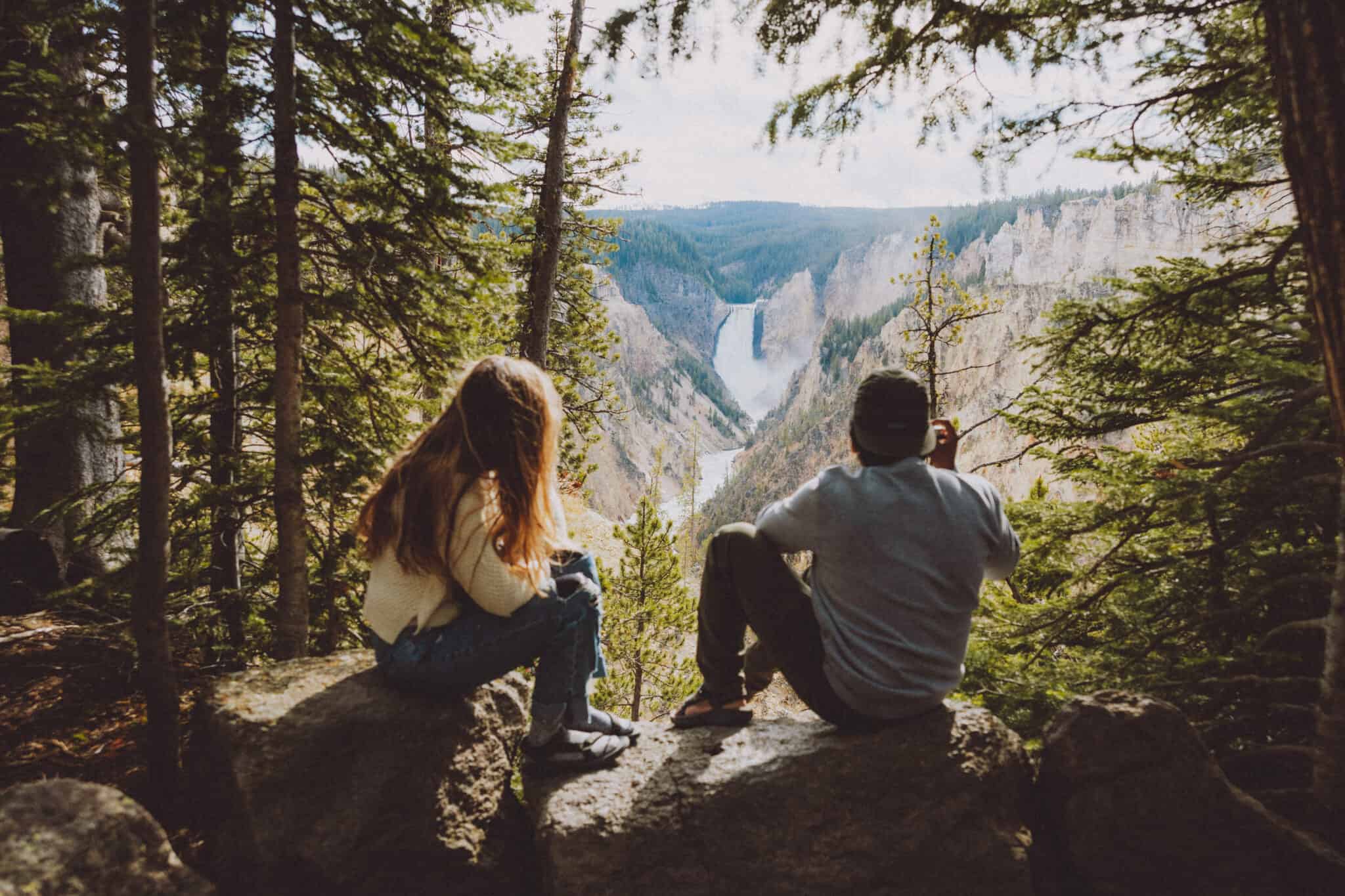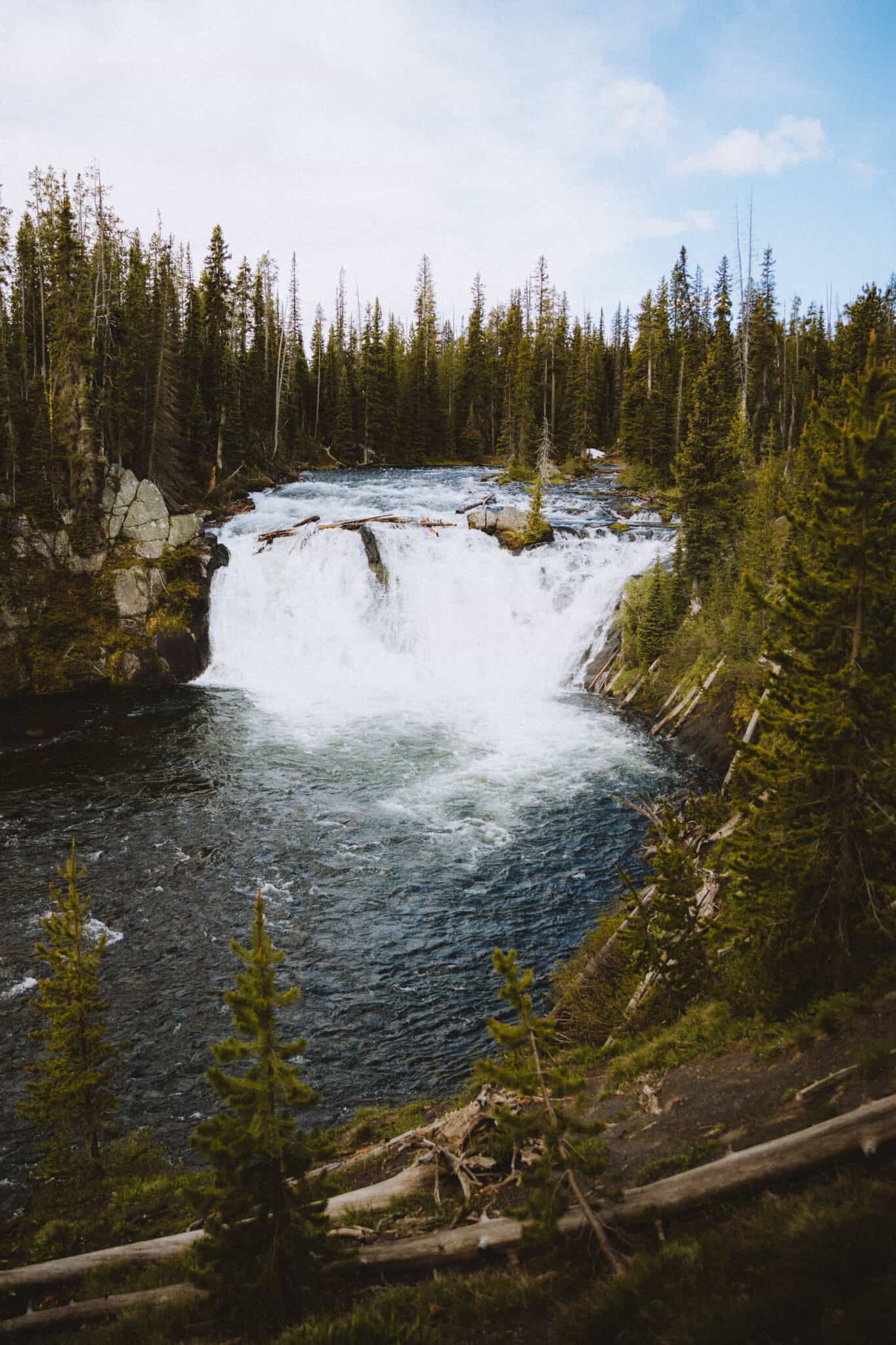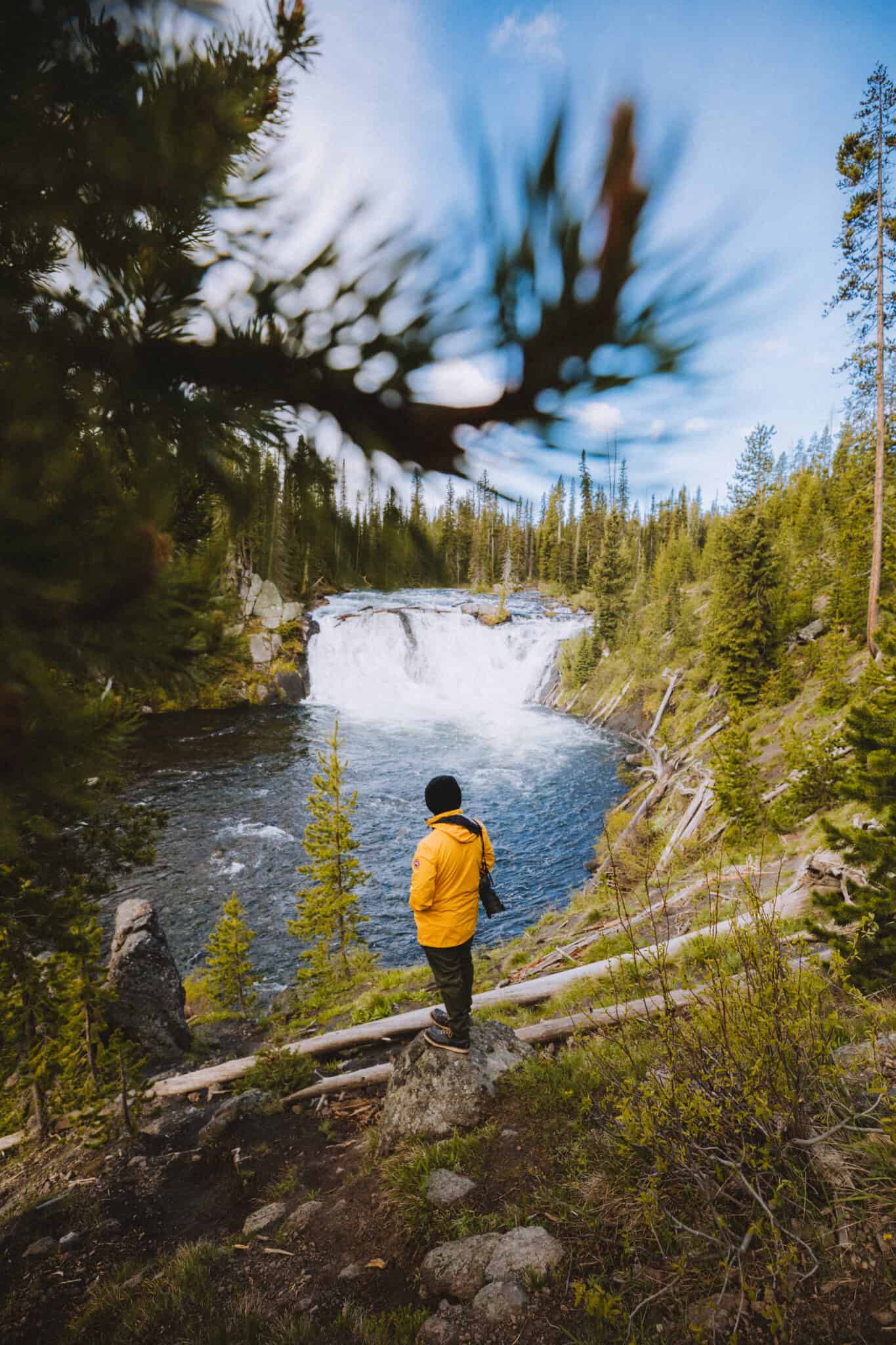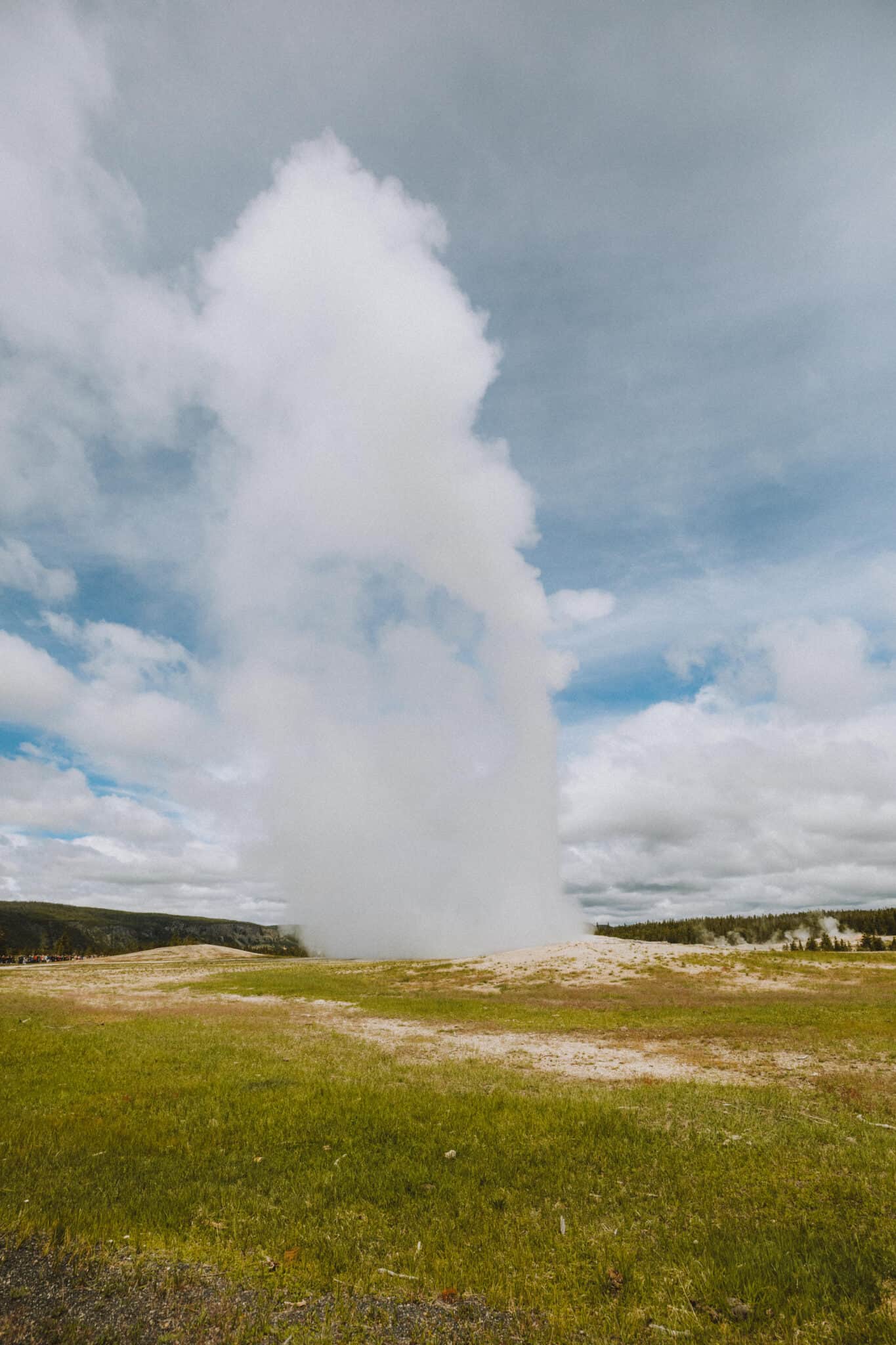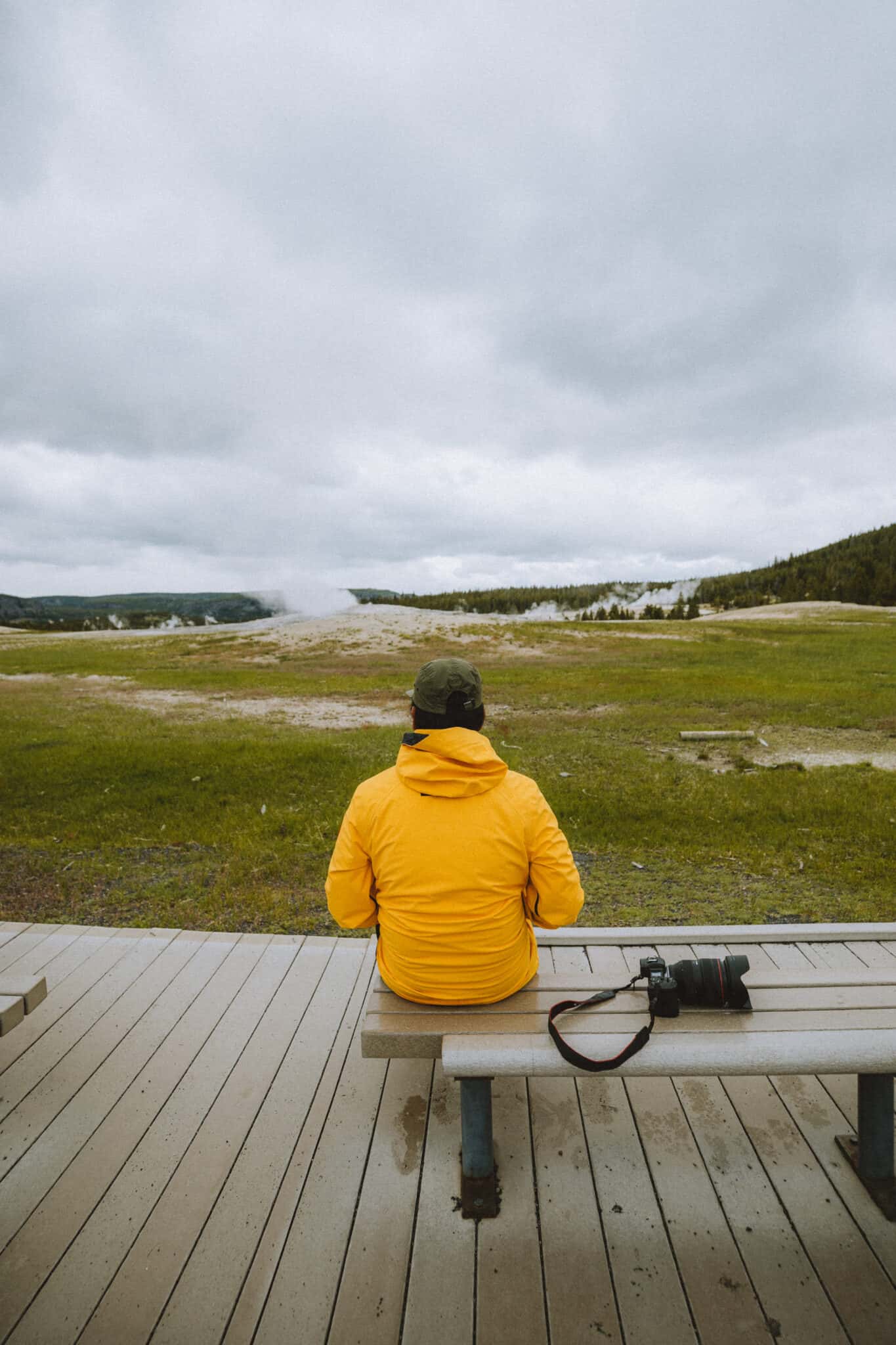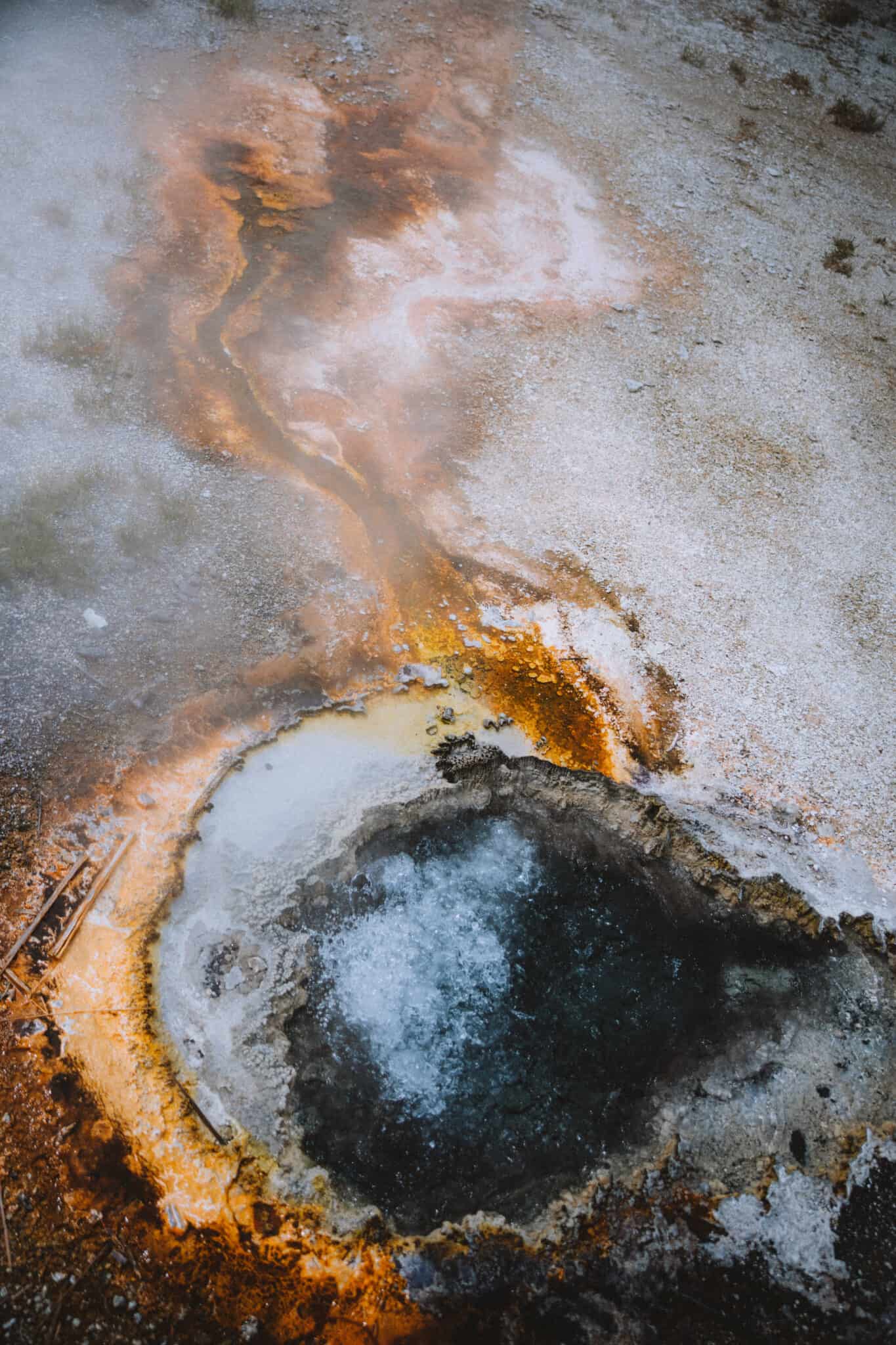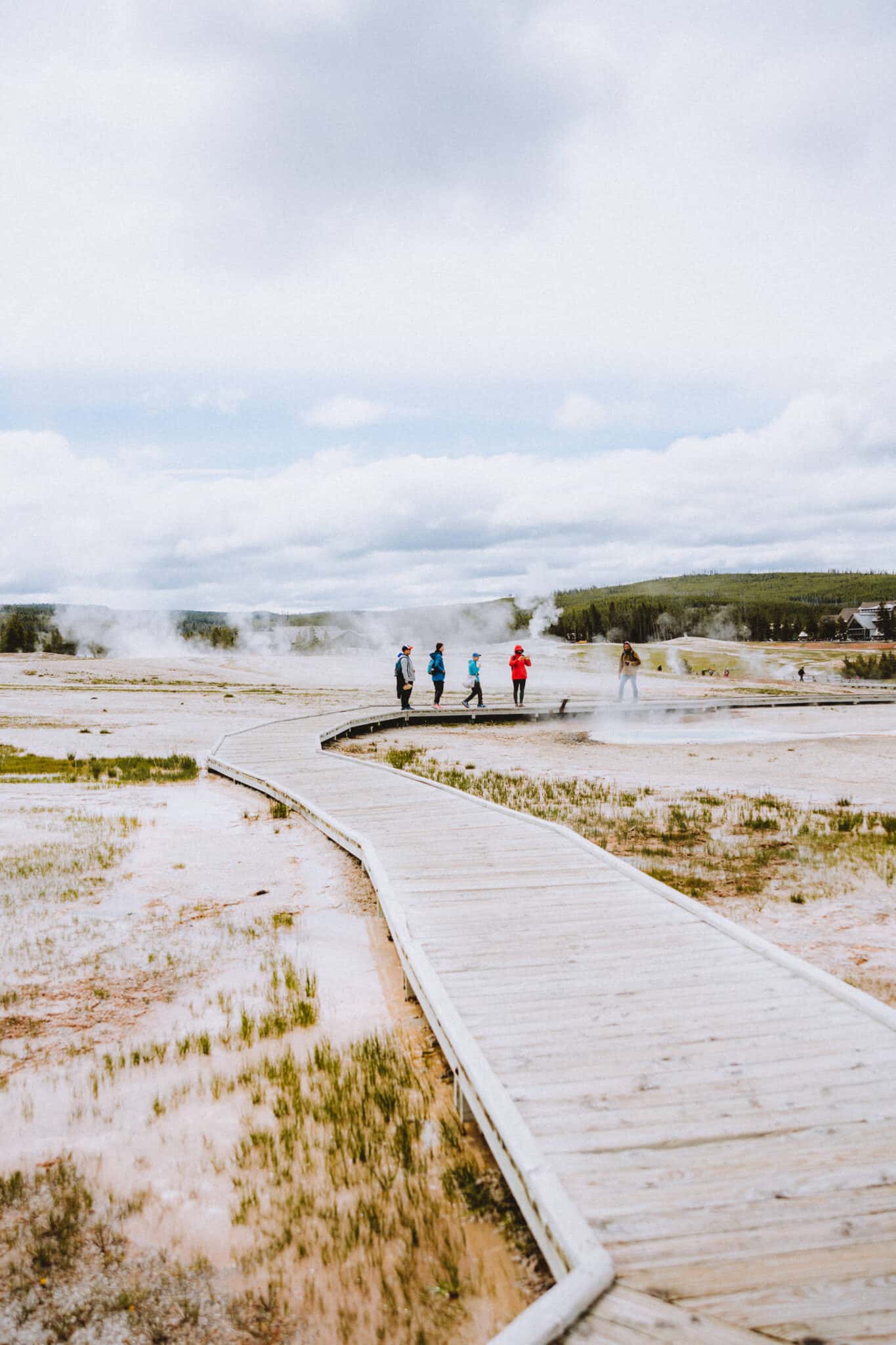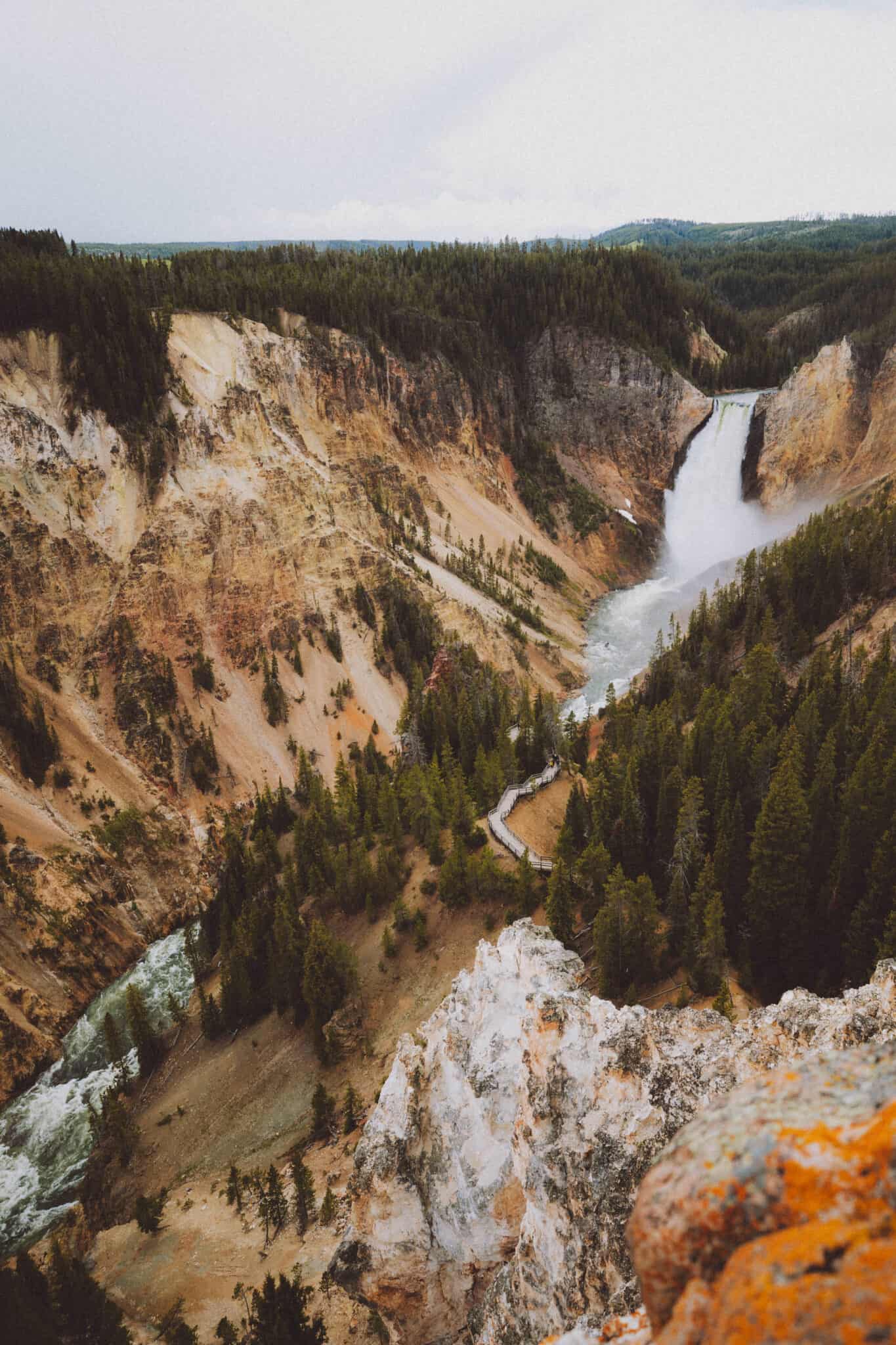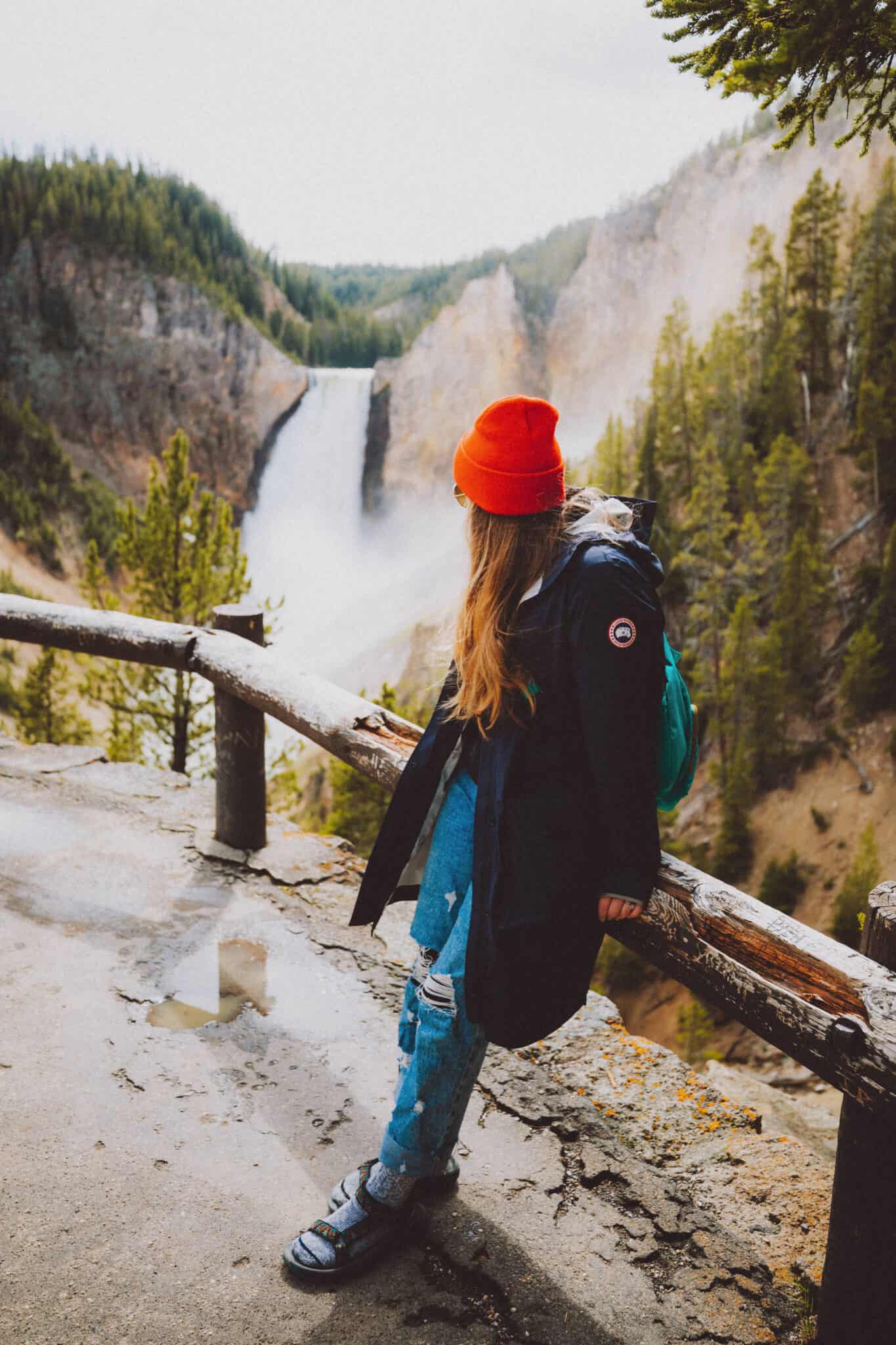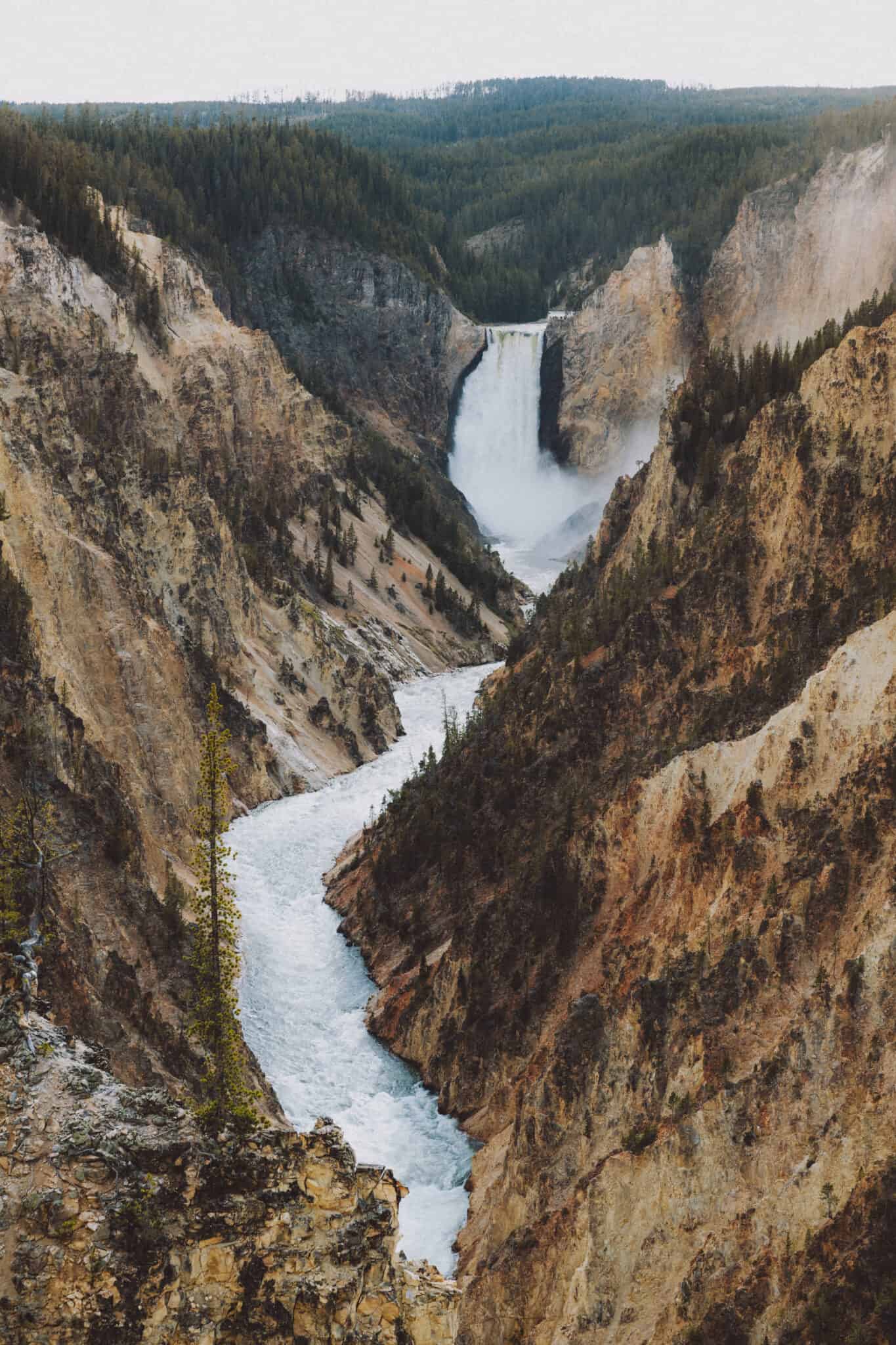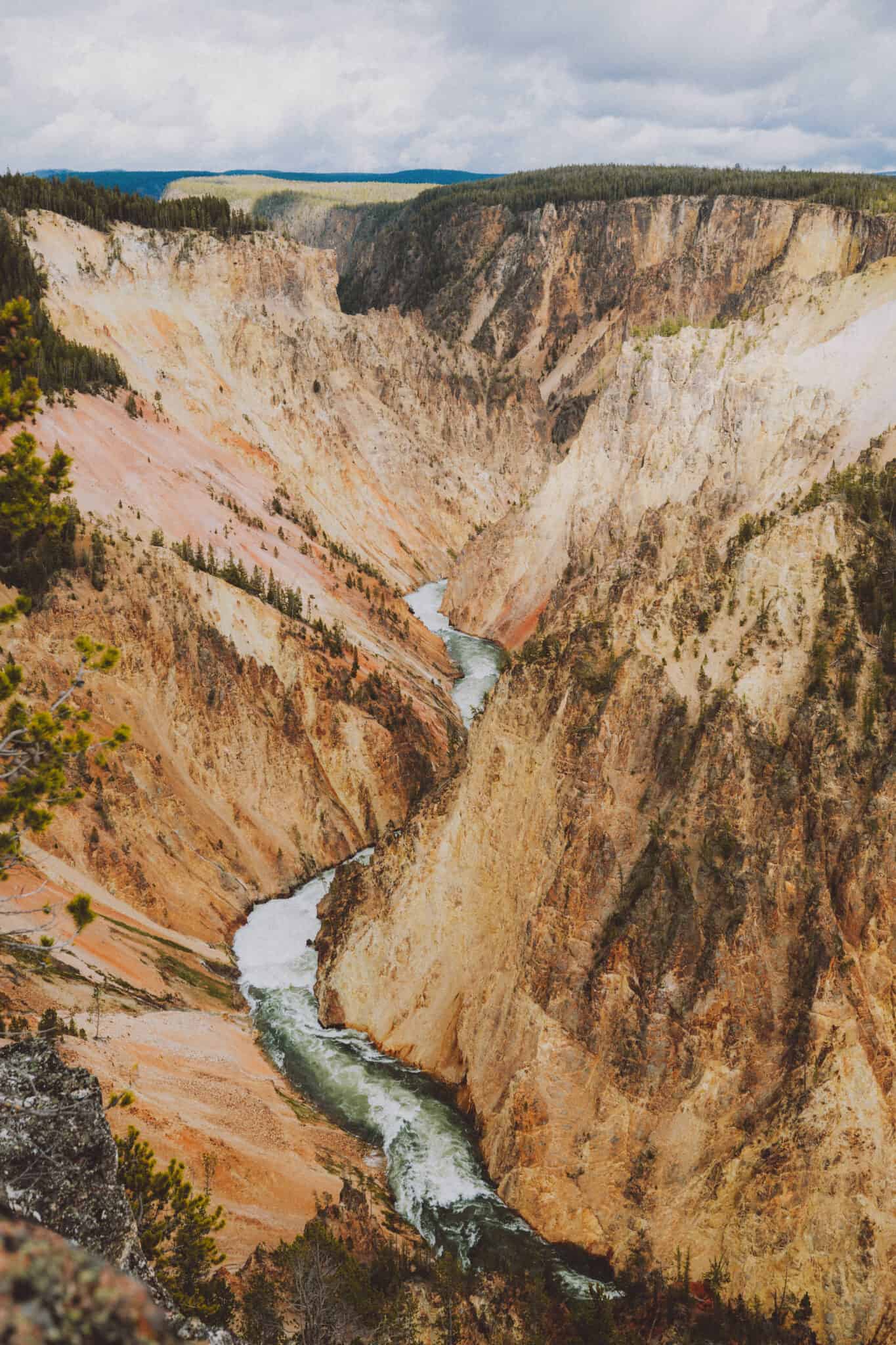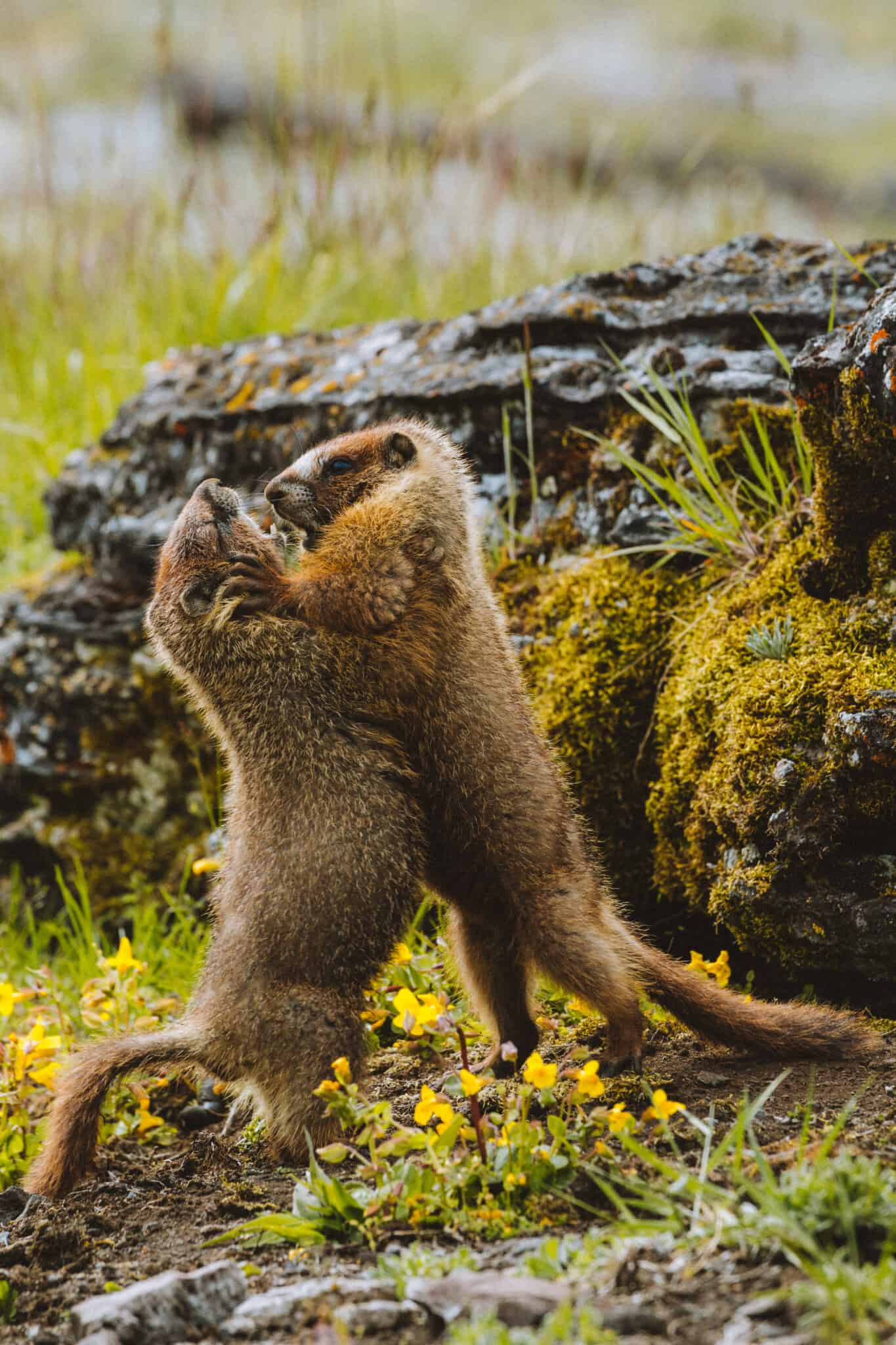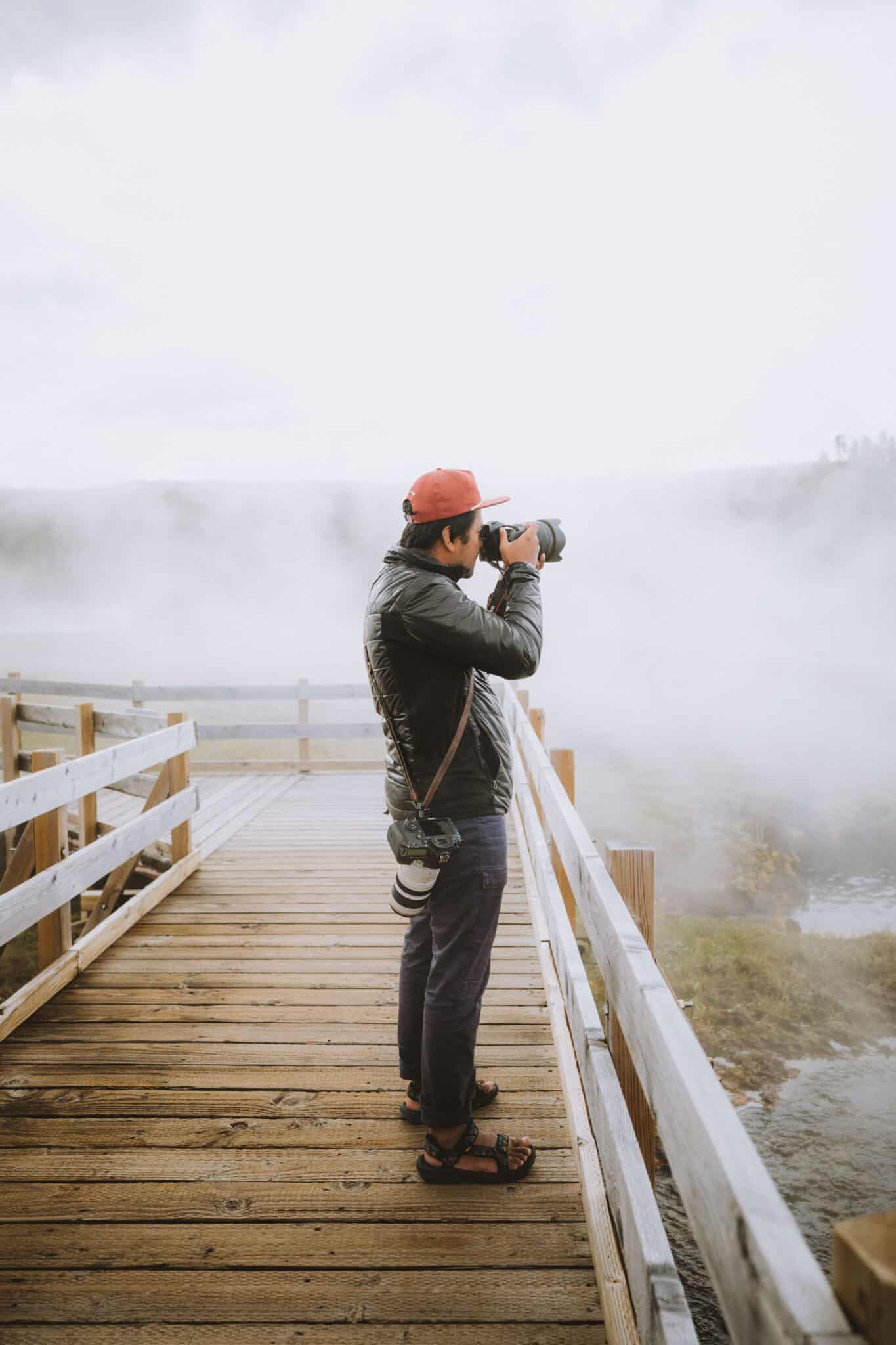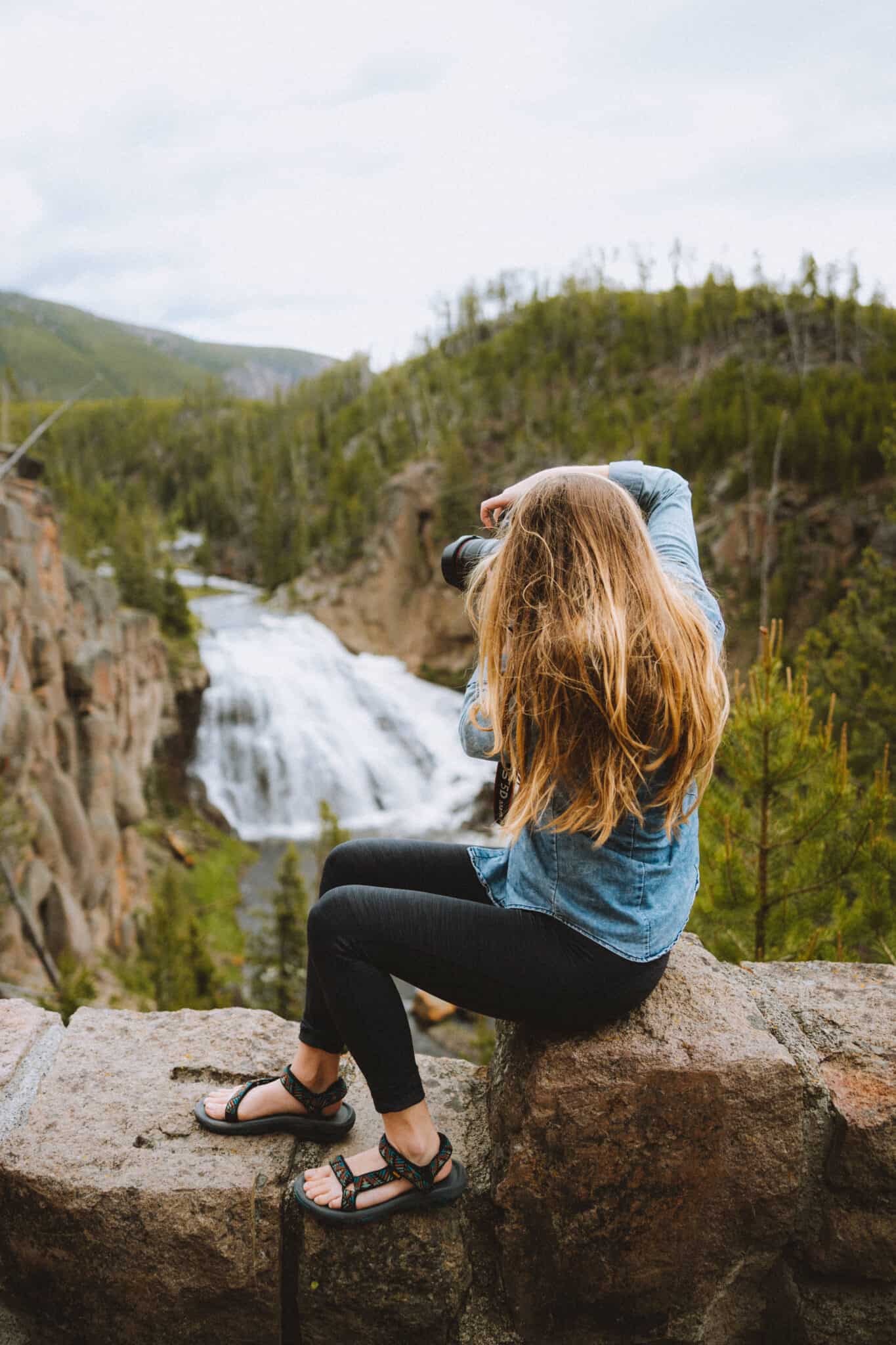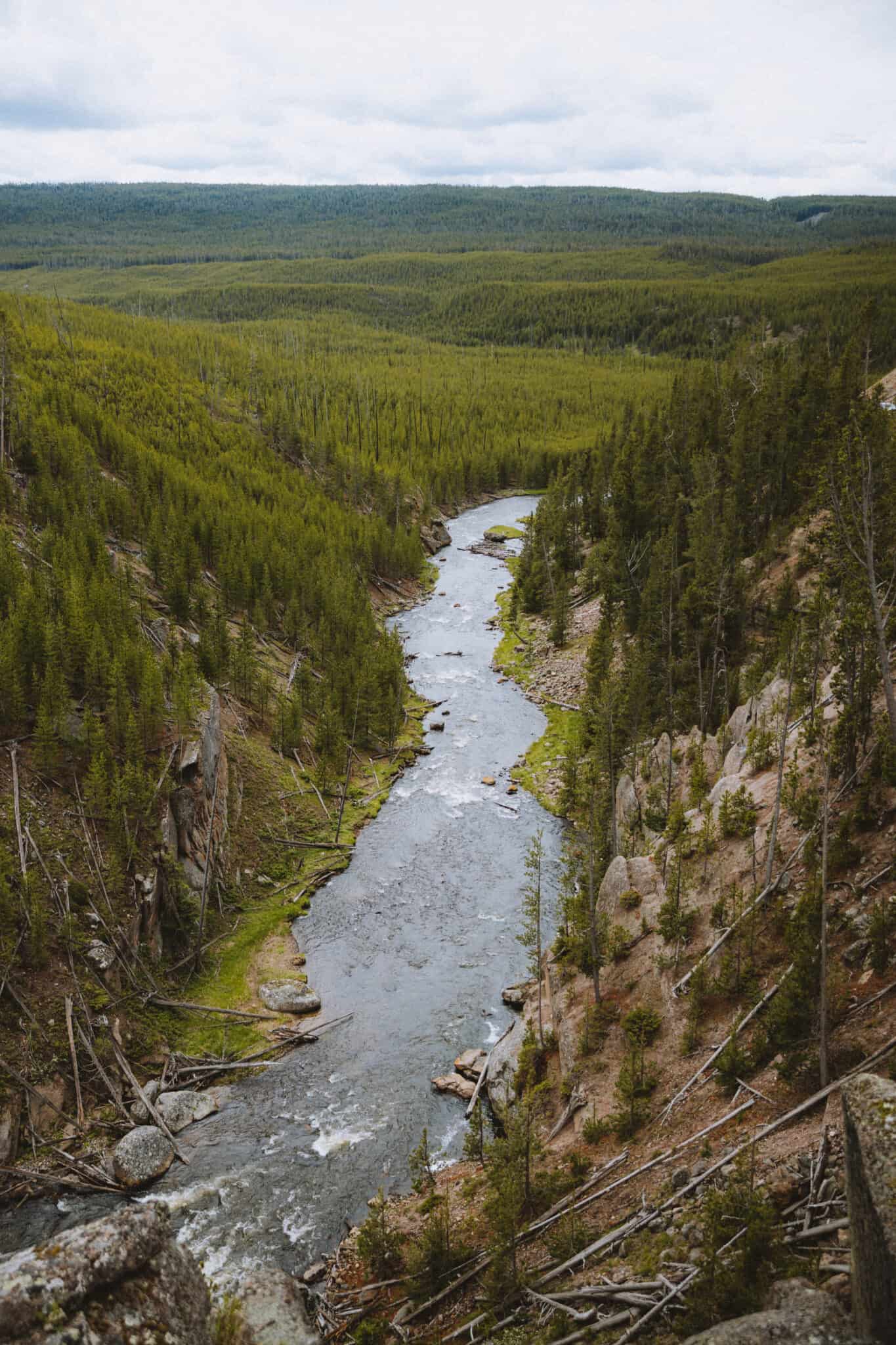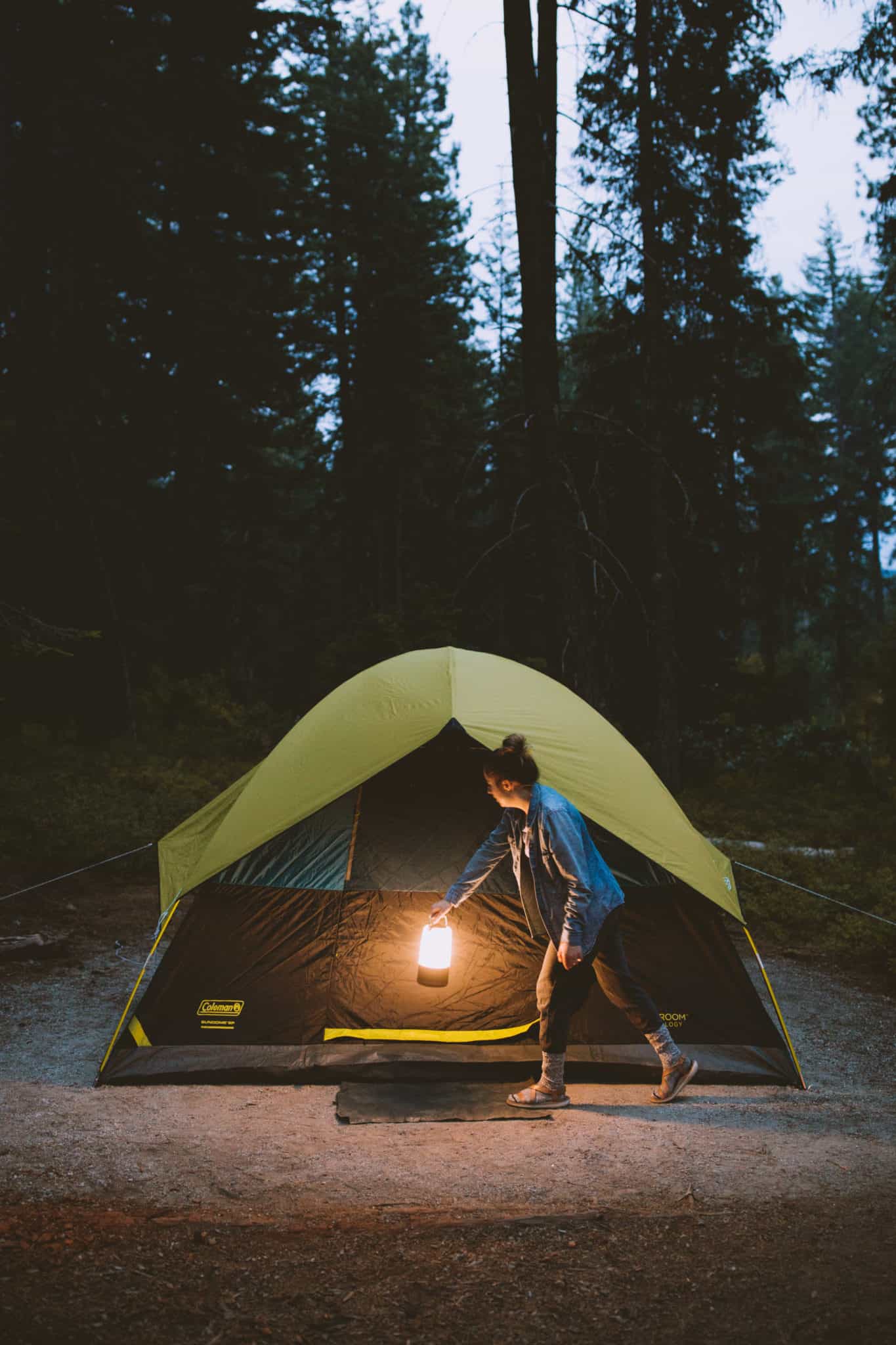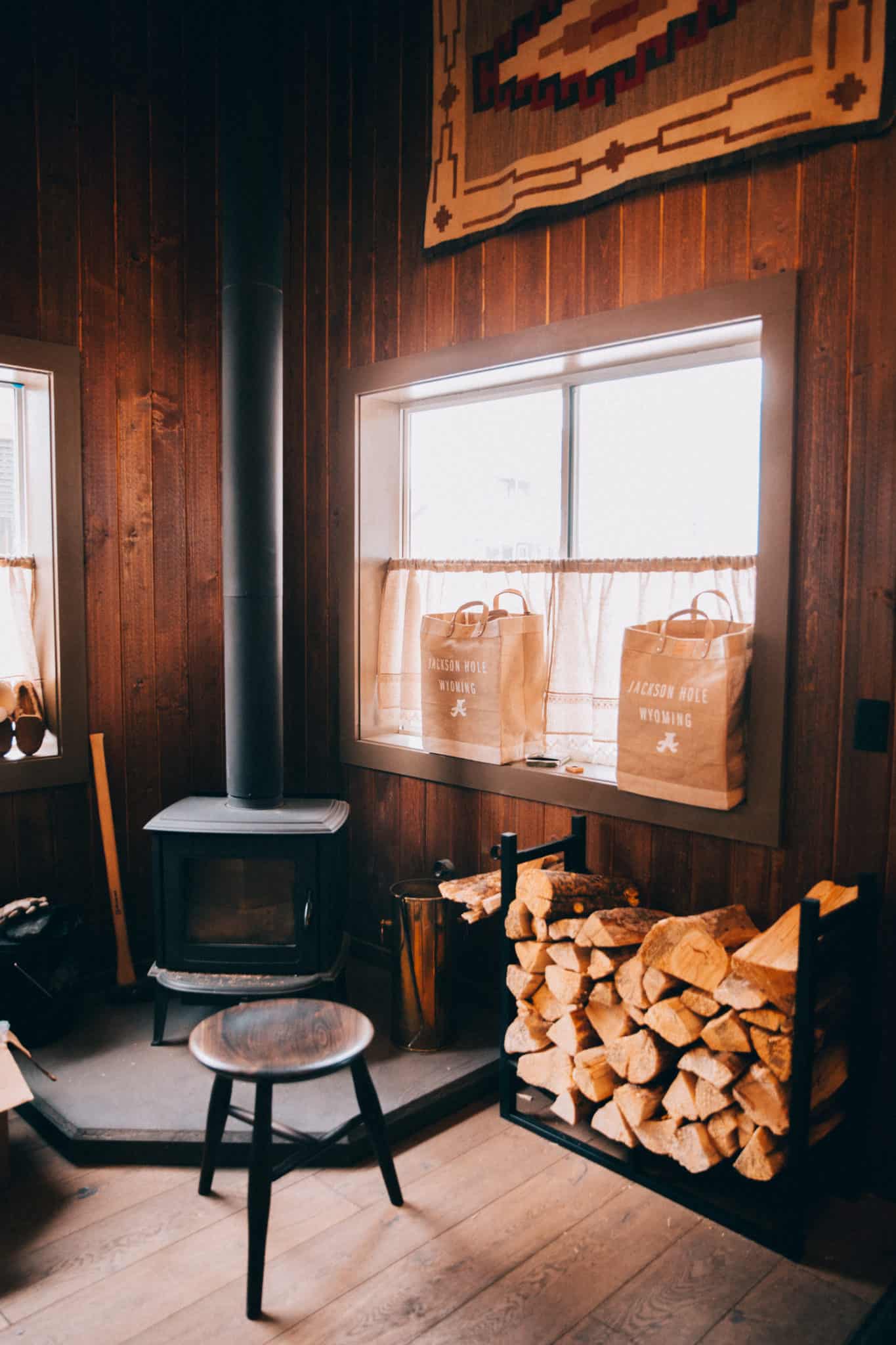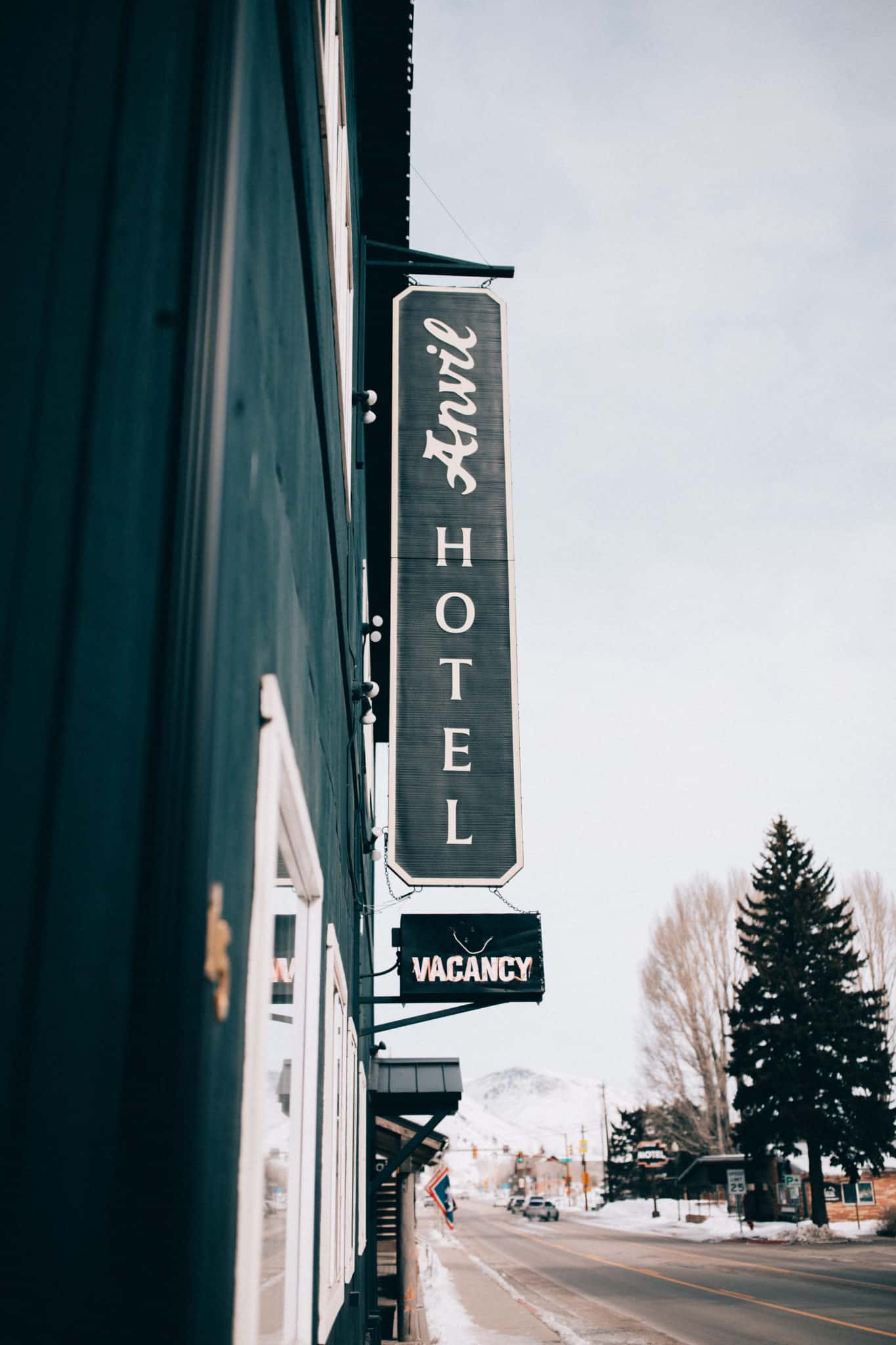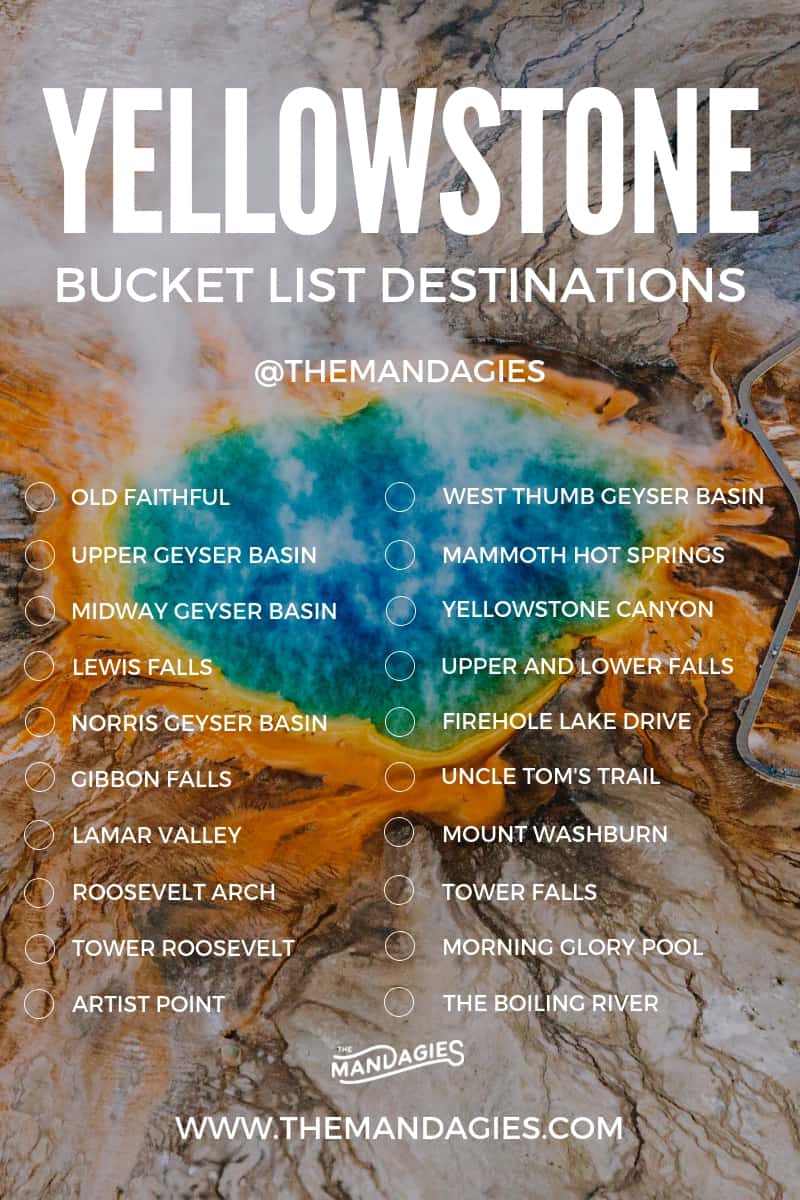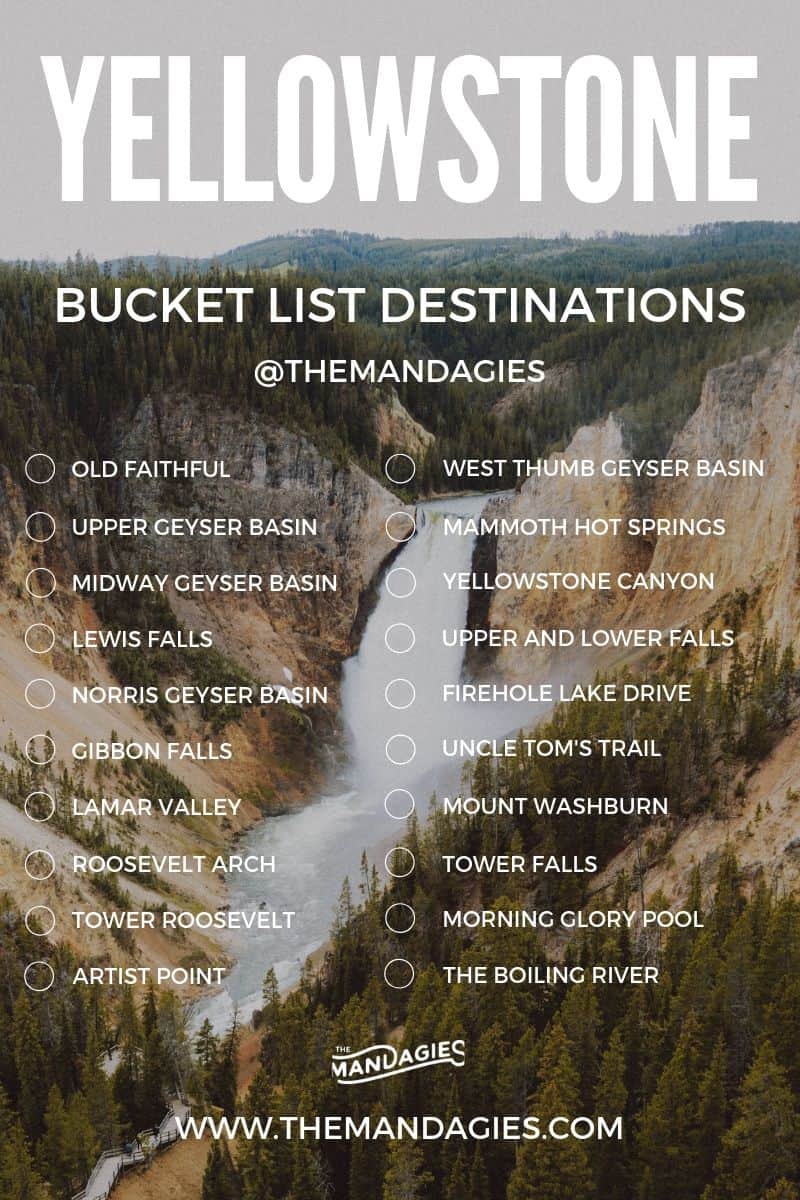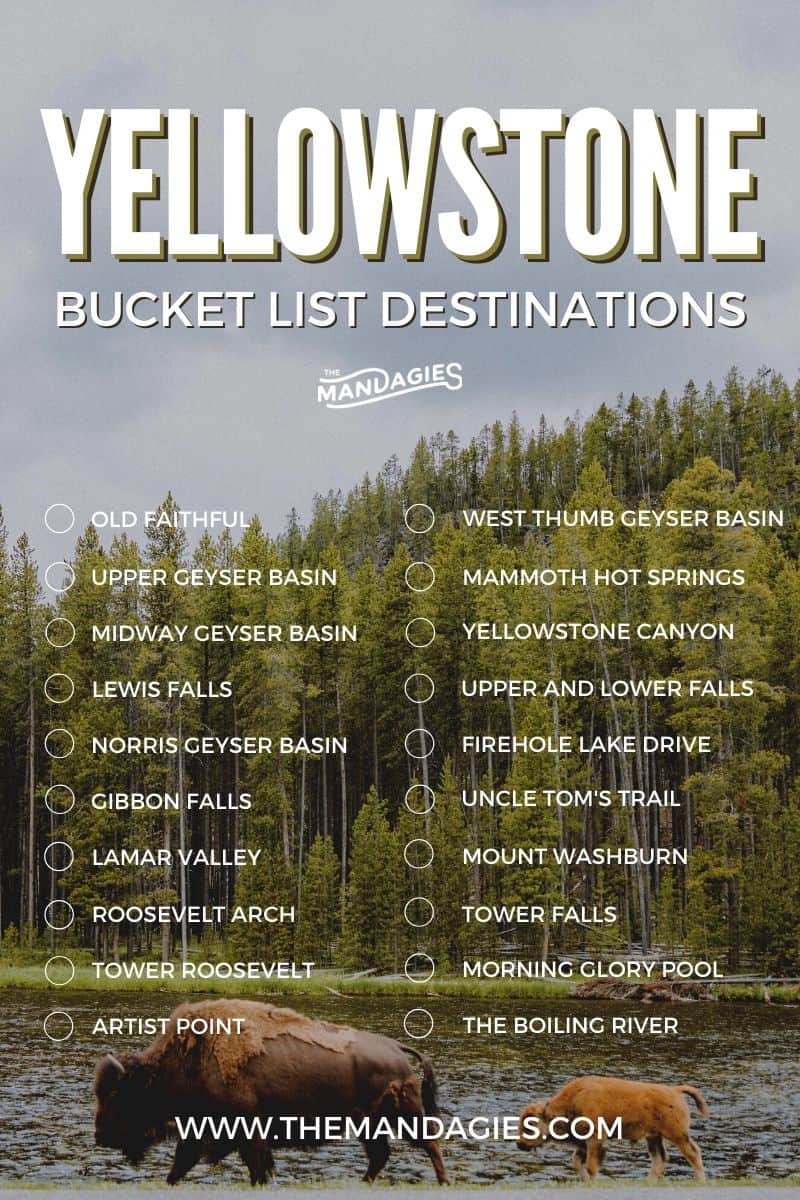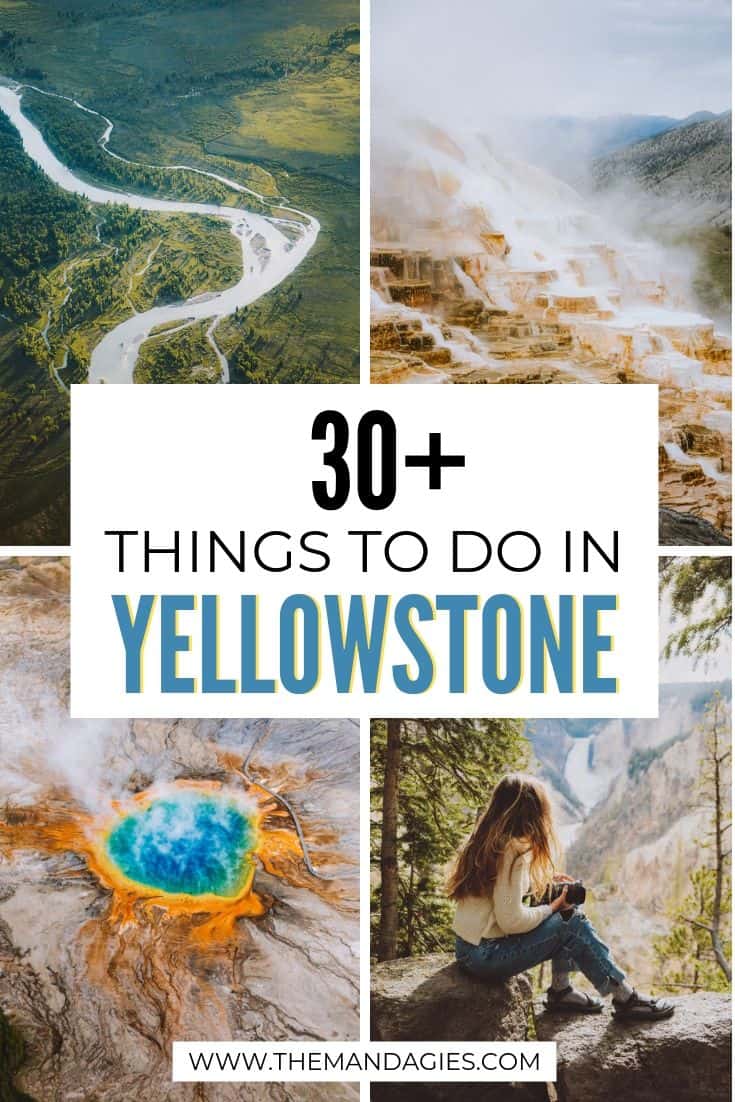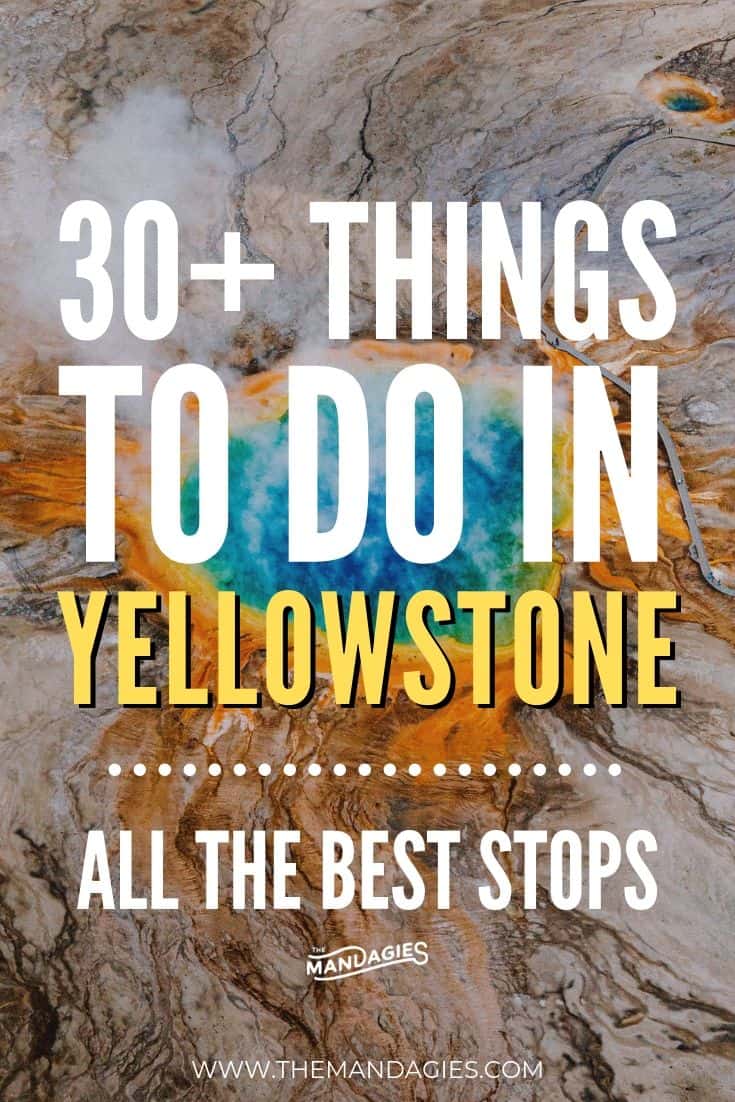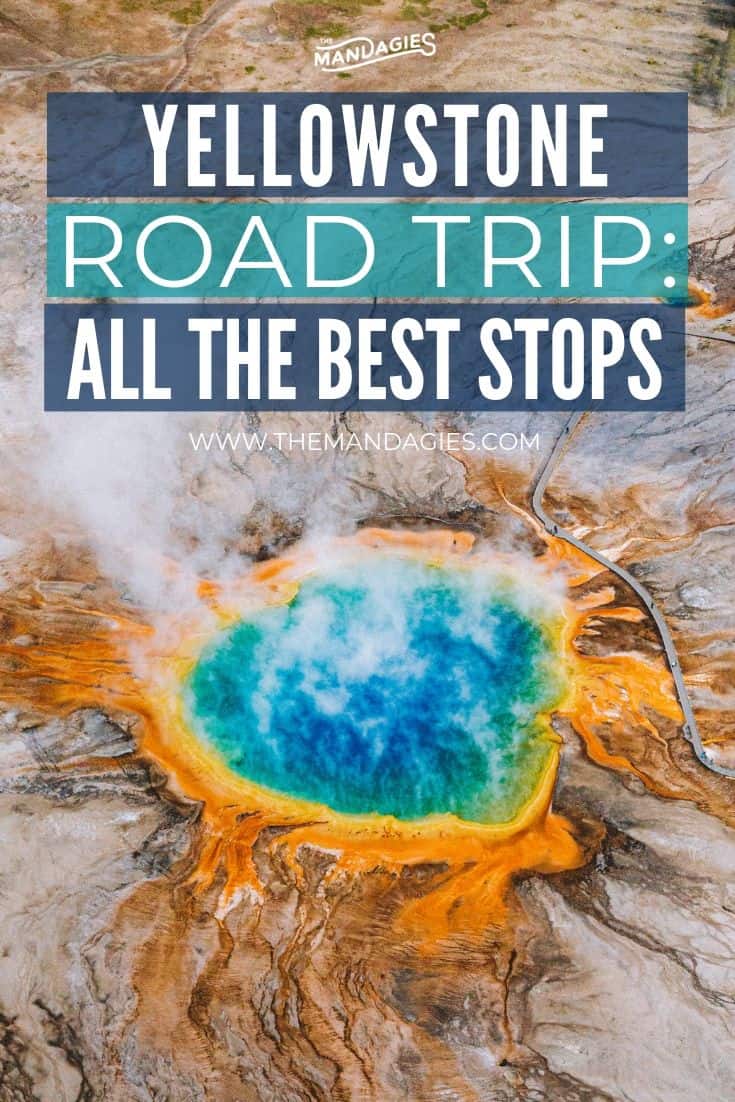Are you planning a trip to Yellowstone National Park? First of all, we’re SO stoked for you! This is America’s first and oldest national park, and you’ll quickly see why it was preserved and protected!
There are so many incredible things to do in Yellowstone that you could spend an entire summer here and still have more to see and do.
However, we totally get that not everyone has three months to explore this beautiful park. Most people only have 3 days in Yellowstone!
So, if you’re looking for all the highlights of things to do in Yellowstone this is the post for you!
We’re sharing what to do in Yellowstone for a weekend itinerary, all the main attractions, and even some hidden gems along the way. There will also be a map of the main Yellowstone attractions and where they are in relation to everything in the park.
So, what are we waiting for? Let’s get to planning your Yellowstone trip!
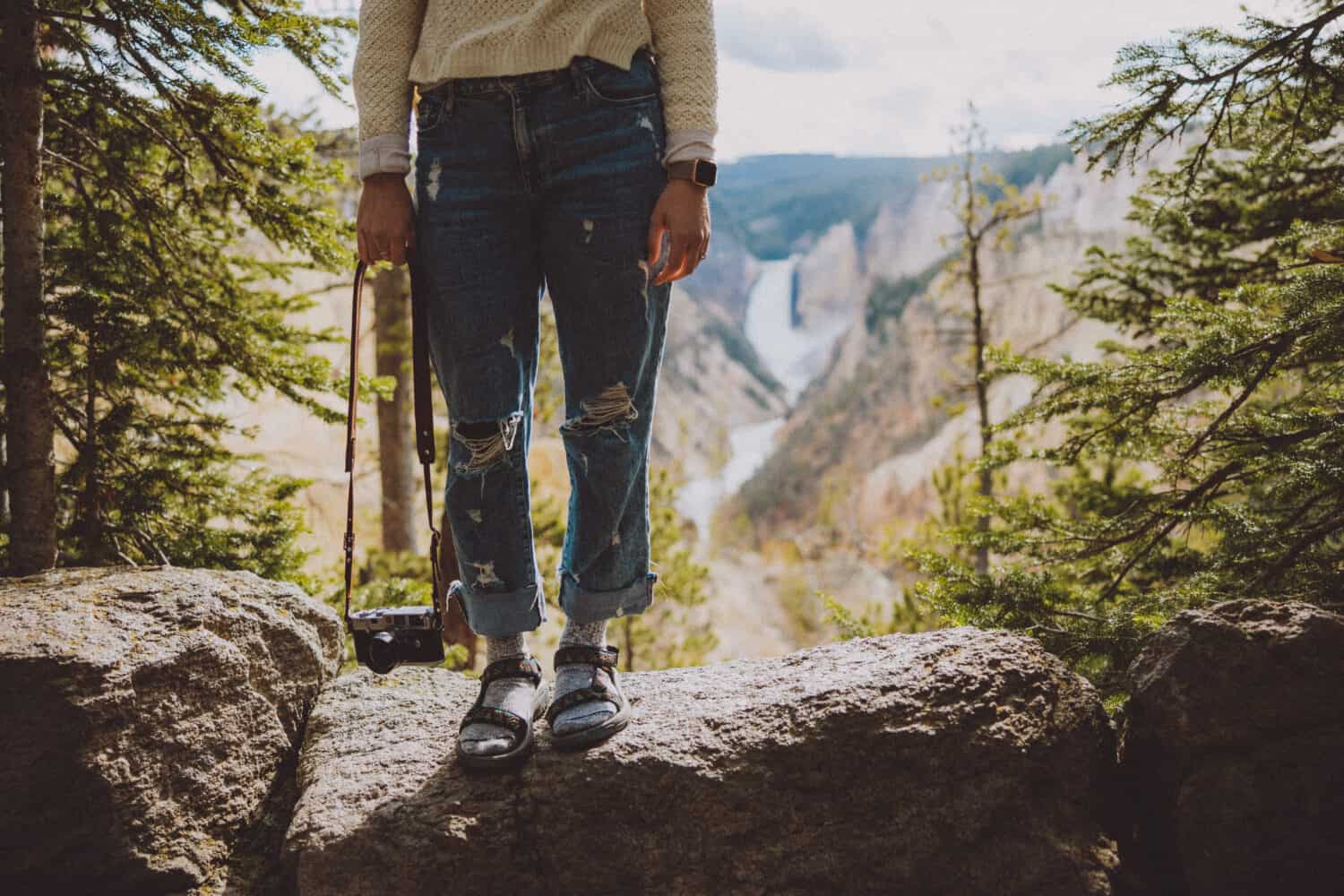
First of all, where is Yellowstone National Park?
Yellowstone National Park is located in the Northwest corner of the state of Wyoming, but technically, not all of it is in the state! 96% of the park resides in Wyoming, 3% is in Montana and a tiny section of 1% is in Idaho.
Yellowstone National Park has 2.2 million acres (or 3,472 square miles) for public enjoyment, and it has a sophisticated system of roads to reach the most popular attractions.
The entire park is open in the spring, summer, and fall, but most roads are closed in the winter season. If you plan to visit Yellowstone in winter, click here to read about which roads are open, and what attractions you can reach in these cold months.
History of Yellowstone National Park
The Yellowstone region has been inhabited by Native Americans for 11,000 years or longer.
This native land and its residents were likely of the Apsaalooke (Crow) tribe, and the Tsestho’e (Cheyenne) tribe. Click here for more information about the native people who lived in the Yellowstone area.
To discover what native land you are visiting, click here and learn about the different indigenous areas of the United States!
Yellowstone was established as a national park in 1872 by the US Congress under Ulysses S. Grant. It was the first national park in the United States and regarded to be the first in the entire world as well.
In 1978, it was named a UNESCO World Heritage Site, which made it the first one in the United States to gain that title!
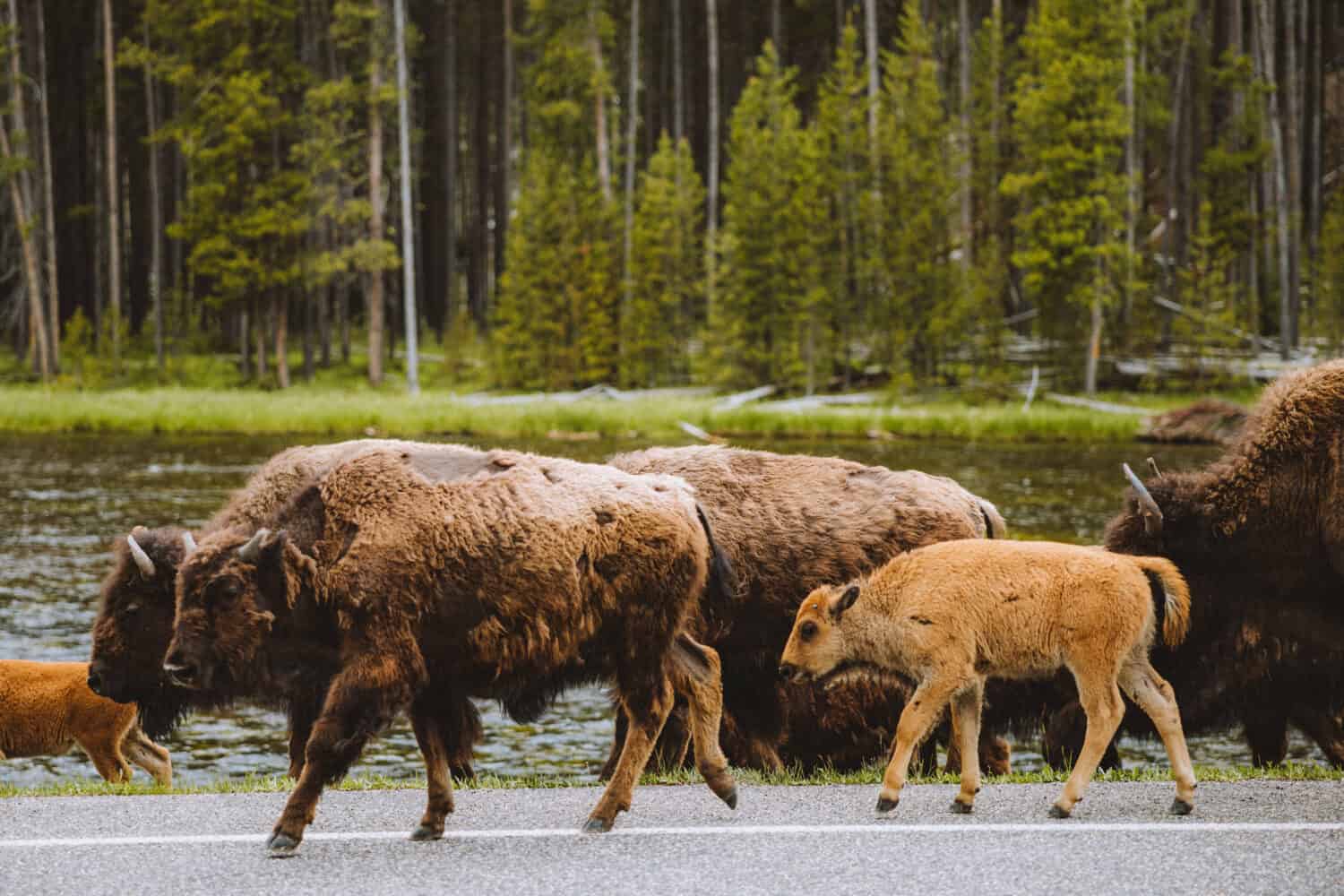
31+ Incredible Things To Do In Yellowstone National Park (Your Epic Yellowstone Bucket List!)
Where To Begin Your Yellowstone National Park Itinerary?
There are a few great places to begin your journey, but all of them will take you on the same Yellowstone route – The Grand Loop Road.
The Grand Loop Road is a highway that goes in a giant loop (shocker, we know) and covers the most popular Yellowstone attractions.
It’s 142 miles long and without stopping, it could take you anywhere from 4 to 8 hours to drive the entire route.
It’s possible to drive the entire road in one day, but we don’t recommend it. Doing this wouldn’t give you any time to explore the many beautiful spots in Yellowstone!
This is why we think that 2-3 days in Yellowstone is an ideal and acceptable place to start when planning your trip.
Now, when planning a trip to Yellowstone, there are a lot of questions to address. We’re covering all of the most commonly asked questions at the bottom of this post in our FAQ section.
If not, keep reading for our recommended route throughout the park!
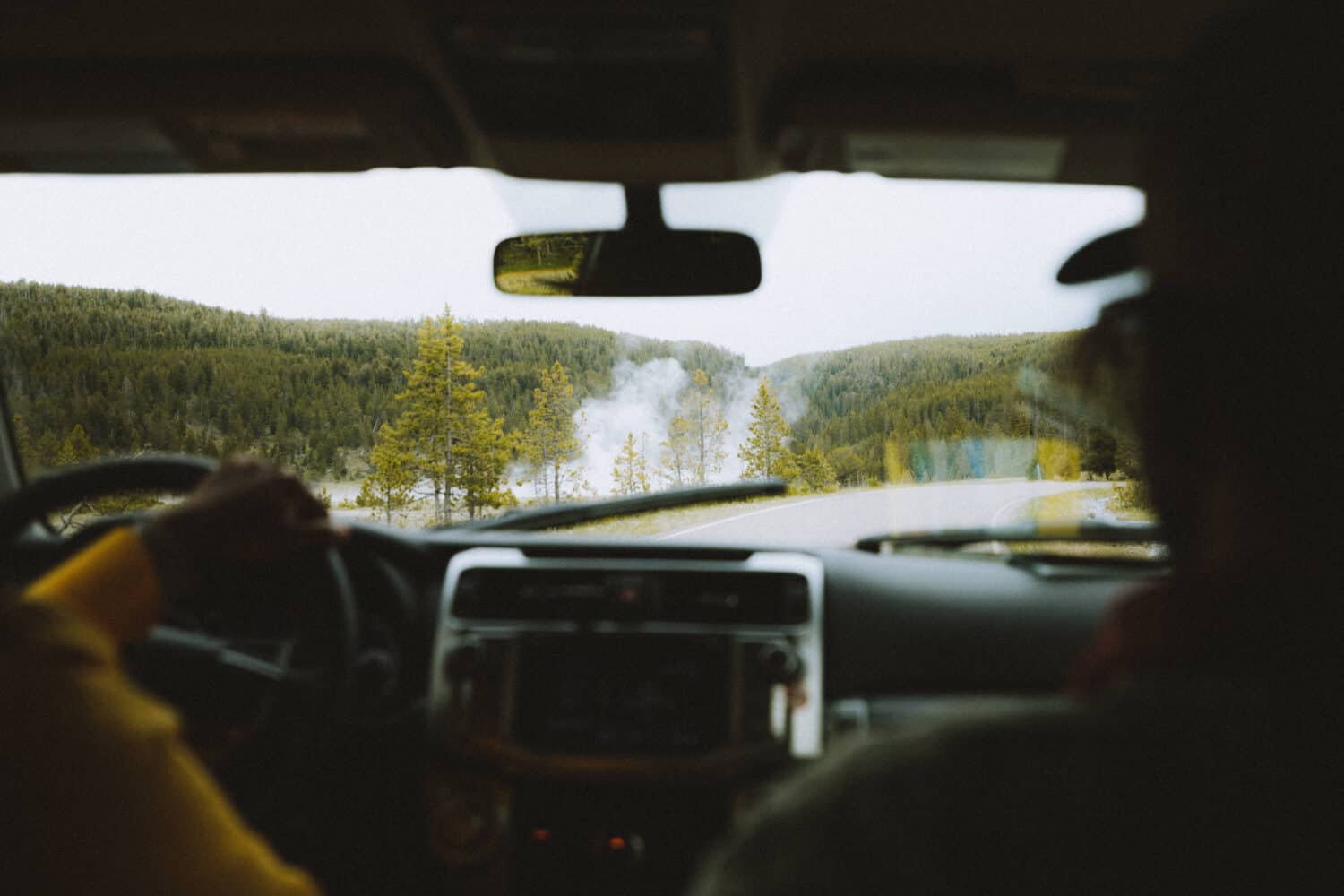
The Best Yellowstone Road Trip Route
Looking at the map, you’ll discover that the main roads make a figure 8 shape. In this post, we’re going to split up two days in Yellowstone and take on one ‘ring’ each day.
On the first day, we’ll cover the south ring road. This one includes the most famous Yellowstone attractions, including Old Faithful, Grand Prismatic, and The Grand Canyon of The Yellowstone. On the second day, we’ll cover the north ring road. This day includes a lot more wilderness, a bit more driving, and more opportunities to get outside and take a few trails.
Below, you’ll see a graphic of our Yellowstone road trip route. We’re going to go in-depth on all the awesome things you can see with only two or three days in Yellowstone. Let’s begin!
Psst, want to make your trip even easier? Try downloading the app The Dyrt for their trip planner feature. You can set your route and waypoints, and it will find you the best campground and gas stops along your Yellowstone road trip route! Try their pro membership free for 30-days when using our code MANDAGIES!
Things To Do In Yellowstone (On The South Ring Road)
The South Ring of the Grand Loop (Figure 8, remember?) is an easy way to make a day trip to Yellowstone. If you only had one day in Yellowstone to spare, we’d recommend taking this route.
This area has the most famous attractions, so start early to beat the crowds and make the most of those daylight hours!
1. Entering The Park Via The South Entrance (And Look For Bears!)
Look out for bears! Berty and I pulled over to the side of the road to let an RV pass us, and we coincidentally saw a grizzly bear right out the window!
These thick trees before the main area of the park are a great place for Yellowstone bears to wander and forage for food, so keep your eyes peeled.
We also stopped at several pullouts to view the river. It’s a quiet place to stop for a bit and soak in the quiet of the morning.
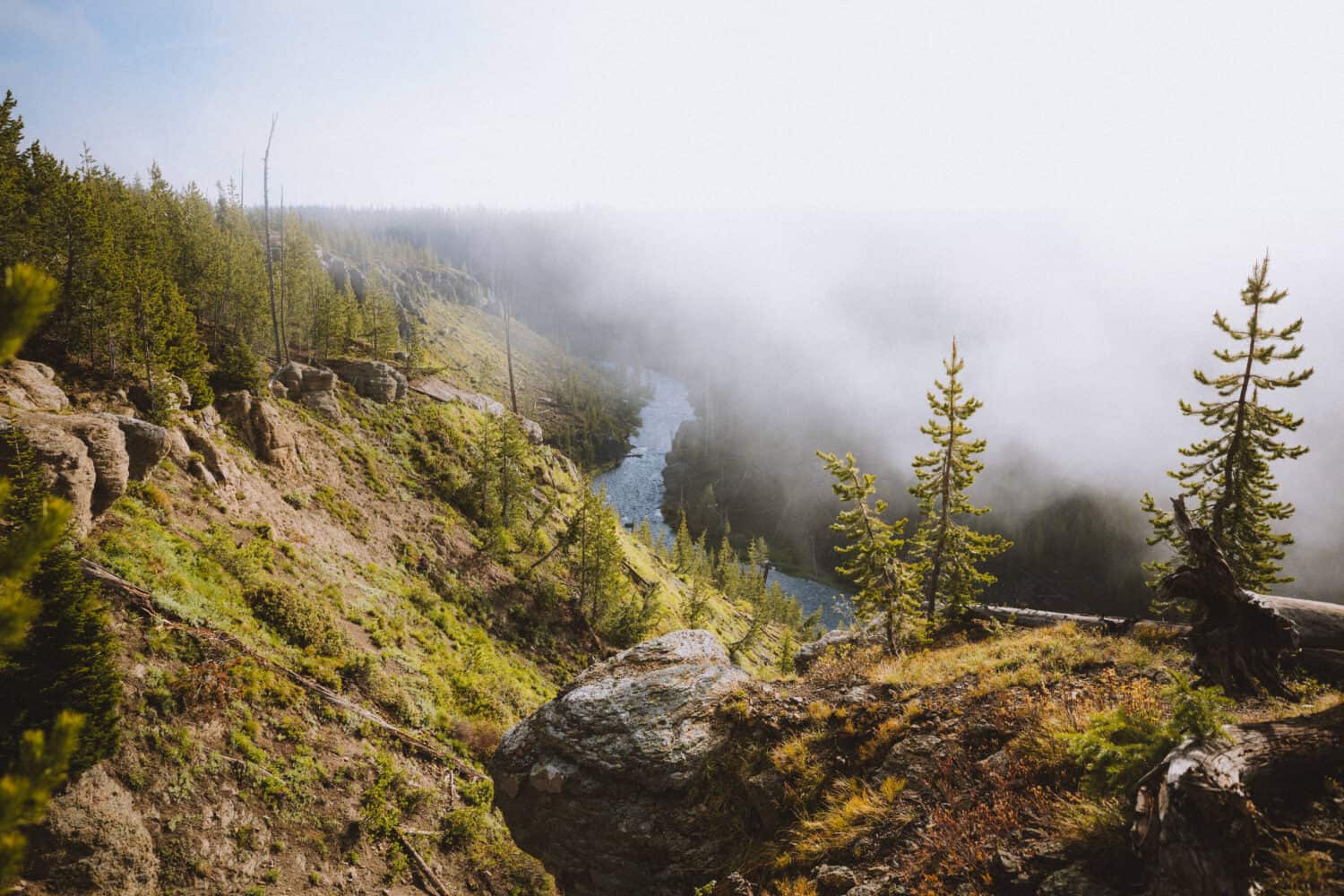
2. Hike To Lewis Falls
Lewis Falls is located just north of the South Entrance of Yellowstone National Park near Grant Village.
This 30 foot falls can be easily seen from the road and is a popular and common pull-off stop for travelers coming in and out of the park.
There are two options to view Lewis Falls – south of the river and north of the river.
South of the river, you can walk along a ledge and get close to the top of the falls and see the water rushing below. This is a great spot to get close, but not so great if you are hoping to get a photo of the full scene.
North of the river, you can take a trail that’s less trafficked to get a straight view of the falls.
It’s a fairly easy walk – the trail is a little steep but very short. Be careful where you step!
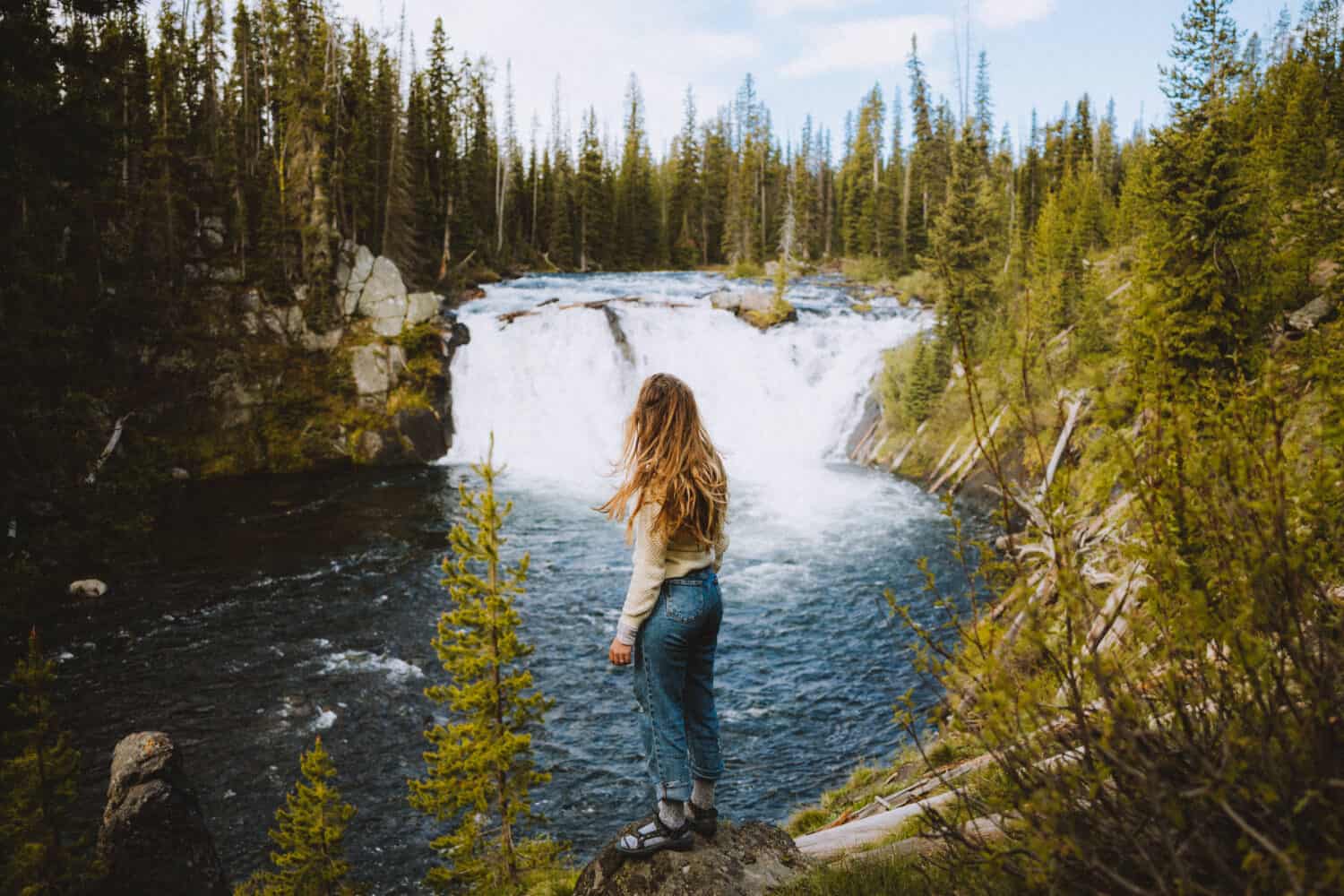
3. Watch Old Faithful Erupt!
Of all the geysers in Yellowstone, Old Faithful is the most famous and well-known one!
Old Faithful was the first geyser in Yellowstone to receive a name! It was discovered by the Washburn Expedition in 1870 and shoots boiling water anywhere from ninety to one hundred twenty feet in the air.
It is often said that it erupts every hour but it technically erupts every 1 hour and twenty minutes – give or take 10 minutes!
You can easily watch it erupt from the amphitheater-style viewing area around the geyser.
This is the most popular spot to visit in Yellowstone, so this is why we suggest arriving here in the early morning of your Yellowstone itinerary.
The Old Faithful Parking lot is very large and holds hundreds of cars. It’s also the most accessible and visitor-friendly area in the park – all kinds of amenities, food, accommodations, and information about the park can be found here.
That being said, come early because you never know when EXACTLY it will erupt and the front seats fill up quickly!
Yellowstone Pro Tip: In order to help your Yellowstone itinerary run smoothly, it’s essential to check the eruption times for Old Faithful. Save this Old Faithful eruption time website for the most current updates!
If you are staying in a Yellowstone Lodge, you also can call the front desk and ask for this info – they always have it ready to share!
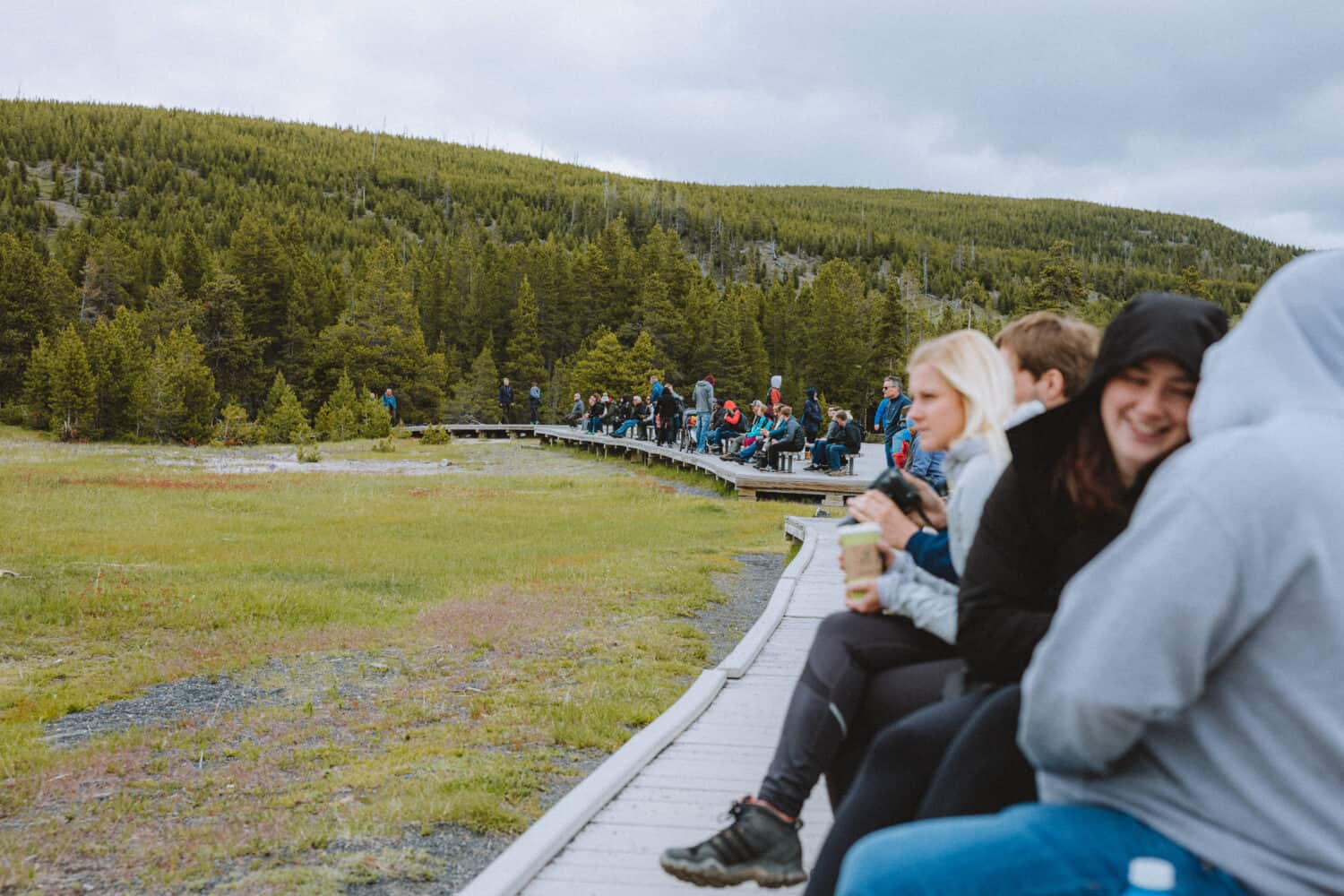
4. Tour The Upper Geyser Basin
While Old Faithful is the most famous geyser in the Upper Geyser Basin, there is a plethora of amazing geysers to explore in the same area.
This amazing stop on your Yellowstone itinerary is actually the largest concentration of geysers in the entire world!
You could easily spend an entire morning here walking the boardwalks and viewing the geysers, but if you’re short on time, try checking out Geyser Hill. It’s the boardwalk area directly up the hill from Old Faithful! Here are some of the highlights:
- Giantess: A fountain-type geyser that’s infrequent, but amazing when it erupts! Can shoot multiple bursts up to 200 feet and the ground can shake!
- Beehive Geyser: Irregularly erupts 4-5 times daily. Narrow, but projects 150-200 feet high.
- Doublet Pool: Known for its striking colors and layers, this is the most photogenic of all the pools on Geyser Hill.
- The Lion Group: Four geysers together, they sound like they make a deep roaring noise.
- Plume Geyser: Erupts every hour in bursts up to 25 feet.
Berty and I arrived at Old Faithful and BARELY missed the eruption, so we had about an hour to wander the Upper Geyser Basin to kill some time. We walked the boardwalk loop just north of Old Faithful, and we were glad we visited!
5. Have a bit longer to spare? Try walking to Grand Geyser, Castle Geyser, and Riverside Geyser to view more amazing hydrothermal features!
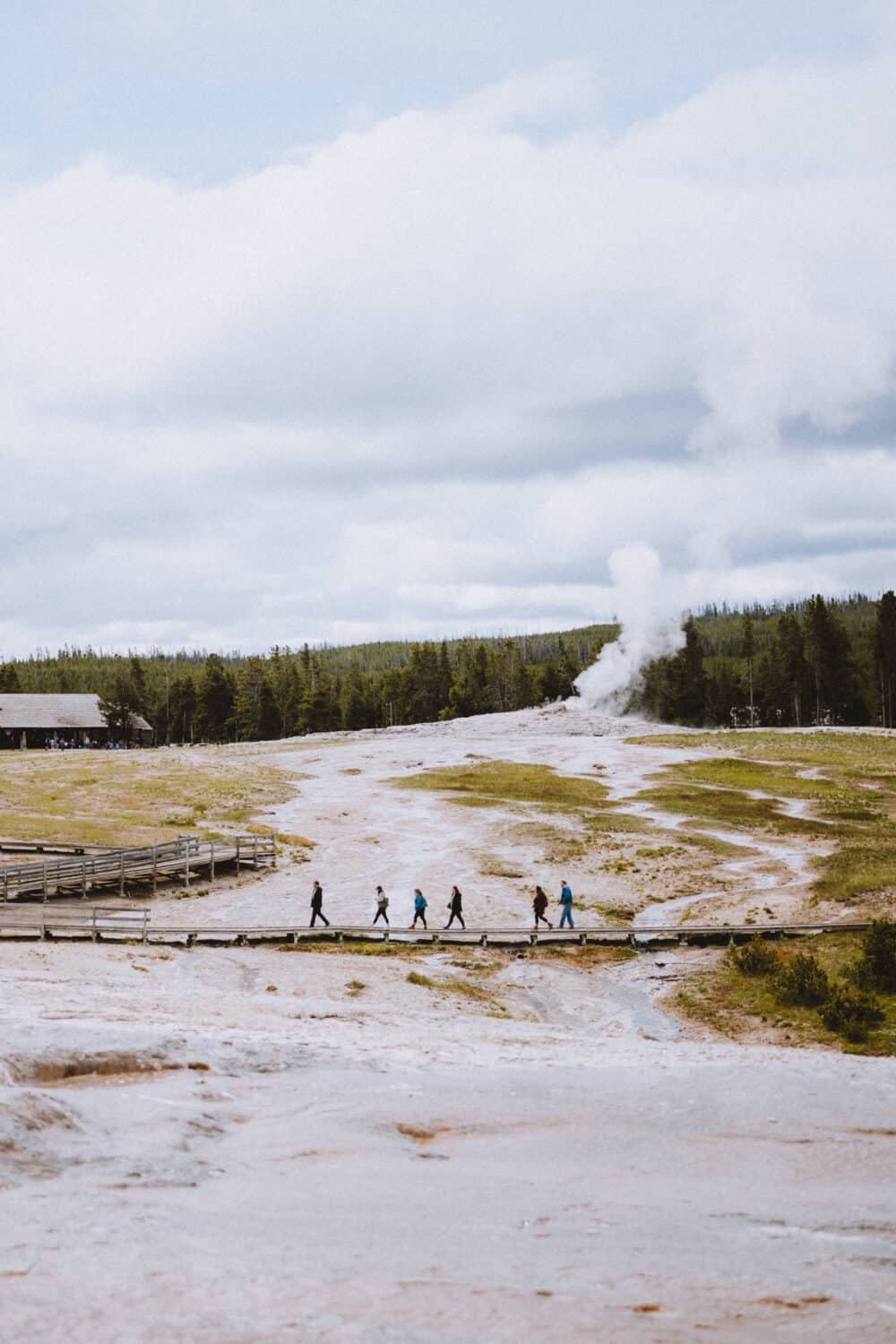
6. Explore The Midway Geyser Area (Grand Prismatic)
The Midway Geyser area is just north of Old Faithful (but still in the southwest area of the park), and it’s a much smaller area than the Lower Geyser Basin.
It consists of the Excelsior Geyser, Turquoise Pool, Opal Pool, and the star of the show – Grand Prismatic Spring.
The Grand Prismatic Spring is probably one of the most popular photo spots in Yellowstone National Park. You are likely to recognize this boiling pool’s signature icy blue center with a red/orange/yellow ring around the perimeter.
Here are some little known facts about the Grand Prismatic Springs:
- It’s deeper than a 10-story building.
- It’s the third-largest spring in the world, bigger than a football field.
- Different bacteria and microbes that live in different water temperatures give it the rainbow of colors around the rim.
Visitor Tips: Come visit this area very early or very late in the day. The Midway Geyser Area is a regular stop for large tour buses that bring large crowds.
This area also has practically no shade, so come equipped with sunscreen, proper sun protection like a hat, and a water bottle to keep yourself cool and hydrated!
7. Hike To The Grand Prismatic Spring Overlook!
This is an alternate viewing area for the spring, away from the main parking lot and crowds.
To get here, head north on Highway 20 from Old Faithful and park in the Fairy Falls Trailhead Parking Lot. It’s a very large lot with a high chance of getting a parking spot any time of the day.
From the parking lot, follow signs for the Grand Prismatic Overlook. The trail is 0.5 miles long and very easy. There is a slight elevation gain at the end of the trail, but you quickly reach the viewing platform after it starts to incline.
From the top, you get a higher view of the Grand Prismatic, and unobstructed views of the colors, steam, and even the people on the boardwalks below!
Bonus! There’s a very high chance of seeing Yellowstone wildlife along the way, just like this bison on the side of the trail!
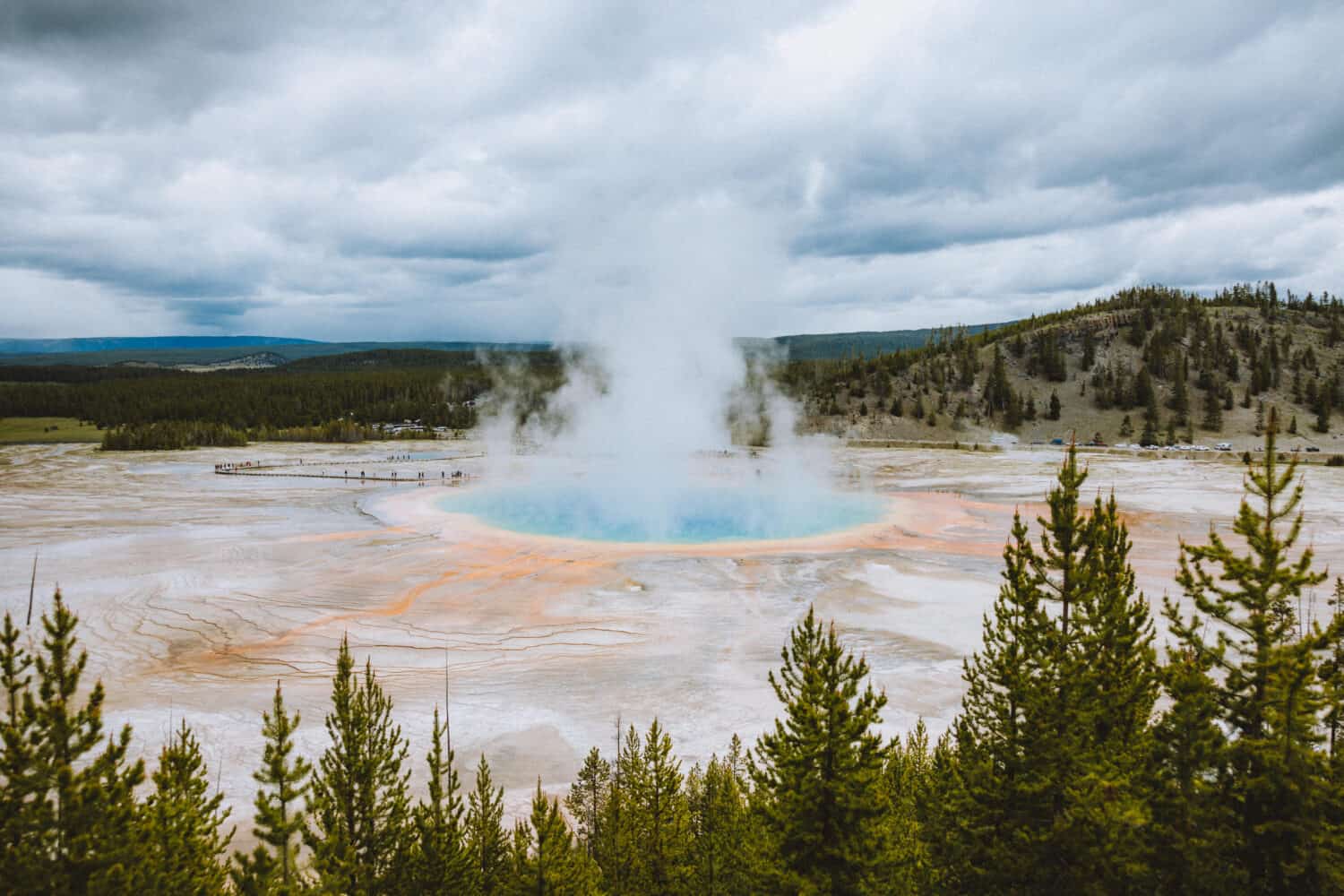
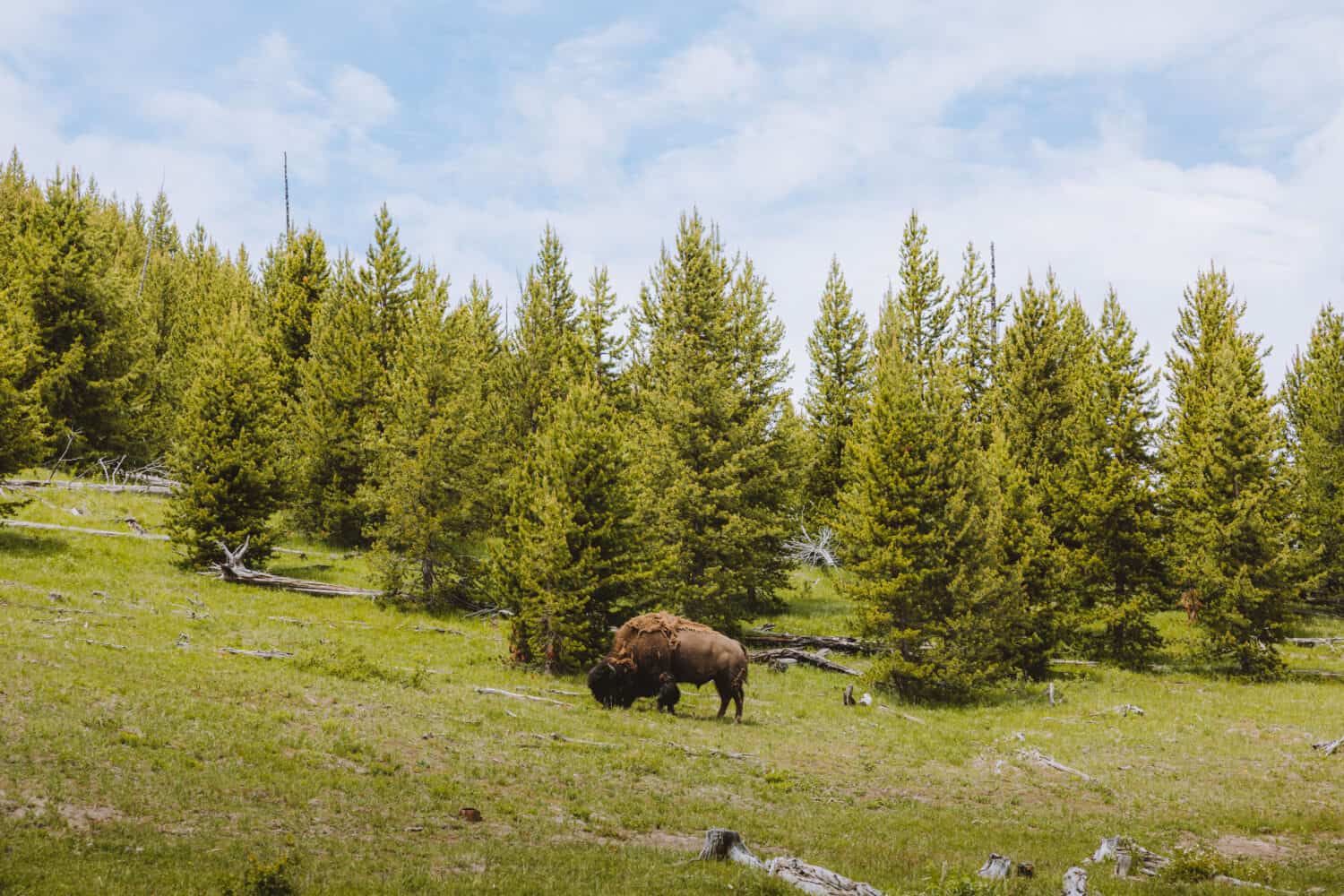
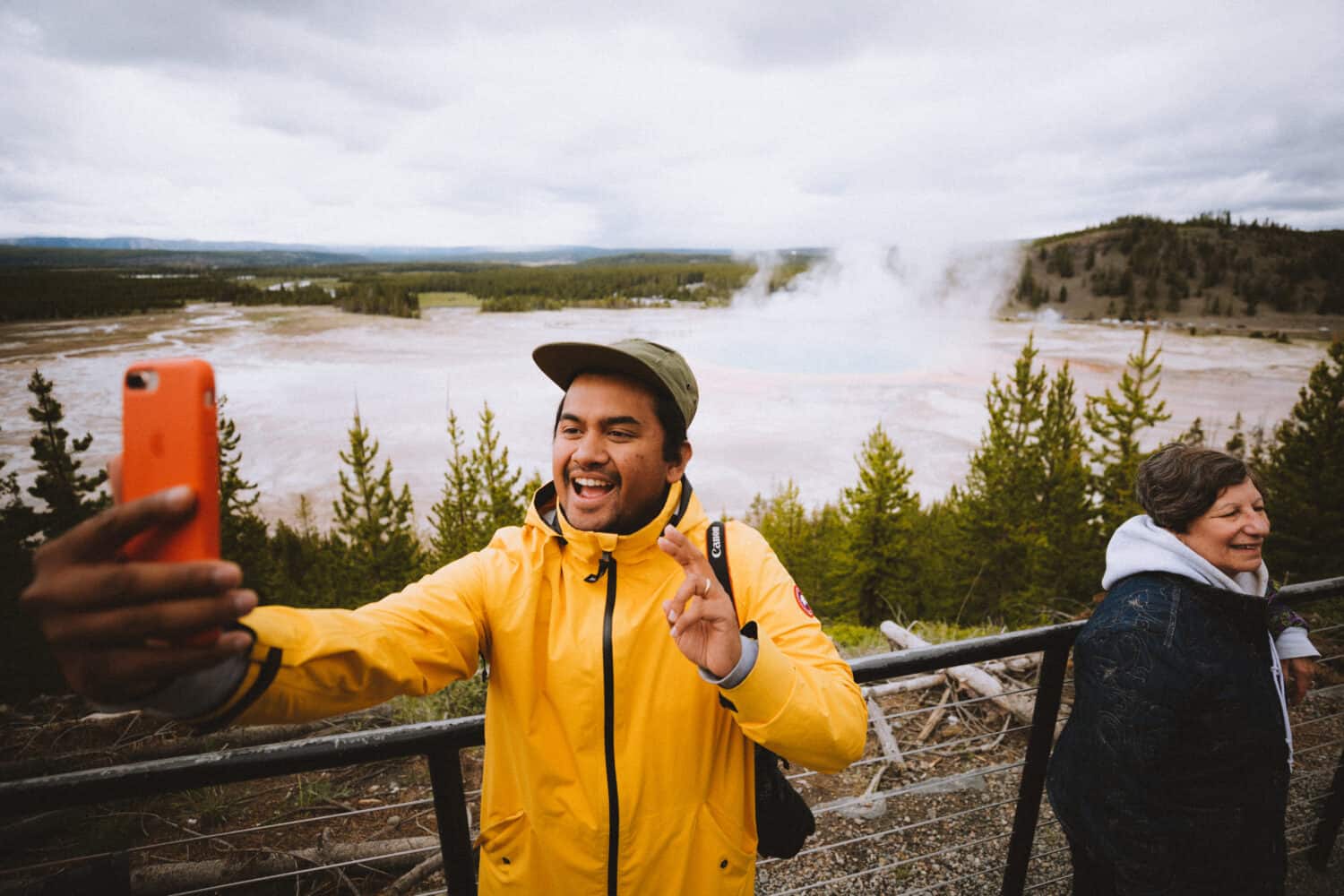
8. Ready To Elevate Your Yellowstone Trip? See The Grand Prismatic From The Sky!
Really wanting those photos you see all over the internet – the ones that show Grand Prismatic Spring from the sky? There isn’t an easy way to see if from the sky, but it IS possible!
Fly Jackson Hole is a private charter company that provides scenic flight tours and private photography tours.
If you are a serious photographer wanting to capture the Grand Prismatic Spring from the sky, contact them to arrange a flight from above.
Don’t forget your zoom lens either! The small planes only have clearance to fly so low, so you’ll need to be equipped with a zoom lens to capture the close-up details.
Click here to see more examples of a scenic flight with Fly Jackson Hole!
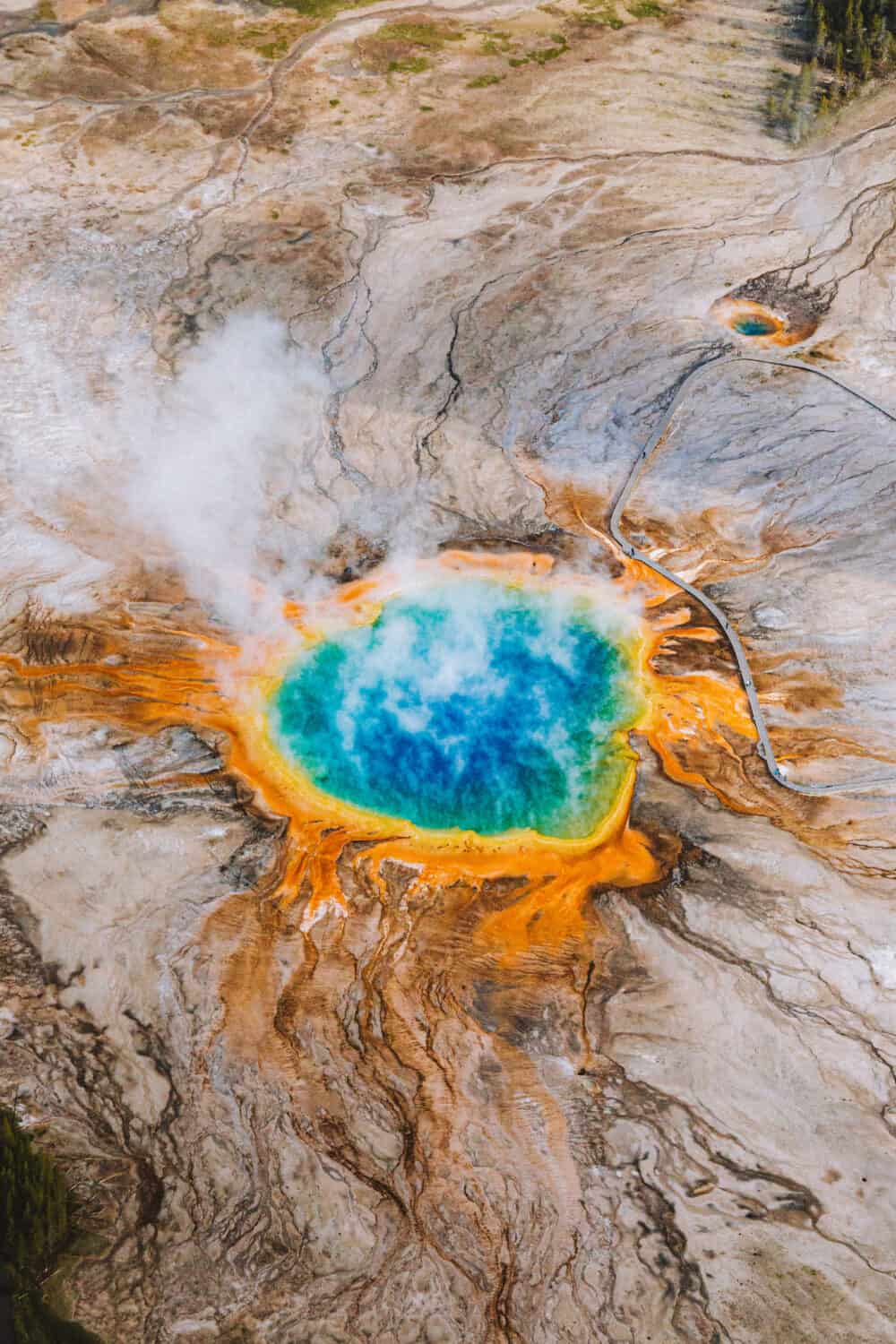
9. Explore The Grand Canyon Of The Yellowstone
The Grand Canyon of The Yellowstone was discovered in 1869 by Charles Cooke. He and his team discovered the canyon and said, “it seemed to be five minutes before anyone spoke” after that.
The Yellowstone Canyon is approximately 40 miles long, between a quarter and three-quarter miles wide, and between 800 feet and 1,200 feet deep. It’s probably one of the most quintessential things to do in Yellowstone National Park!
There are several incredible vantage points to explore along both the North and South rim of the canyon.
A few viewpoints are for seeing the Upper Falls (falling 109 feet) and the rest are for the spectacular Lower Falls, plunging down 308 feet to the canyon floor.
Spend some time on both the North and South rim because each side has its own amazing views of the falls and canyon below.
10. List of all the Grand Canyon Of The Yellowstone Viewpoints: (And click here for an interactive Yellowstone Canyon map)
Discover all the amazing places to view the falls from the Grand Canyon of The Yellowstone below:
- Brink of the Upper Falls (North Rim)
- Brink of the Lower Falls (North Rim)
- Red Rock Point (North Rim)
- Grand View (North Rim)
- Inspiration Point (North Rim)
- Artist Point (South Rim)
- Uncle Tom’s Trail (Currently closed August 2019)
- Upper Falls Viewpoint (South Rim)
See The Real Grand Canyon In Arizona: Watch Sunset at Our Favorite Spot In The Park!
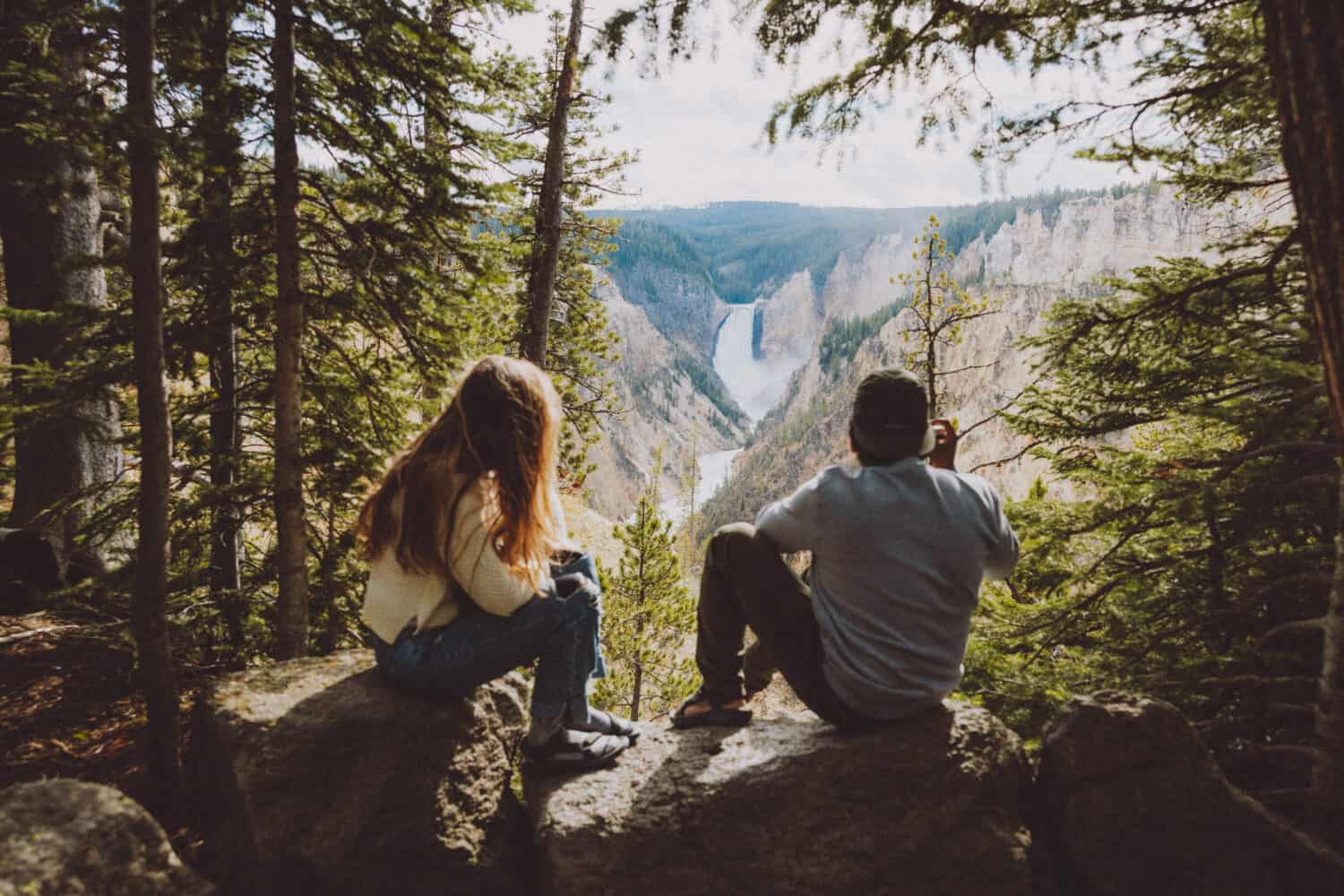
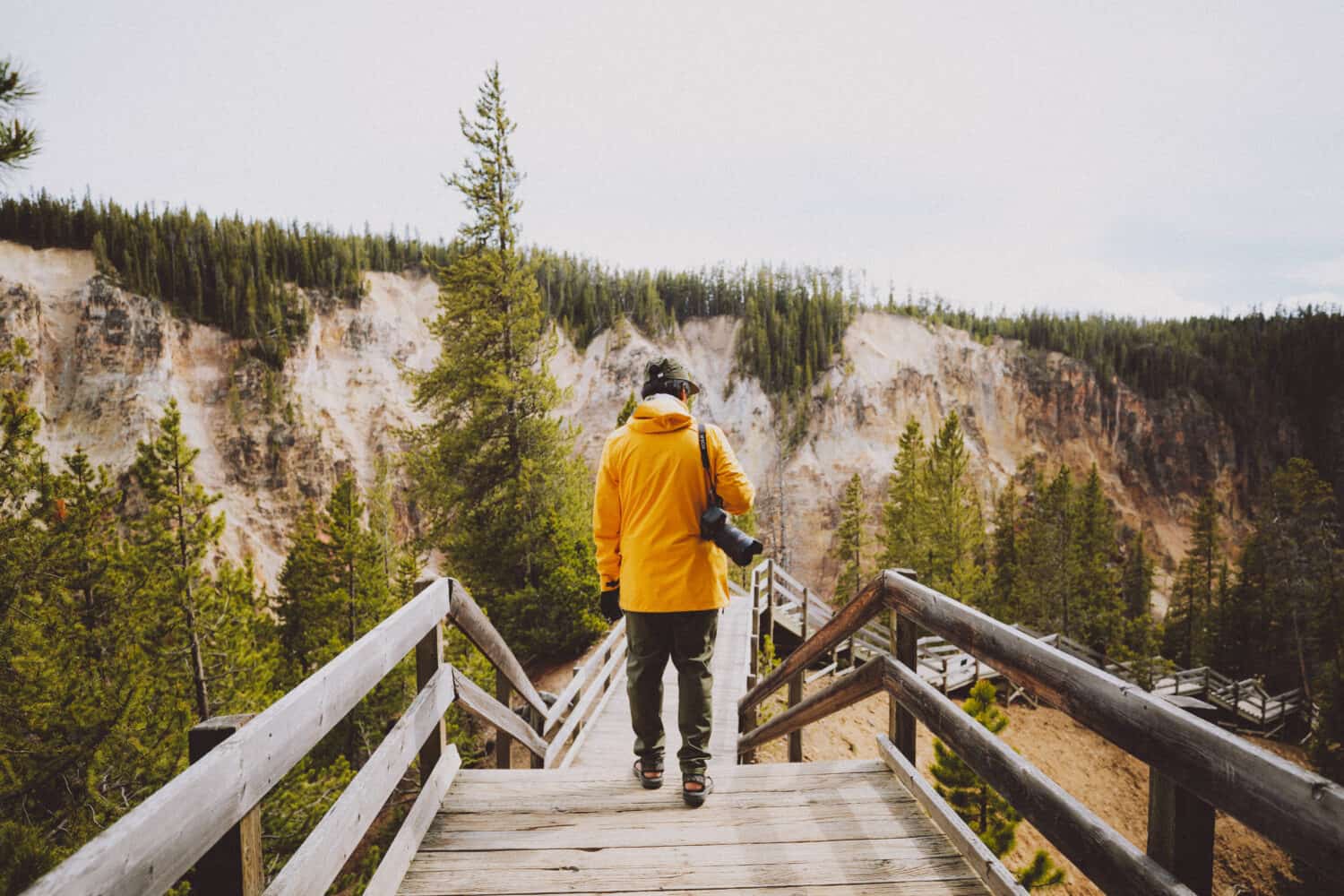
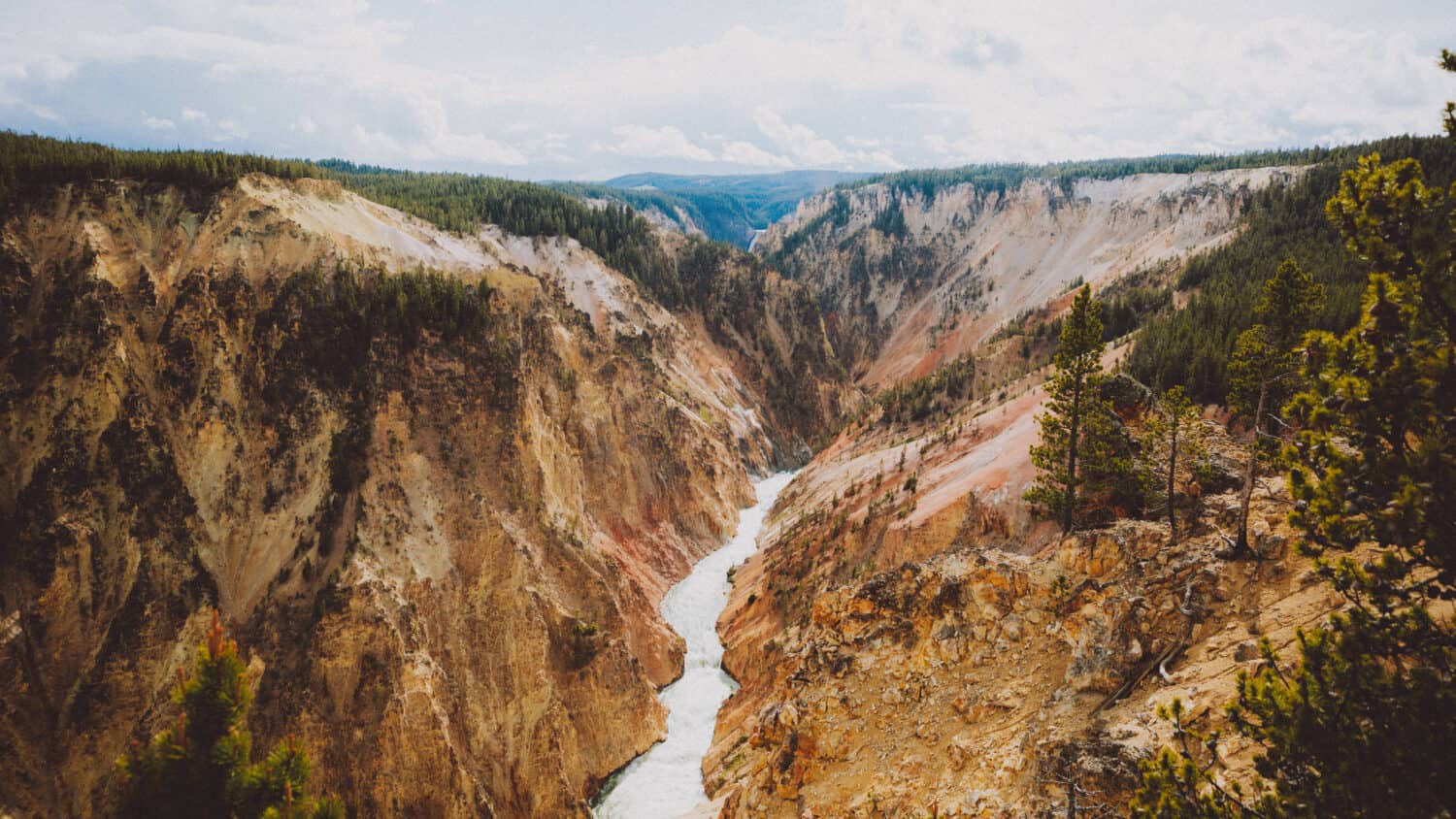
11. Walk Around The West Thumb Geyser Basin
The West Thumb Geyser Basin is actually a caldera within a caldera (the greater Yellowstone Caldera to be exact). About 174,000 years ago, a volcano erupted and collapsed here, creating a depression in the earth’s crust.
The depression later filled with water and is now a large bay of the greater Yellowstone Lake in the southern area of the park.
Within this are a cluster of gorgeous pools and geysers to explore via a short half-mile boardwalk loop.
Below are the list of geysers and pools you will visit in the West Thumb area of Yellowstone:
- Twin Geysers
- Blue Funnel Spring
- Fumaroles
- Thumb Geyser
- Collapsing Pool
- Ephedra Spring
- Perforated Pool
- Percolating Spring
- Ledge Spring
- Surging Spring
- Thumb Paint Pots
- Lakeside Spring
- Lakeshore Geyser (underwater in early spring and summer)
- Fishing Cone (Back in the 1800’s fisherman used to catch fish and cook them straight from the hook in this pool)
- Big Cone
- Black Pool (now blue with a delicate white edge)
- Abyss Pool
Visitor Pro Tip: Love Geography? Stop by the West Thumb Ranger Station and ask about daily walking tours – they know a ton of cool facts about each feature!
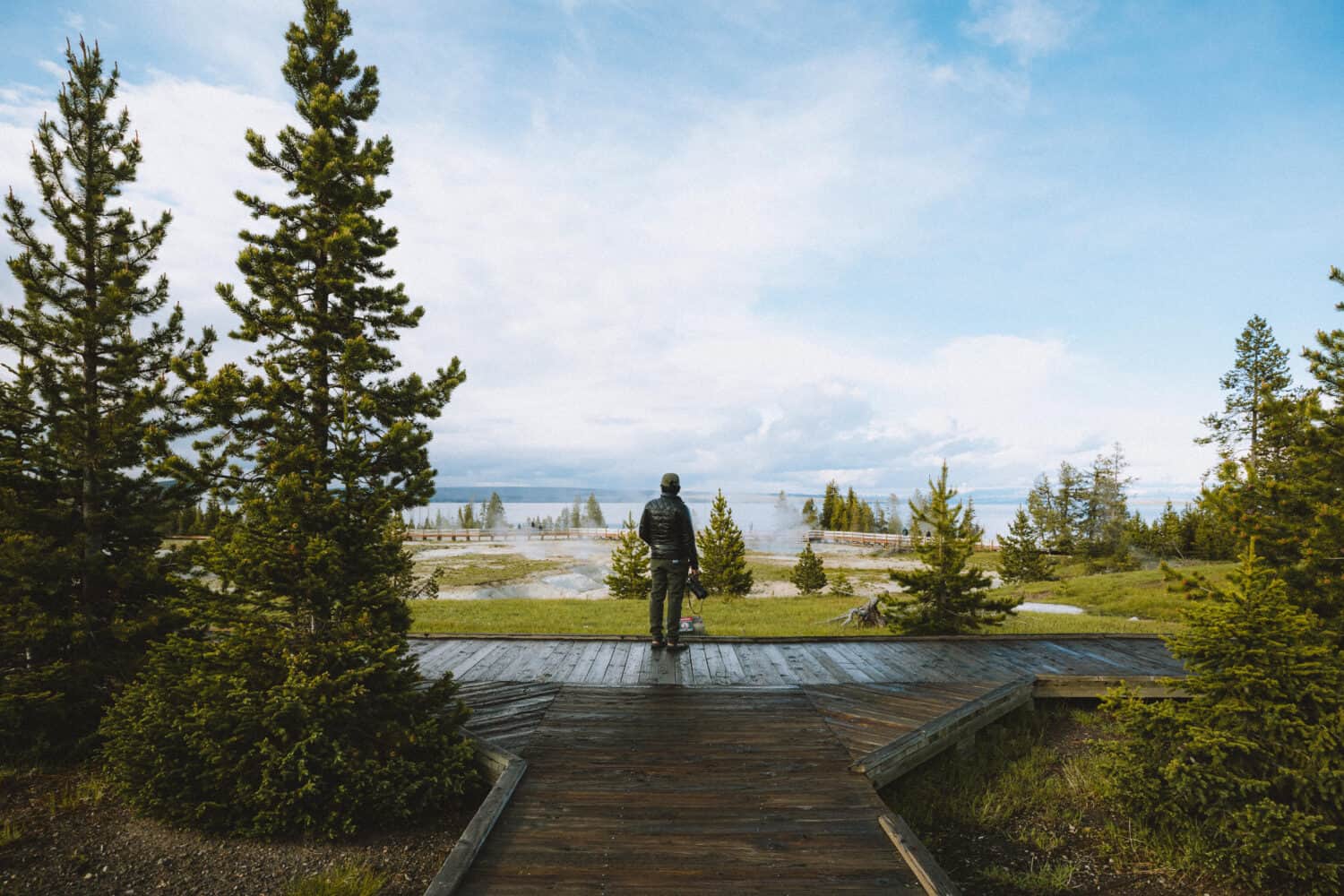
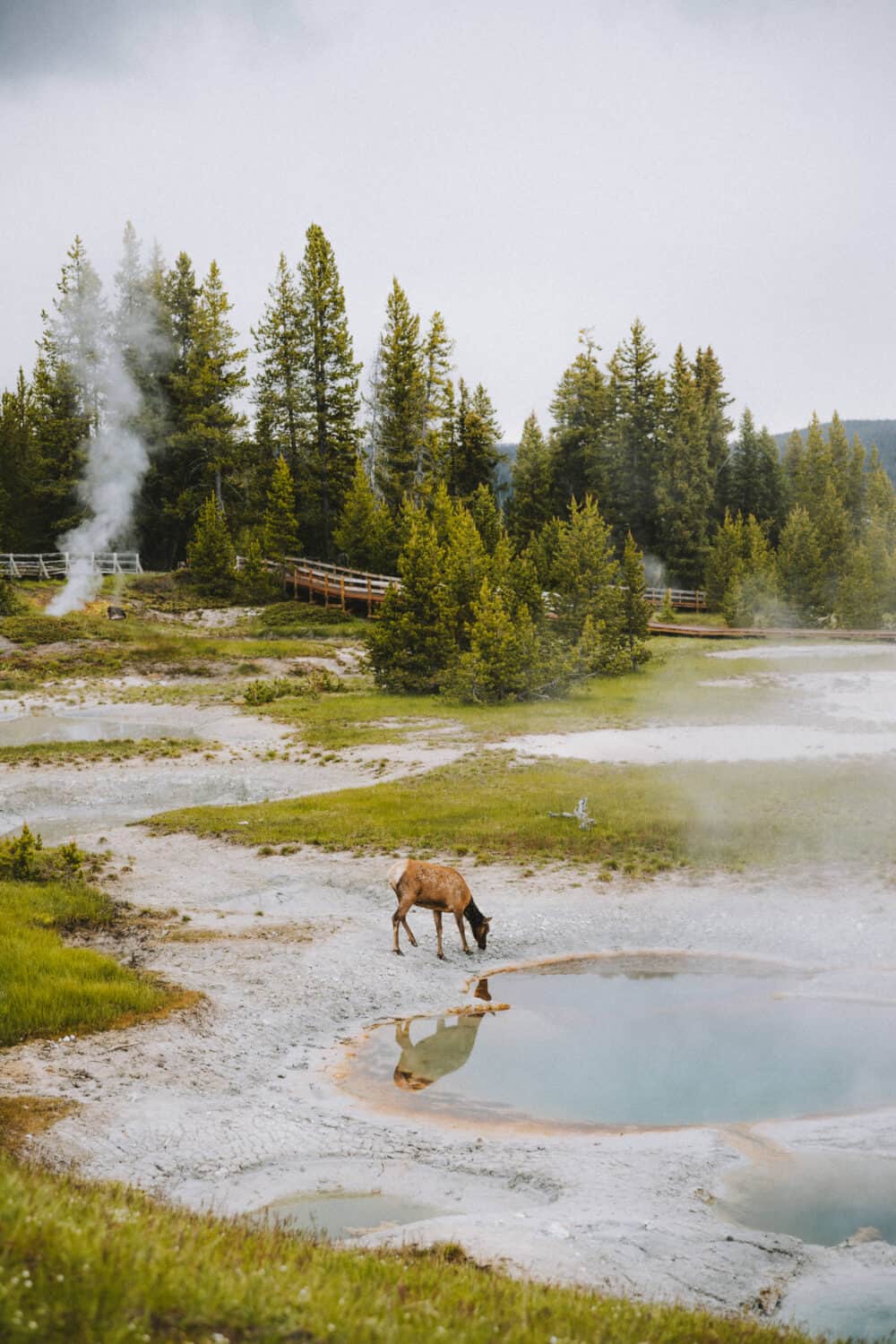
More Things To Do In Yellowstone (North Ring Road + Lamar Valley)
If you’re planning a weekend in Yellowstone, this route would likely be day two of your Yellowstone itinerary.
The North Ring Road includes main attractions like Mammoth Hot Springs and the Lamar Valley, but we’re also going to share some more hidden places in Yellowstone that you should visit.
This route will require a bit more time in the car, so get comfy, pack your road trip essentials, and let’s get reading on what you can see here.
Read More: 101 Road Trip Questions To Ask On Long Drives
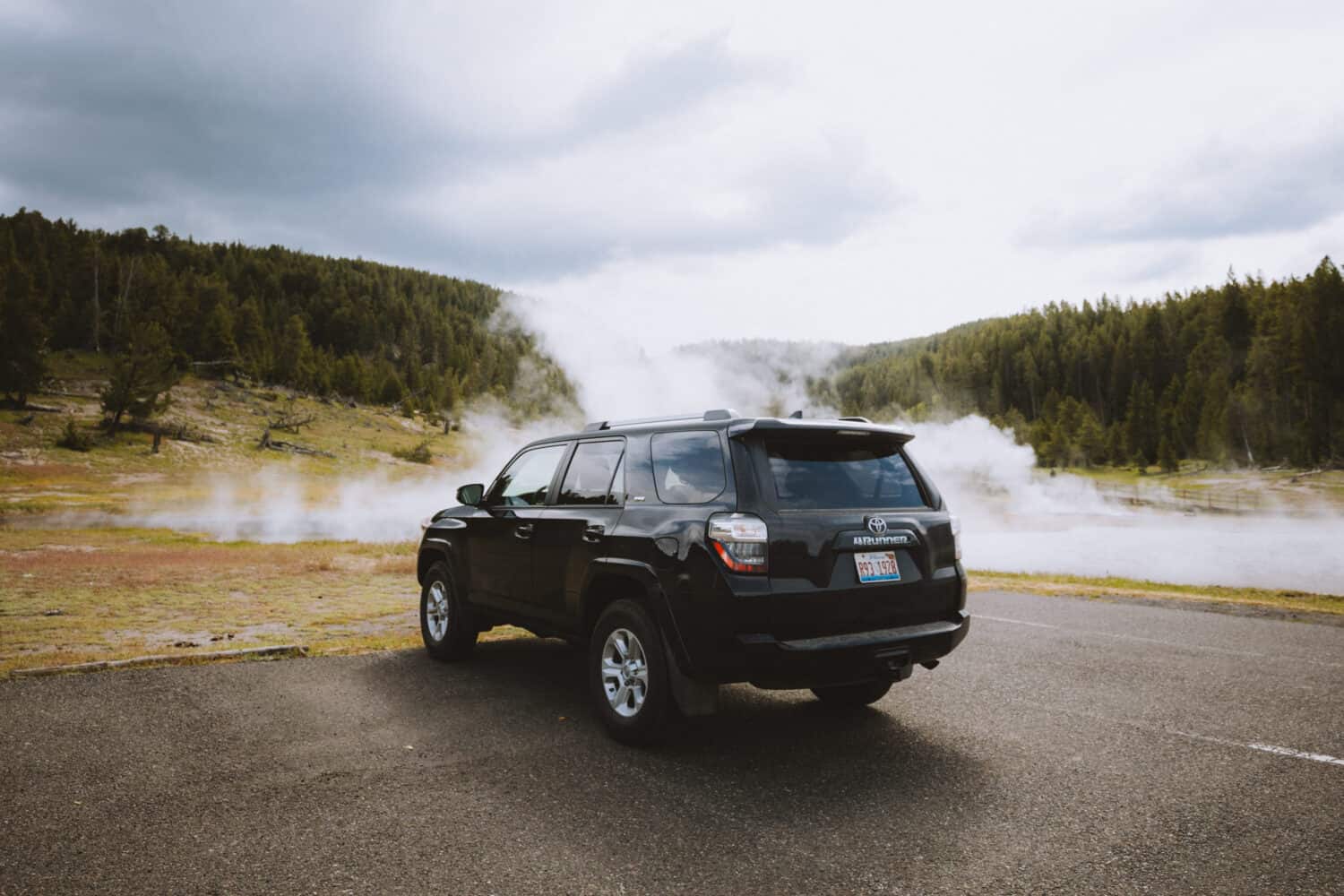
12. Take A Detour Through Firehole Lake Drive
Firehole Lake Drive is a lightly trafficked one-way 3-mile detour between Old Faithful and Madison Junction.
Its purpose is to take you alongside more geysers and hot springs, which are in abundance in this area. You can also take a walk on a boardwalk around Firehole Lake, and warning, it’s STEAMY!
We think this is really one of the most underrated things to do in Yellowstone – many people pass it by but it’s 100% worth a stop!
Here’s a list of thermal features to see on Firehole Lake Drive:
- Firehole Spring
- Firehole Lake
- Great Fountain Geyser (erupts every 8-12 hours)
- White Dome Geyser (erupts every 10 minutes – 3 hours)
- Pink Cone Geyser
- Surprise Pool
- Steady Geyser
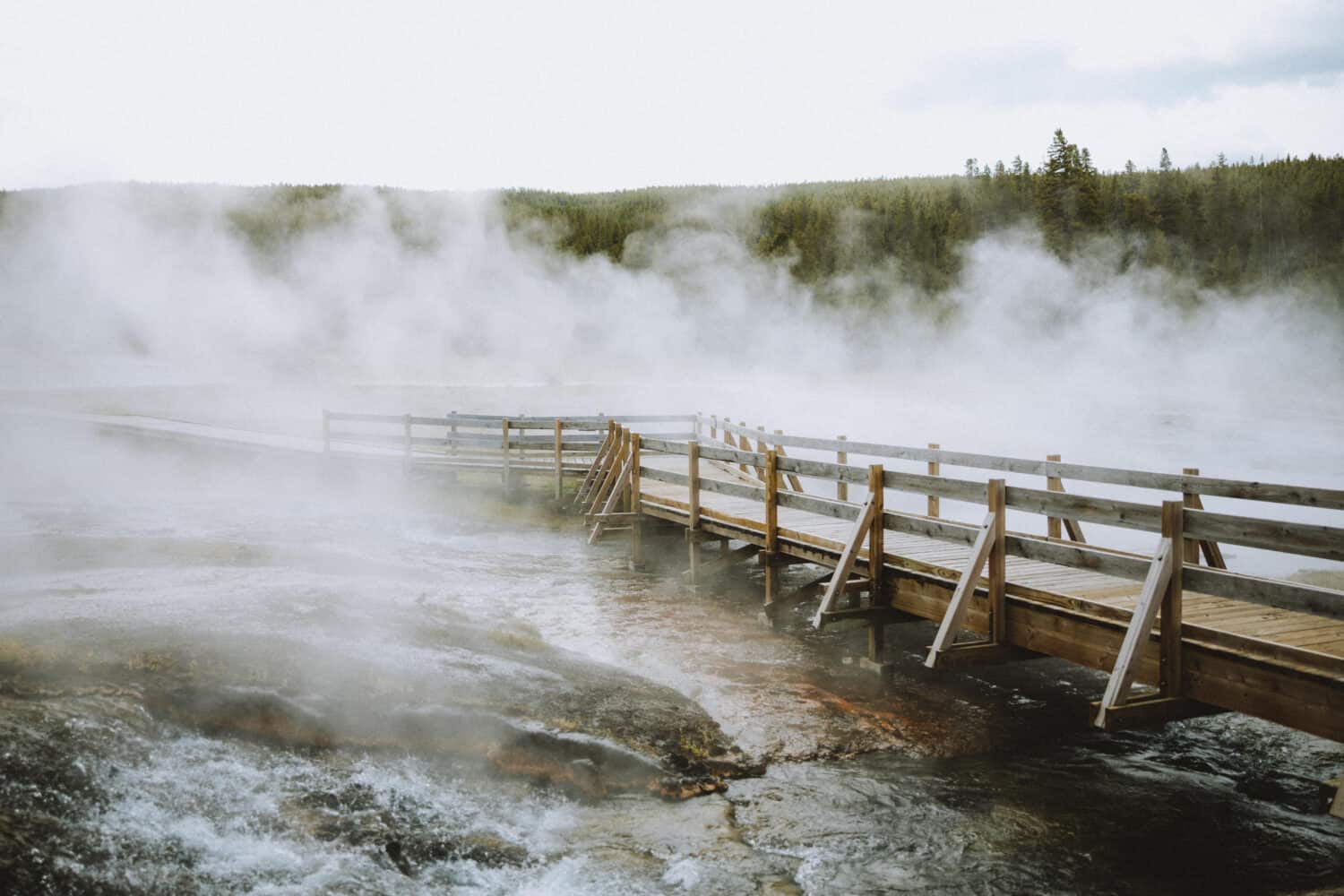
Berty and I were lucky to watch these marmots wrestle around for about an hour. They were so cute and so expressive!
We pulled out our long 100-400mm Canon zoom lens and followed them as they chased each other around the hot springs.
Note: This photo may look like we were close but we were actually pretty far away on the boardwalk! Always remember to use common sense and keep a safe distance from wildlife in the park.
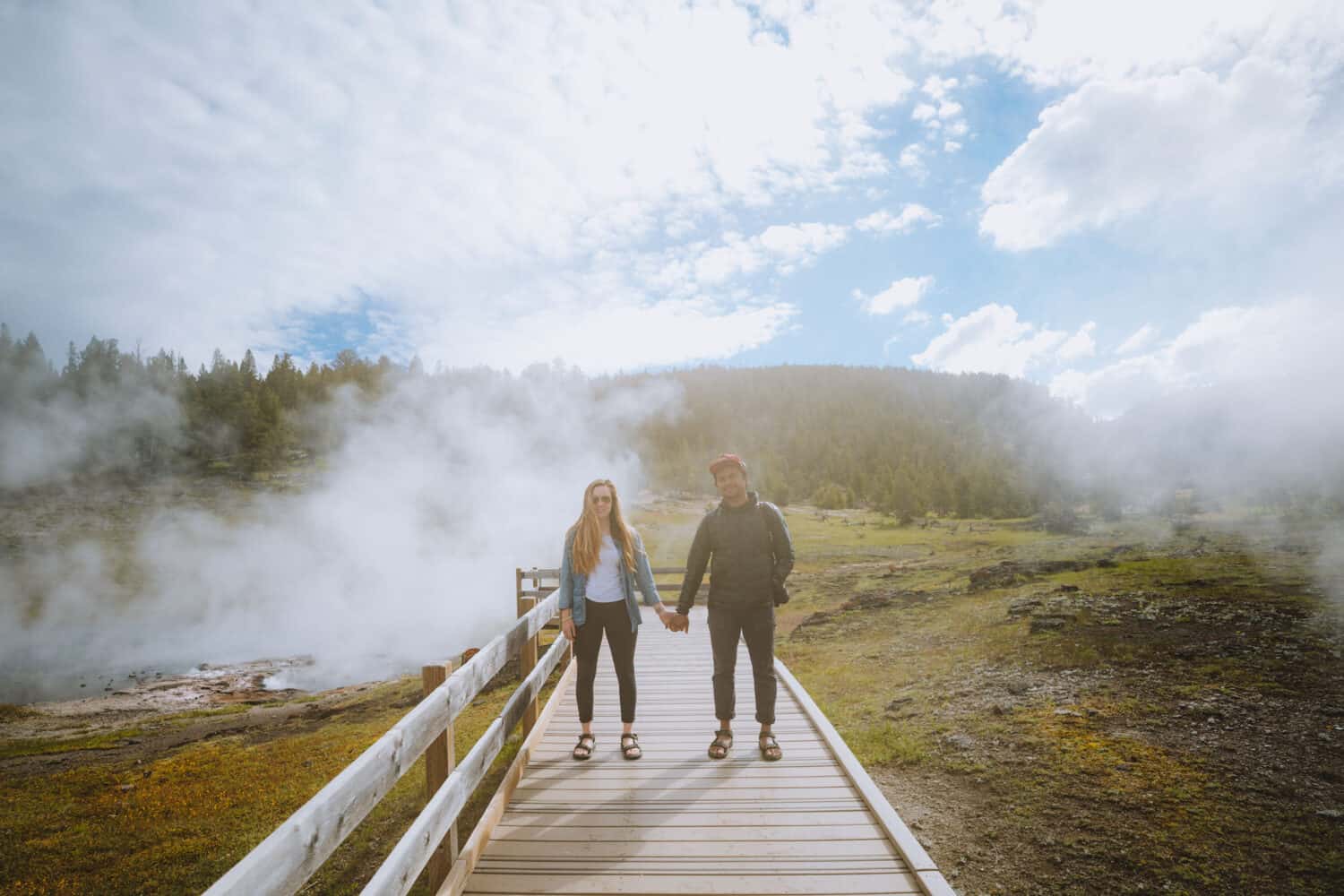
13. Stop For A Quick View of Gibbon Falls
Continuing North on the Grand Loop Drive of Yellowstone, you’ll encounter Gibbon Falls, located in the west-central area of the park.
Gibbon Falls is a waterfall that is 84-feet high and easily accessible roadside. It’s located 4.7 miles south of Madison Junction.
Yellowstone Travel Tip: This is where your patience will be tested – this is a smaller parking lot with a lot of heavy traffic. Be prepared to wait your turn for a spot to park.
See A Similar Waterfall In Oregon: Hike To Diamond Creek Falls
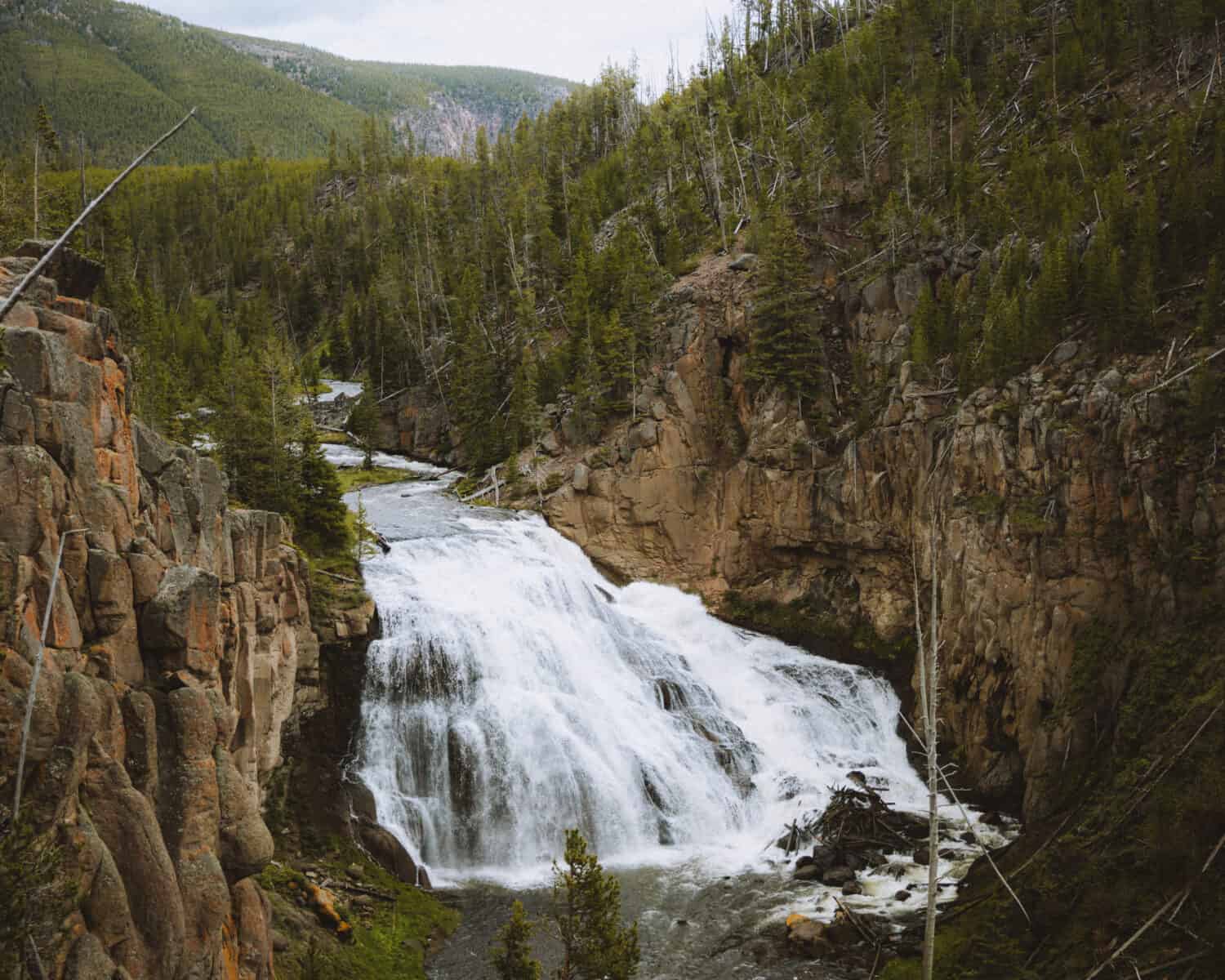
14. Make A Stop At Norris Geyser Basin
Norris Geyser Basin is famous for having the oldest and hottest springs in Yellowstone National Park.
Porcelain Basin and Black Basin are the two walkable zones in the area.
You’ll also find the park’s tallest geyser here – Steamboat Geyser can shoot water up to 400 feet in the air!
15. Explore Mammoth Hot Springs
We first visited Mammoth Hot Springs in the very early spring season – oh how different it looks in the summertime!
Mammoth Hot Springs, located in the northwest area of Yellowstone National Park, is a large complex of hot springs on a hill made of travertine. This place gives off an entirely different vibe in the park – it’s like Mammoth is its own little town!
Here you can find a large visitor’s center (Albright Visitors Center), a cafeteria, multiple restaurants, accommodations, and a ton of houses where employees of the park live.
Town aside, the geological features here are stunning. The Terrace is the most popular Yellowstone attraction in this area, with a series of connecting boardwalks that take you to tons of geysers and hot springs.
The most popular springs in Mammoth are:
- Minerva Terrace
- Palette Spring
- Liberty Cap
- Canary Spring.
Mammoth Hot Springs is alive (as in the colorful bacteria and microbes!) and always changing. Some areas of the park are dried up but were thriving in the 1970s.
We suspect that in 30 years, a new spring will pop up and another will dry up. (Which is a great reason to return and see for yourself!)
See Our First Trip To Mammoth Hot Springs Here!
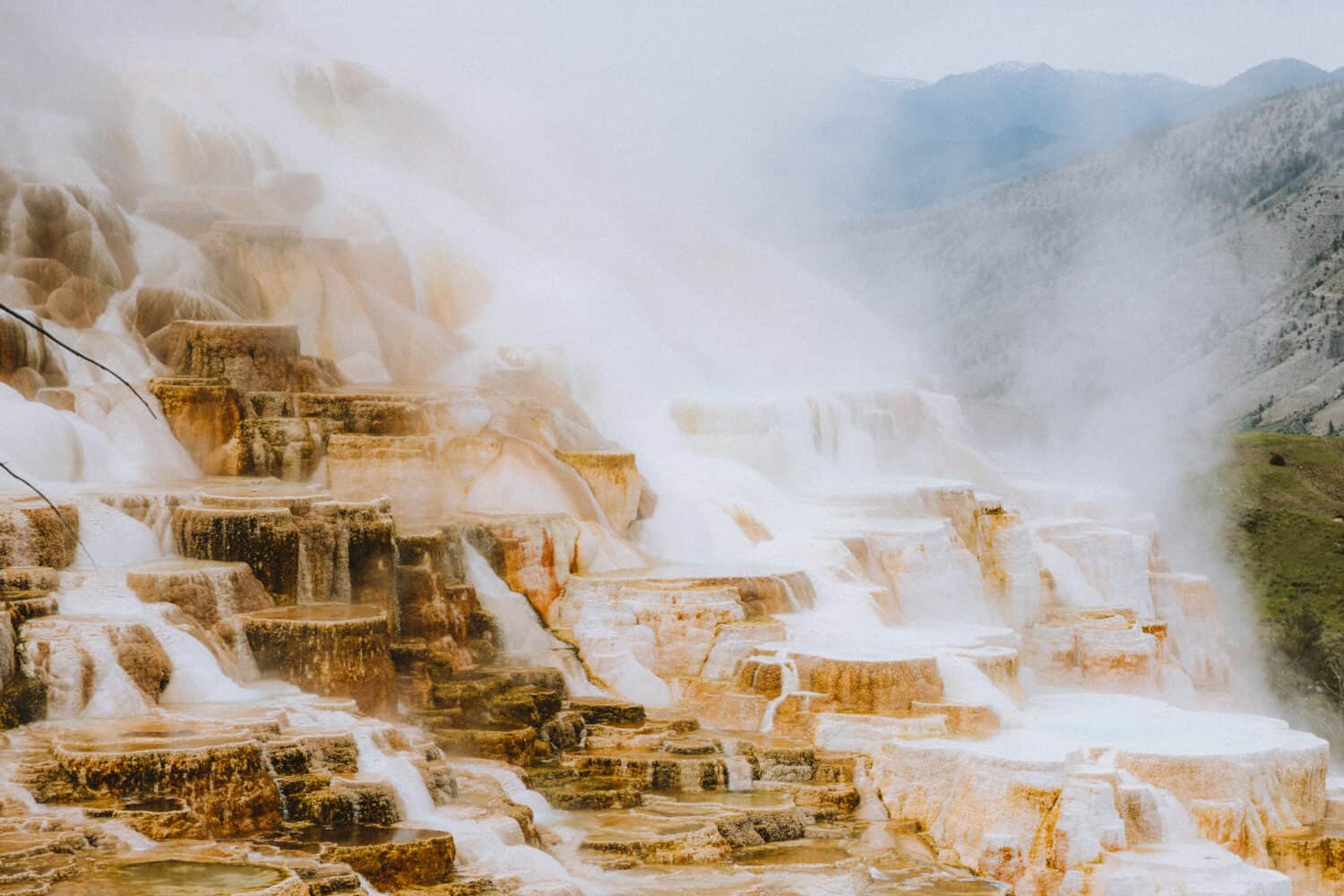
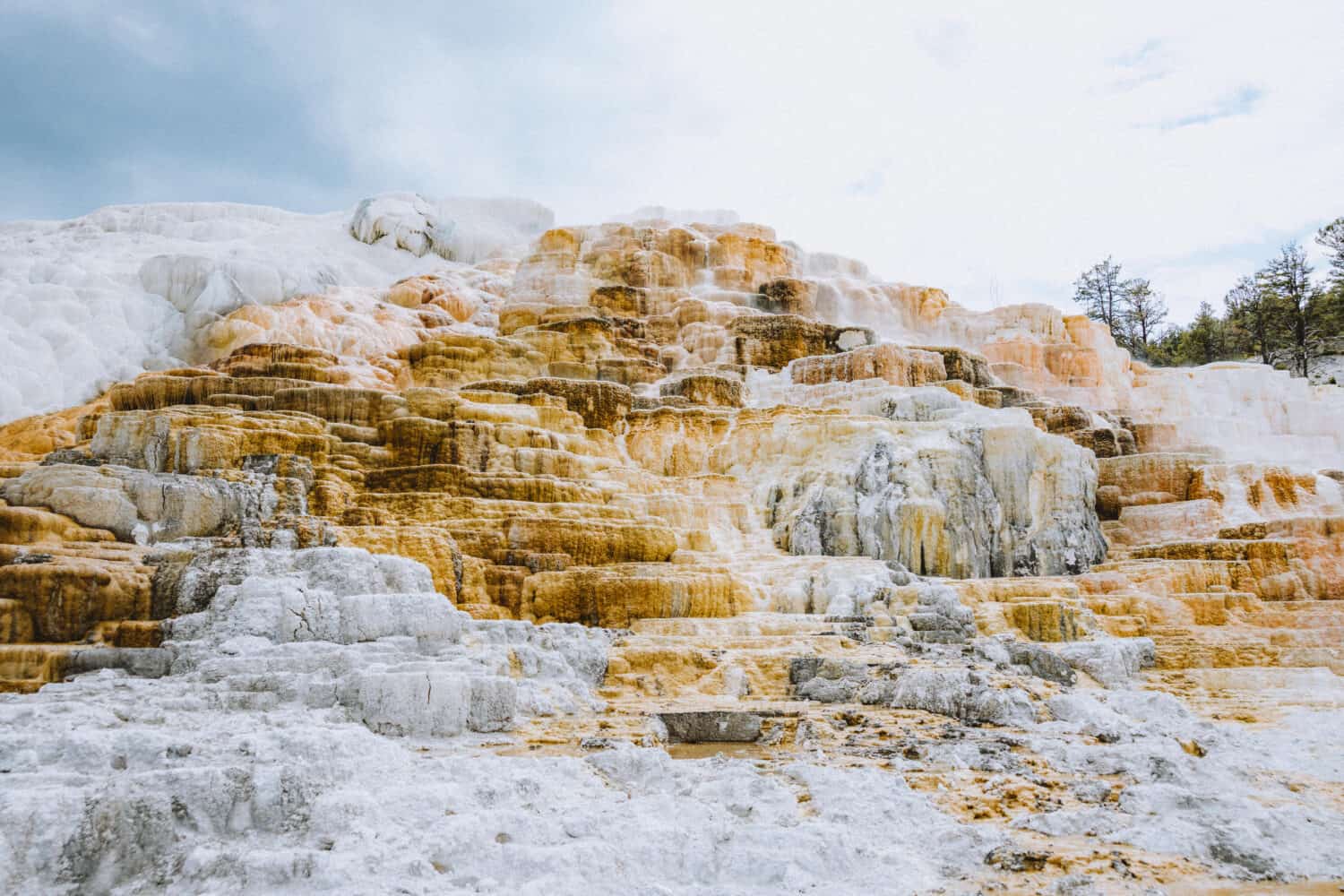
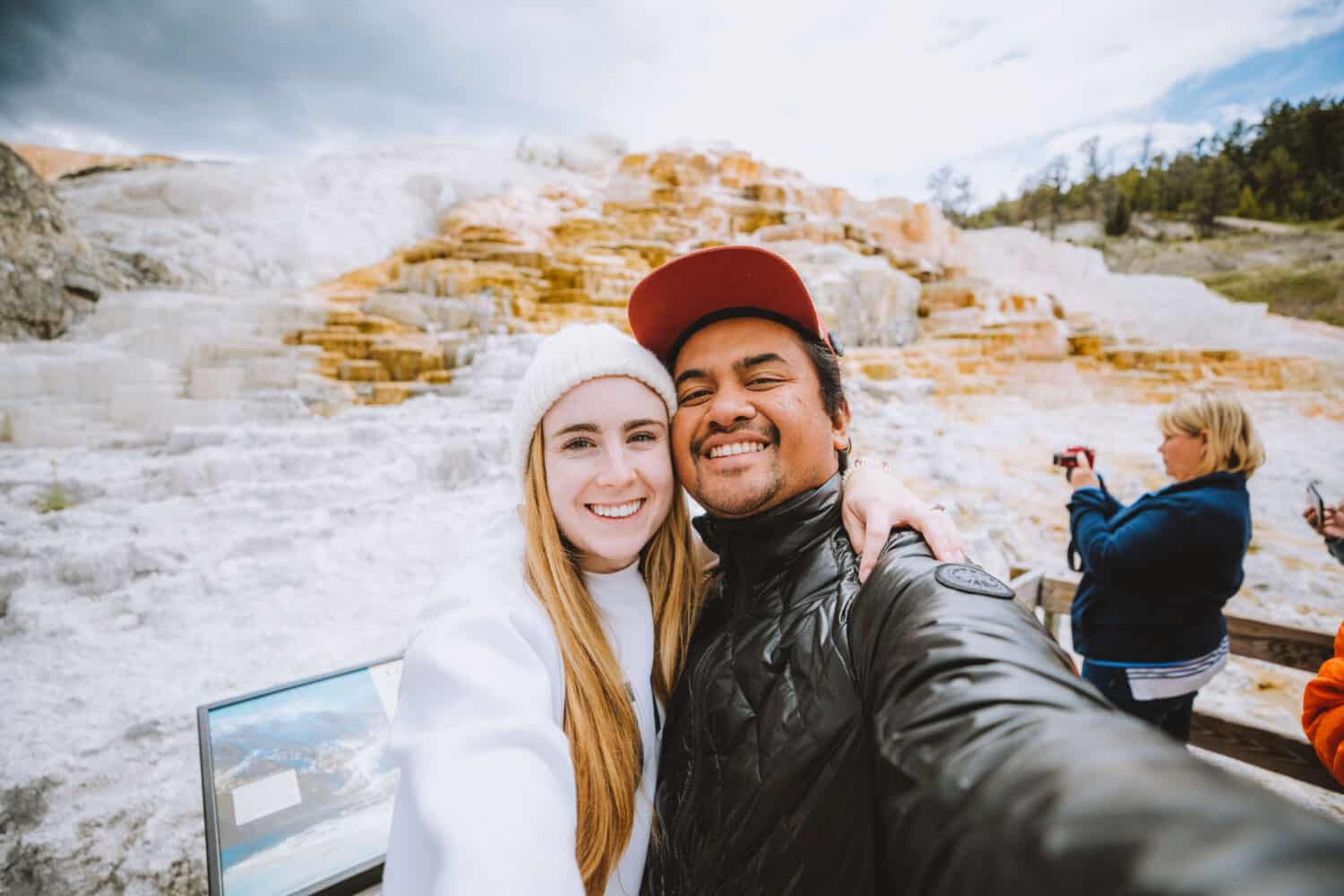
16. Drive Up To Montana And See The Roosevelt Arch
While this isn’t technically in the park, seeing the Roosevelt Arch is definitely worth a detour up to Gardiner, Montana.
The arch was built in 1903 to be a grand entrance on the north side of the park, but now it’s a side detour from the main highway.
The top is inscribed with a quote that reads “For the Benefit and Enjoyment of the People” which we think is an incredibly fitting quote for this amazing park!
Read More: Our Winter Trip To Mammoth and Roosevelt Arch
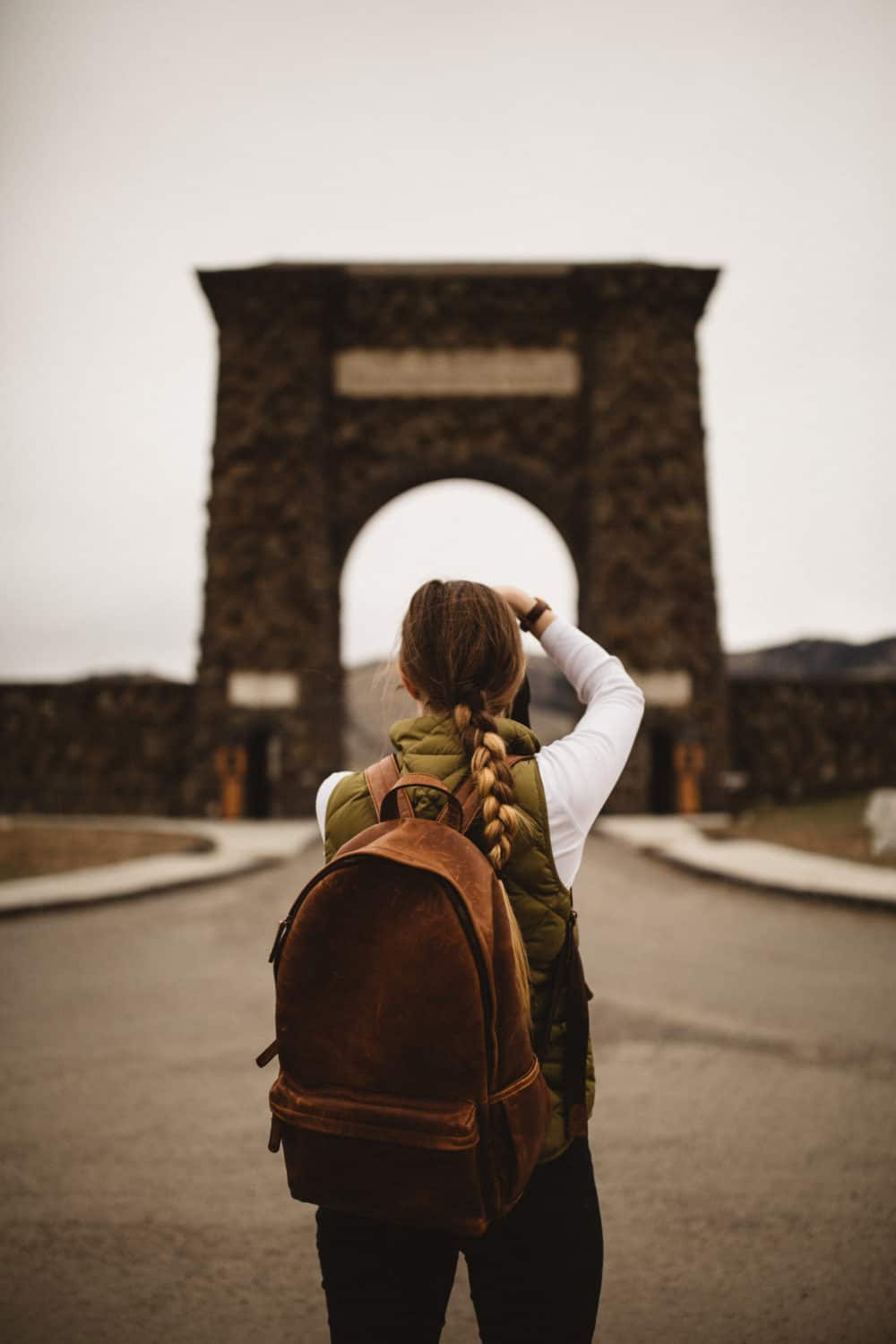
17. Coming To Yellowstone in the winter? Visit The Boiling River!
Make sure to pack your swimsuit and make a point to stop by the Boiling River!
This not-so-secret-anymore spot is where locals and savvy visitors come to the Gardiner River and soak their muscles in the hot water along the banks.
Read More: The Complete 2020 Guide To The Boiling River In Yellowstone
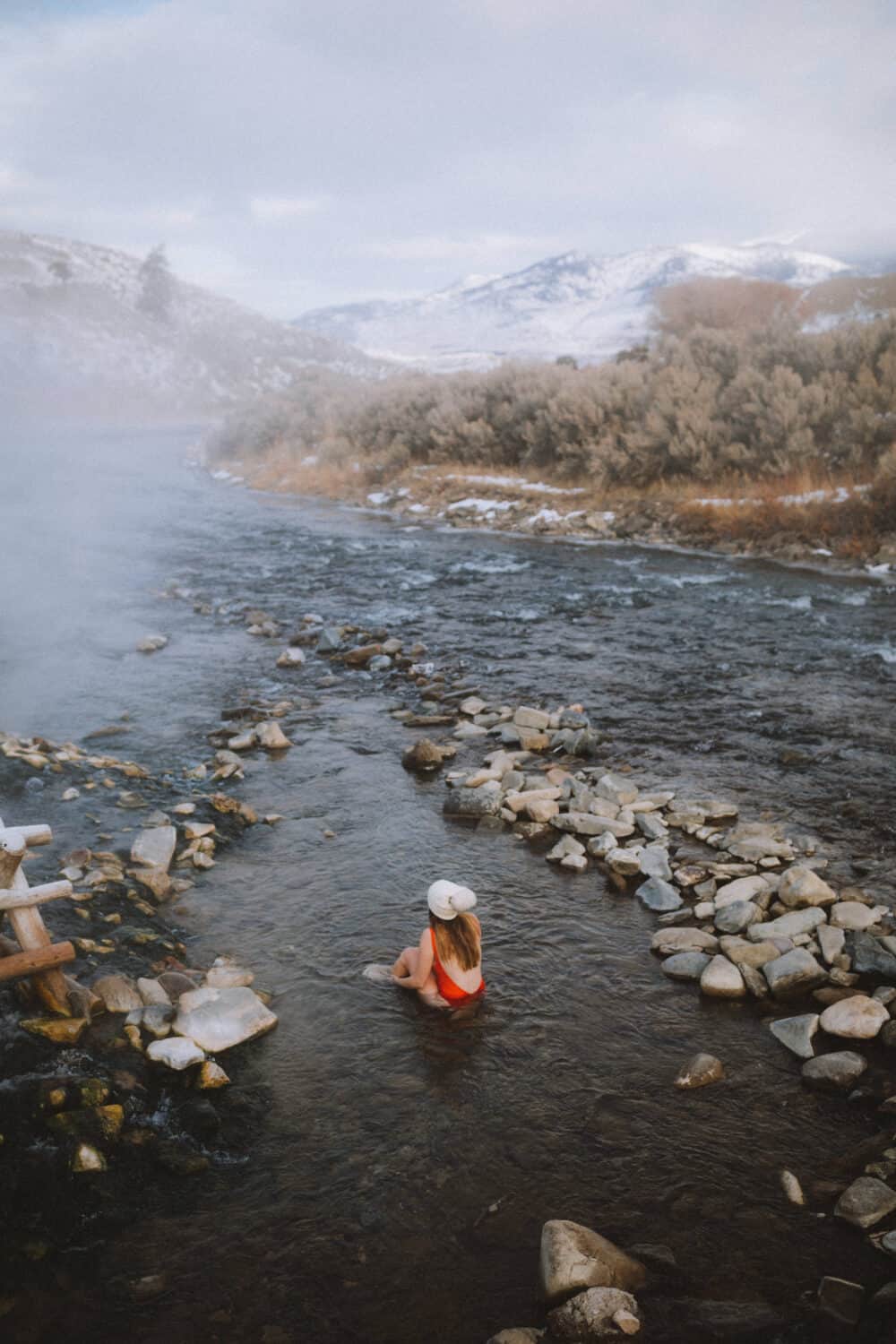
18. Grab Snacks at Tower-Roosevelt
Tower-Roosevelt Junction is a great pit stop to use the restroom, grab a quick snack, and fill up with gas.
From here you can also take a quick drive (2.2 miles) south to view Tower Fall, a 132-foot waterfall. It’s most full in the springtime, but still beautiful year-round!
Forgot Something? Read Our Complete Road Trip Essentials List + Download Your Free Guide Too!
19. Drive Through The Lamar Valley To Spot Bison + Other Yellowstone Wildlife
Located in the Northeast corner of Yellowstone National Park, the Lamar Valley is the ideal location to spot tons of wildlife, including bison, wolves, pronghorn sheep, and bears!
This is one of the few spots in Yellowstone that is open year-round, and you can spot wildlife almost any month of the year.
The highest chance of spotting large groupings would be in the early morning and late evening, when they come out for feeding.
Along this 30 mile stretch of road in Wyoming, there are several pullouts so take advantage of these opportunities to watch out for herds!
Yellowstone Wildlife Viewing Tips:
- Don’t stop on the road. Utilize pullouts – there are a ton so there is no excuses!
- Don’t leave your car, get too close, and NEVER touch animals.
- Again, seriously don’t get close or touch. See this youtube video of a charging bison that injured a family.
- Pack a pair of compact binoculars – we spotted a mama bear and baby cub from far up on the hill this way!
- Taking photos? Pack or rent a zoom lens, specifically one that is at least 100mm. This way you can get close up without physically getting close! We recommend the 100-400mm Canon zoom lens.
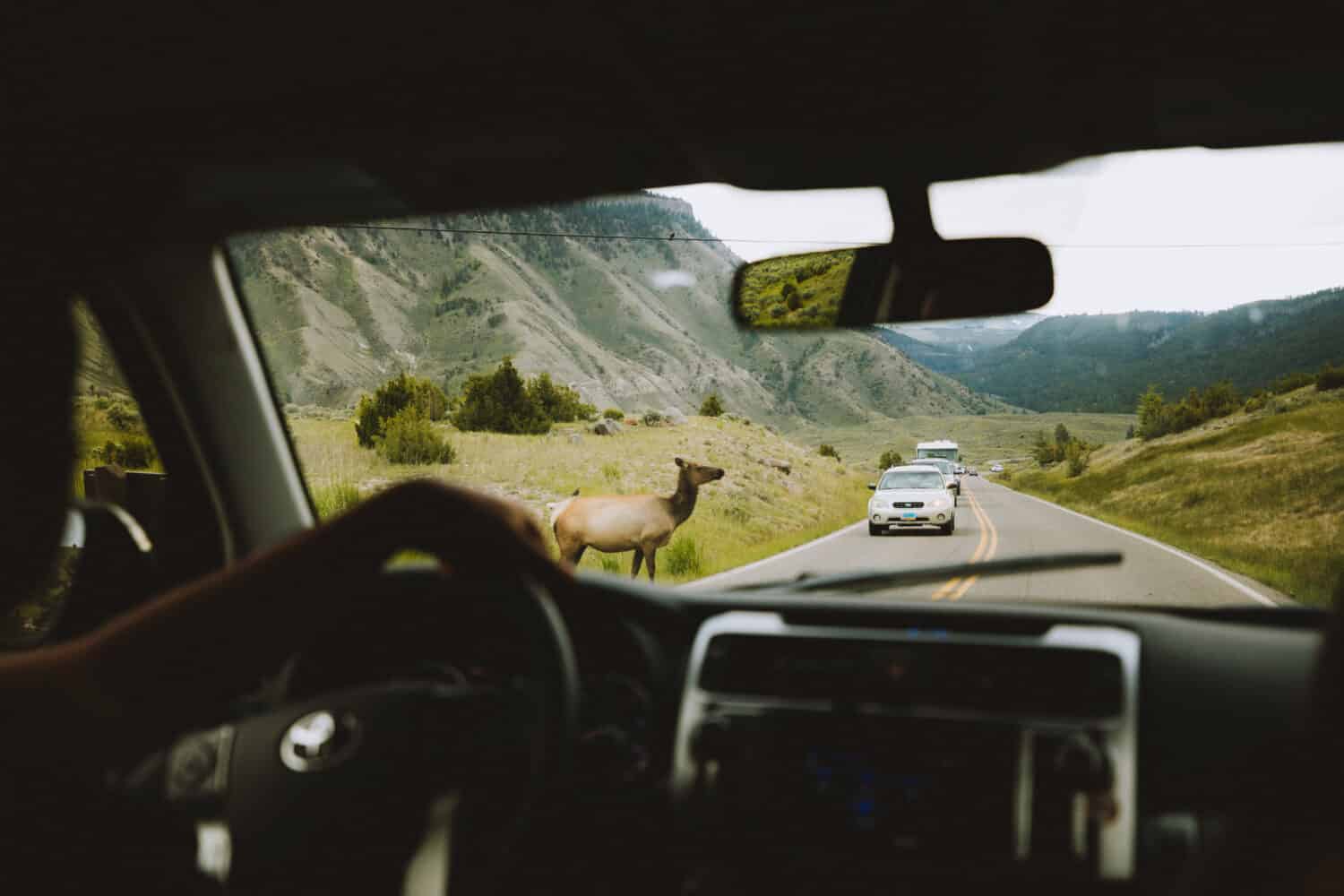
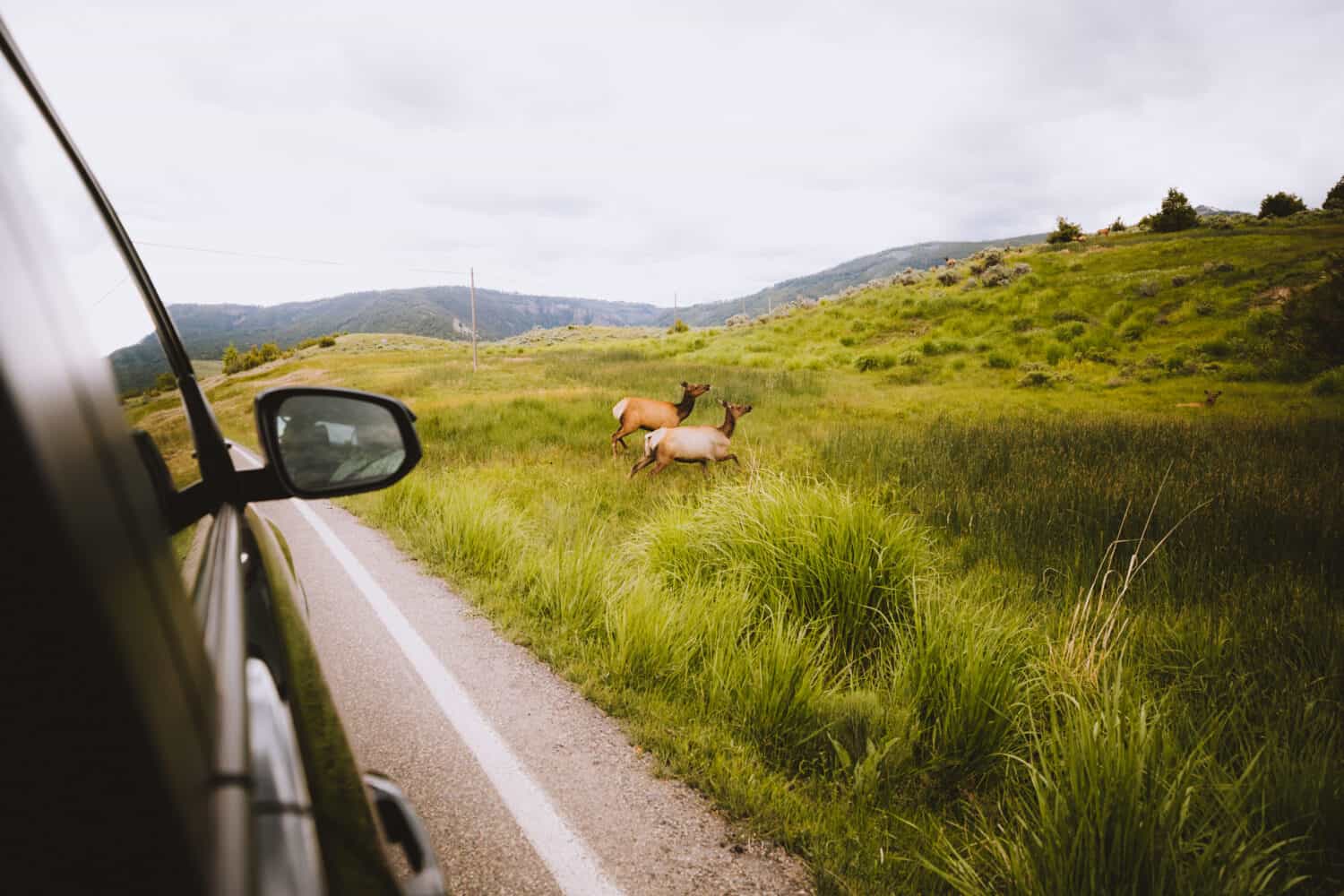
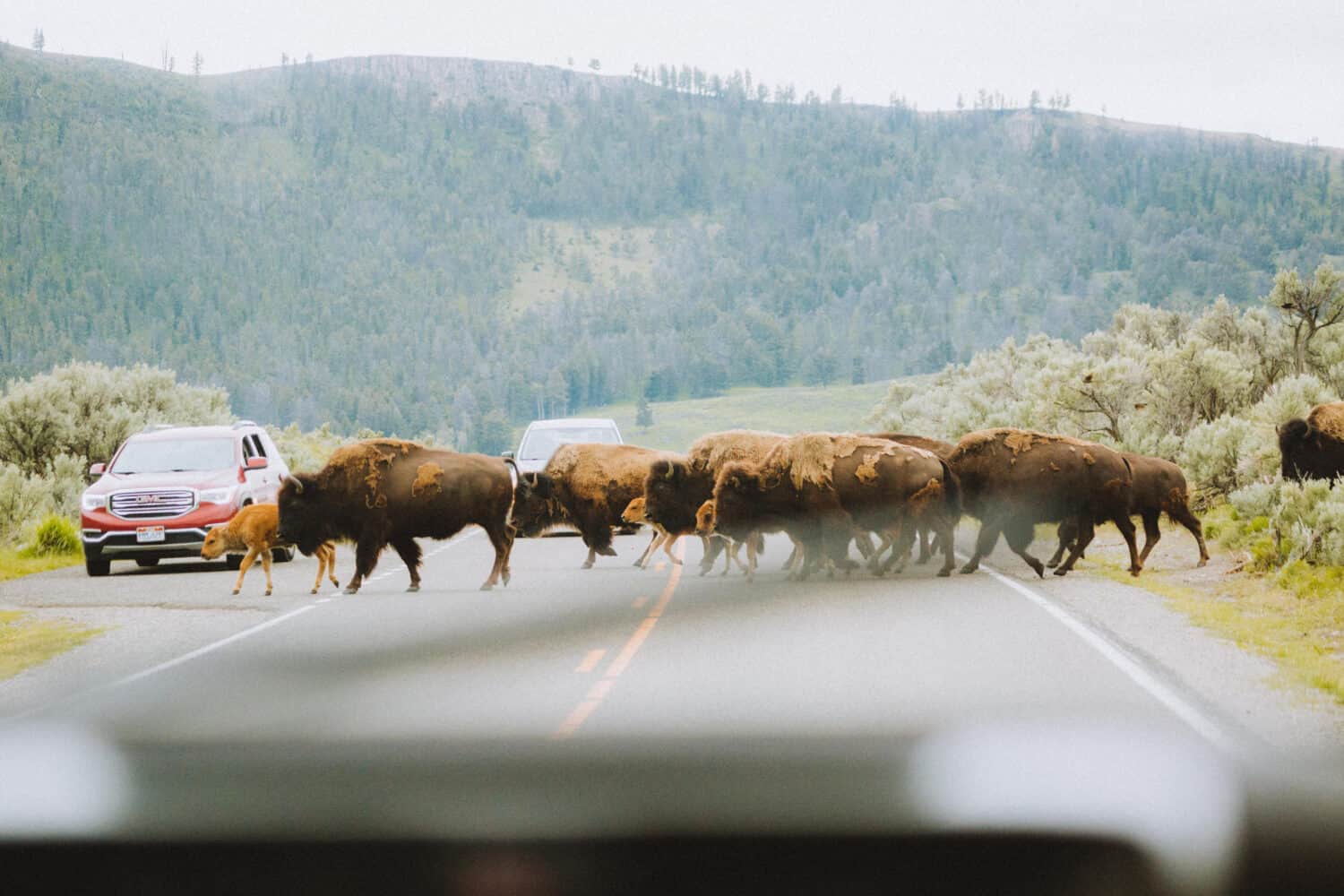
20. Cross Over The Mount Washburn Pass
Continuing on the Grand Loop Highway in Yellowstone, your next destination will be Mount Washburn in Dunraven Pass.
Quick Facts About The Pass:
- The pass reaches 10,245 ft in elevation.
- This road is closed mid-October to late May (or whenever the snow melts!)
You can opt to continue on your way, or stop and take the trail to the highest point in Yellowstone National Park.
The trail takes a bit of preparation before departing though. With 6.4 miles out and back with 1,400 feet of elevation gain, it can be a bit strenuous for the inexperienced hiker.
However, the reward is so sweet when you can look over the beautiful park from the highest point!
Need to stretch your legs more? There are over 900 miles of hiking trails in Yellowstone, including overnight backpacking trails and even visits to fire lookouts!
21. 10 Other Amazing Places To See In Yellowstone
There’s not one blog post or internet search that will cover all the things to do in Yellowstone National Park. The beauty about that though is there will always be an excuse to return for another trip!
Here are some other amazing places to see in Yellowstone if you have some extra time:
- Yellowstone Lake
- Hayden Valley for Bison viewing
- Stay At The Old Faithful Inn
- Grizzly and Wolf Discovery Center
- Museum of the National Park Ranger
- Biscuit Basin
- Thumb Paint Pots
- Petrified Tree In Yellowstone
- Undine Falls (near Mammoth Hot Springs)
- Morning Glory Pool
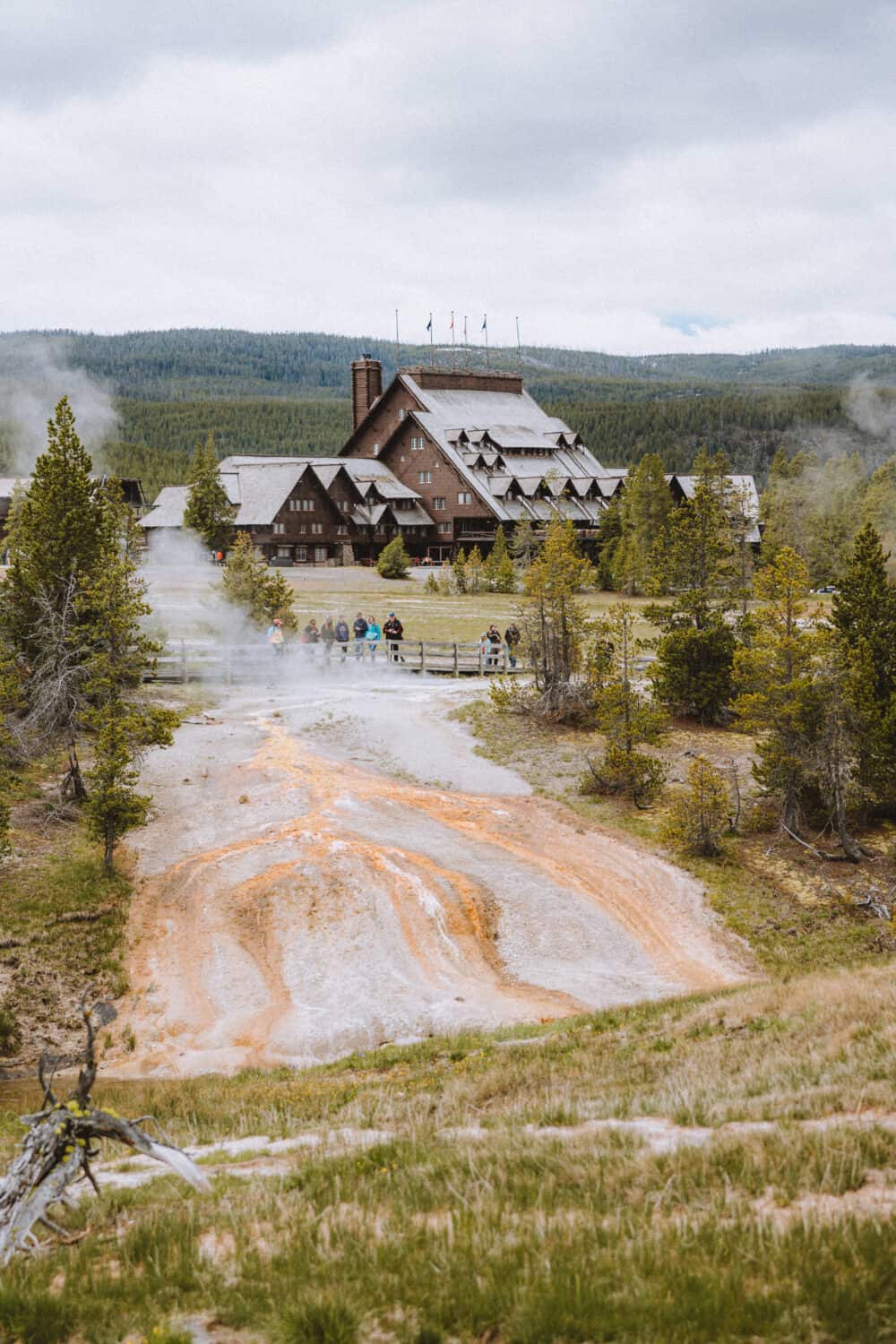
Places To Stay In Yellowstone National Park
Because this is one of the most popular national parks in the United States, there are many Yellowstone lodging options to choose from.
However, it’s important to book your Yellowstone accommodations early because they fill up fast!
We’ve compiled this list of where to stay in Yellowstone to help you choose the right accommodations for your budget.
Budget-Friendly Yellowstone Accommodations:
Your best option for saving money and staying near or in the park would be to go camping in Yellowstone. Here are the 12 most popular campsites and their nearest attractions:
- Bridge Bay Campground (Yellowstone Lake)
- Canyon Campground (Grand Canyon Of The Yellowstone)
- Fishing Bridge RV Park (Yellowstone Lake)
- Grand Village Campground (West Thumb Geyser Basin)
- Indian Creek Campground (Mammoth Hot Springs)
- Lewis Lake Campground (Lewis Falls)
- Madison Campground (Grand Prismatic – Midway Geyser Basin)
- Mammoth Campground (Mammoth Hot Springs)
- Norris Campground (Norris Geyser Basin)
- Pebble Creek Campground (Lamar Valley)
- Slough Creek Campground (Lamar Valley)
- Tower Fall Campground (Tower Fall, Lamar Valley)
Click here to see Yellowstone campsite availability and their locations on the map.
The benefit of camping in Yellowstone is that they are inexpensive and centrally located! If you are planning a Yellowstone road trip and have the ability to pack camping gear, we think this is the best way to explore the park.
Hotels Near Yellowstone (Outside The Park):
If you are planning to travel to other places besides Yellowstone, it may be more cost-effective to book a place to stay near Yellowstone. Here are the closest towns to book a hotel in:
- West Yellowstone (closest to the West Entrance and Norris Hot Springs)
- Gardiner, Montana (closest to Mammoth Hot Springs)
- Jackson, Wyoming (closest to Lewis Falls and West Thumb)
- Cook City, Montana (closest to the Beartooth Highway and the Lamar Valley for wildlife spotting!)
Click here to see a list of all the places to stay in and around Yellowstone National Park!
Hotels IN Yellowstone (if convenience is a priority):
The Yellowstone Lodge is open for reservations up to 18 months before your trip.
There are nine official lodges to choose from:
- Lake Yellowstone Hotel & Cabins
- Canyon Lodge & Cabins
- Mammoth Hot Springs Hotel & Cabins
- Old Faithful Snow Lodge & Cabins
- Old Faithful Inn
- Old Faithful Lodge Cabins
- Grant Village
- Lake Lodge & Cabins
- Roosevelt Lodge & Cabins
Click here to see a list of all the places to stay in and around Yellowstone National Park!
Yellowstone Itinerary Map
Want to see all these locations in a visual Yellowstone map? Click the map below to help you plan your epic Yellowstone itinerary!
Frequently Asked Yellowstone Questions
Didn’t find your answers in the post above? Here are some of the most common questions about this epic national park. Hopefully, this gives you more clarity on your upcoming Yellowstone road trip itinerary!
We’re sharing our tips for planning a trip to Yellowstone, and hacks to make the most of your precious and short days in the park!
When Is The Best Time to Visit Yellowstone?
The most popular time to visit Yellowstone is in the summer months, June through September. It’s also when most of these iconic road trips on the west coast are free of snow and easy to navigate!
The crowds usually consist of road trippers, families on summer vacation, and many people that make Yellowstone a bucket list destination! However, with this park being so popular, it also means that it can get very very busy.
We think the best time to visit Yellowstone is in the shoulder seasons, but just barely. We think that early June and early October is the best time to plan your trip to Yellowstone.
These times of the year will give you the most access to the park (many roads are closed in the winter).
These times also tend to bring fewer crowds, and the wildlife is still around before their winter hibernations.
However, if your time constraints limit you to visiting Yellowstone in the summer months, here are a few tips to seeing places with fewer people around:
- Visit the park early (like 5:00 am!), and find a spot to enjoy the sunrise!
- Stay in the park late! Most families will be in by dinnertime and the crowds will be smaller than they are in the daytime.
- Explore the less-visited areas of the park, like Mount Washburn and longer backpacking trails.
How Many Days In Yellowstone Should I Plan To Visit?
This is up to you and your group, but we believe you can see the highlights with just 2 to 3 days in Yellowstone.
The main attractions in Yellowstone that were covered above can easily be seen in two or three days in the park!
How Long Does It Take To Drive Through Yellowstone?
The Grand Loop Road is 142 miles (230 km) long. This road will take you to all the best stops in Yellowstone.
It’s possible to drive the entire route in one day, but this will probably take you anywhere from four to eight hours without stopping! To enjoy the trip a little bit more, we definitely recommend breaking up your trip into two days at least.
Note: The top speed within Yellowstone National Park is 45 miles per hour. It may be slower in heavily populated areas – keep an eye out for that speed change.
What If I Only Have One Day In Yellowstone?
If you only have 1 day in Yellowstone, we recommend driving the south ring road. The Grand Loop Road of Yellowstone is shaped like a figure eight.
The southern part of the loop includes the majority of the popular locations in Yellowstone. Drive this for a short and quick but amazing drive through the park.
Top 10 Things To Do In Yellowstone?
Oh man, breaking down the top ten things to do in Yellowstone is a difficult feat! There are so many incredible places for so many different reasons.
Here are our top 10 things to see in Yellowstone:
- Old Faithful
- Grand Prismatic
- Mammoth Hot Springs
- Lamar Valley
- Artist Point
- Norris Geyser Basin
- West Thumb Geyser Basin
- Upper Geyser Basin
- Tower Fall
- Yellowstone Lake
Will I See Wildlife In Yellowstone National Park?
While we can never make guarantees, we can confidently say that there will be a high chance of you observing wildlife in Yellowstone.
The park does an incredible job of preserving their natural habitat. You can visit any Yellowstone Visitors Center and ask about recent wildlife sightings, and the best place for viewing them.
That being said, it’s important for you to play your part too! Make sure you stay at least 100 feet away from wildlife, and at least 300 feet from predators like wolves and bears.
What Are The Entrances To Yellowstone National Park?
There are five entrances to Yellowstone National Park. There isn’t a “best” one to enter as this is all up to where you will be coming from!
Here are the closest towns and attractions to each gate:
- North Entrance: Gardiner, Montana (Nearest Yellowstone Attraction: Mammoth Hot Springs)
- Northeast Entrance: Cooke City, Wyoming (Nearest Yellowstone Attraction: Lamar Valley)
- East Entrance: Cody, Wyoming (Nearest Yellowstone Attraction: Yellowstone Lake)
- South Entrance: Jackson, Wyoming (Nearest Yellowstone Attraction: Lewis Falls, West Thumb)
- West Entrance: West Yellowstone, Montana (Nearest Yellowstone Attraction: Norris Hot Springs, Grand Prismatic Spring)
Will There Be Cell Service In Yellowstone?
You may find that some cell providers will have limited reception in the main areas of the park. (Old Faithful, Canyon Village, Mammoth Hot Springs Village).
However, there is a very high chance that you’ll be out of cell service range.
We suggest downloading an offline map from Google if you’d like accessible navigation during your Yellowstone road trip.
Read our post on road trip planner tools where we show you how to download offline maps for your adventures!
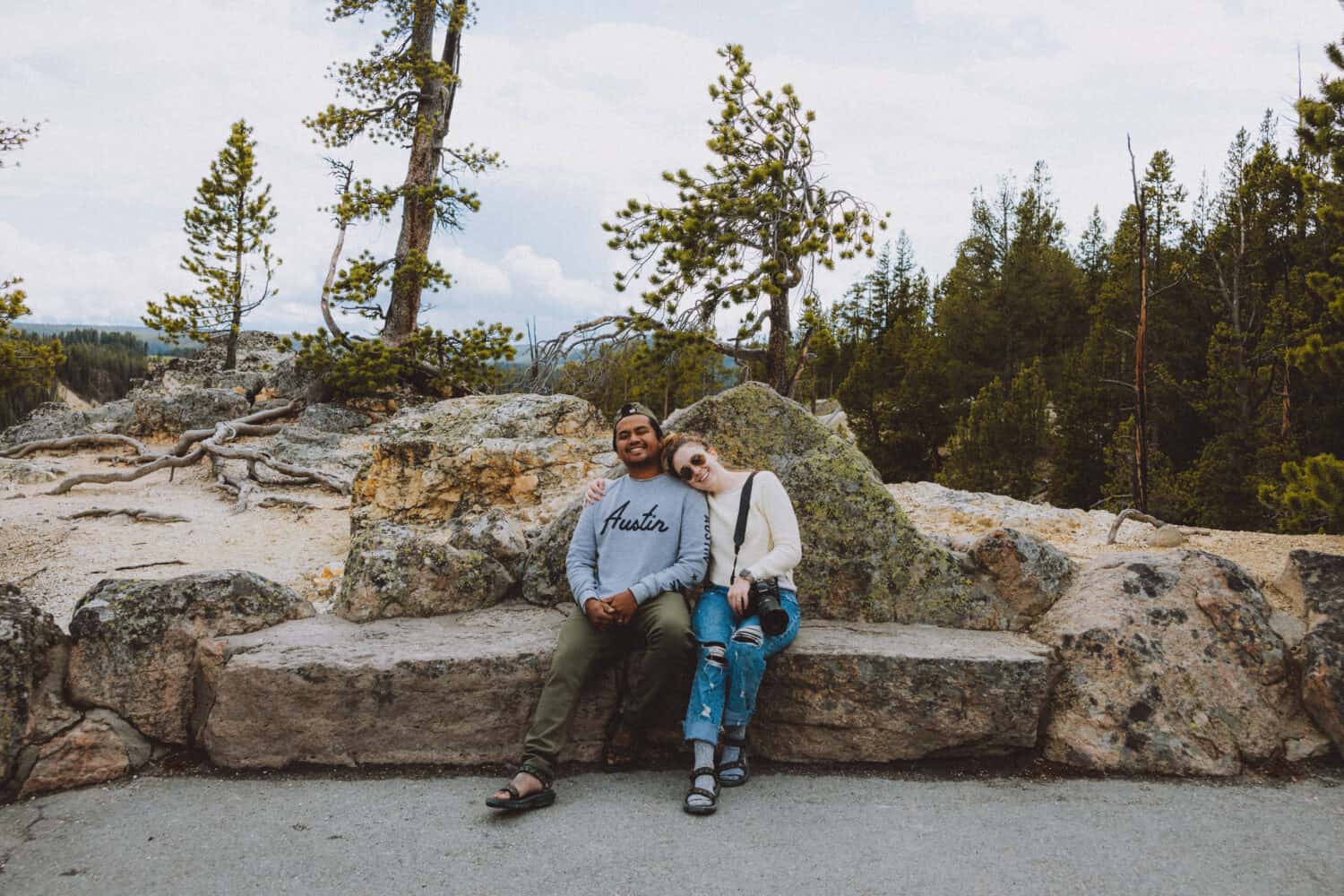
You Made It To The End!
How did you like our guide to Yellowstone National Park? We love returning to this park and seeing new and beautiful areas.
We hope this guide can help you plan your own trip to Yellowstone and help you create epic memories with the people you love!
Berty and I live close to Yellowstone now, so join our community of over 10,000 Instagram friends and catch our stories for the next time we visit Yellowstone!
We hope you liked our list of the best things to do in Yellowstone! If you love this guide, let us know and tag us in your Yellowstone photos on Instagram with @themandagies and #themandagies!
More Adventures Near Yellowstone
Things To Do In The Grand Teton National Park During Winter
Amazing Bozeman, Montana Winter Actitivies To Do This Season
Hike String Lake Trail In Grand Teton National Park
Fly Over The Tetons With Fly Jackson Hole
Amazing Idaho Hot Springs You Need To Experience
